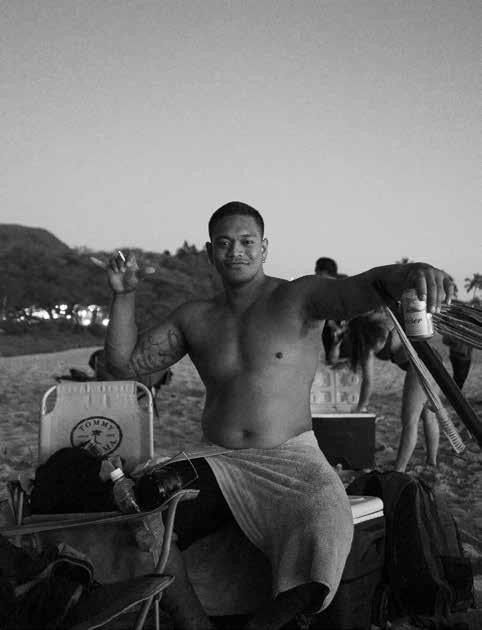

18 | ARTS & CULTURE
The cosmically Black figures of Mark “Feijão” Milligan II, Joseph Han’s debut voice, and weaving legacies with Kekai Naone.
62 | FEATURES
How cartography secretly shapes politics, Josiah Patterson’s spectral images, and the keepers of Kaiser’s.

122 | EXPLORE
Where the kua‘āina lifestyle persists, and an enlightening journey to Kumukahi.
FALL/WINTER 2022 0 03 > 09281 $14.95 US $14.95 CAN 254898 The CURRENT of HAWAI‘I
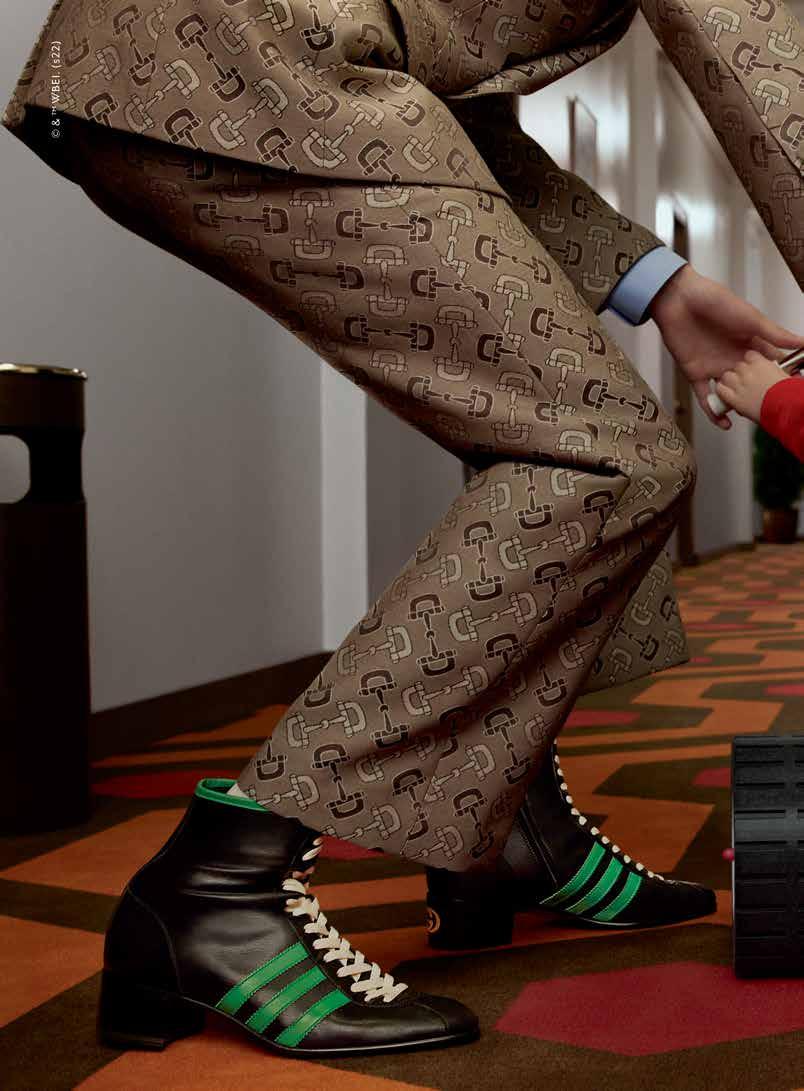
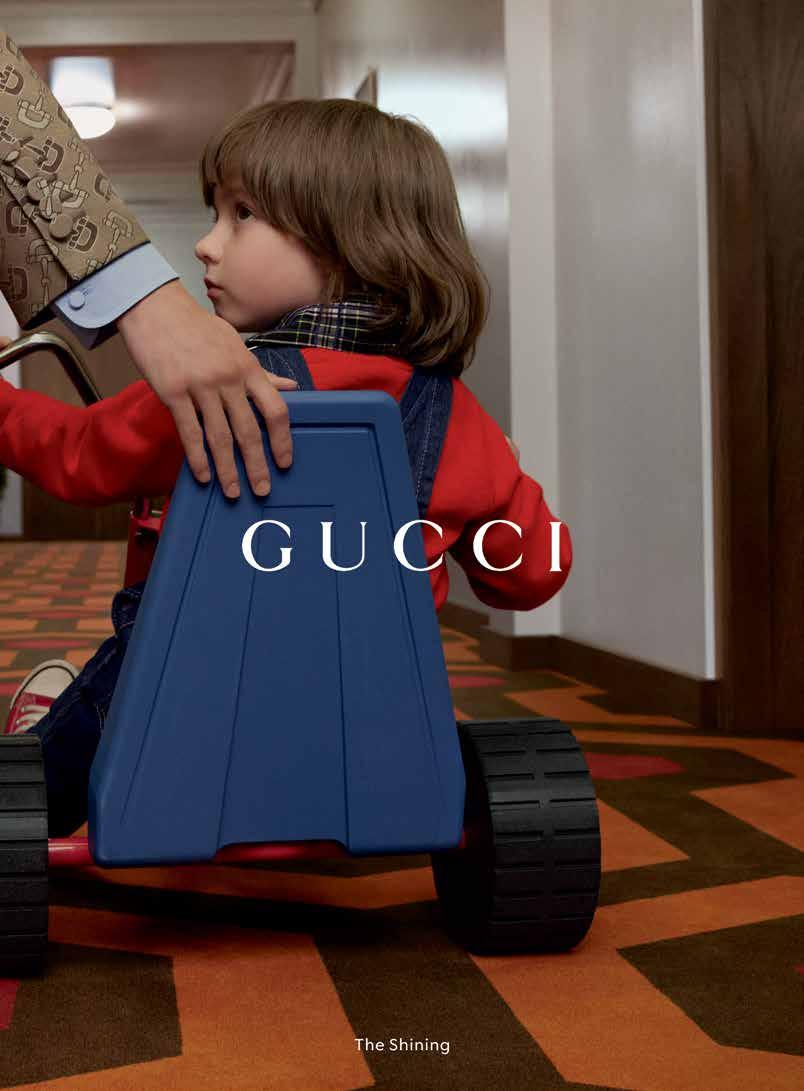


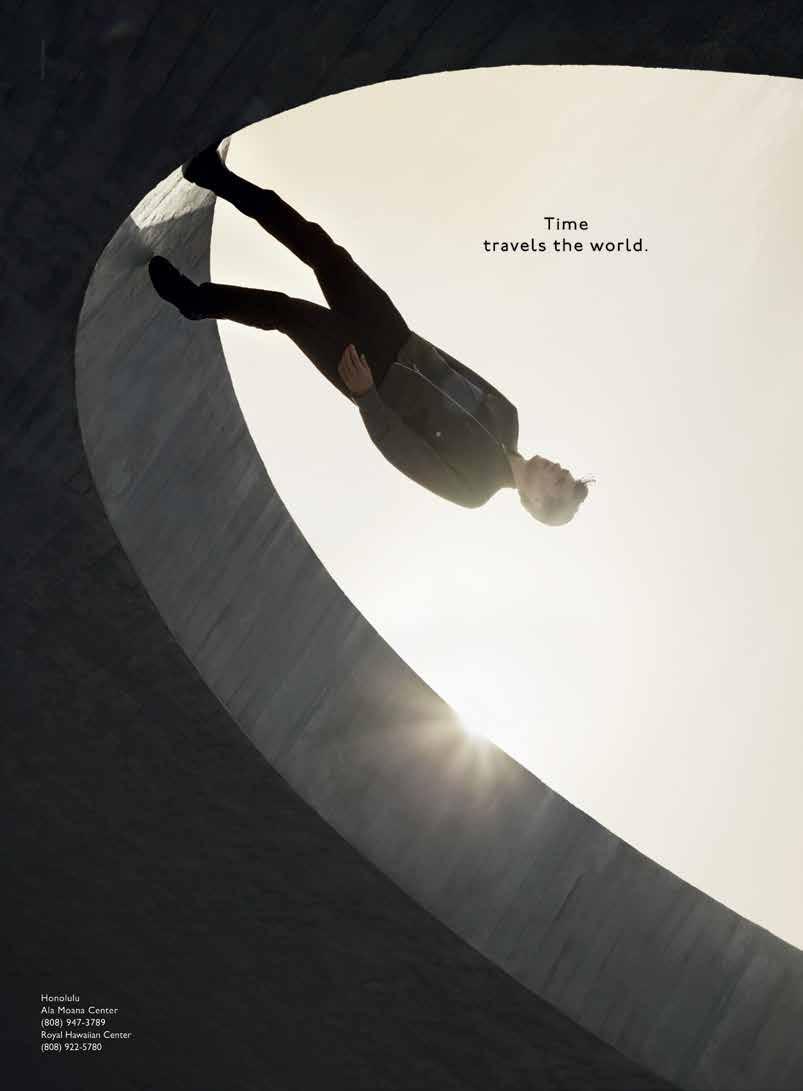
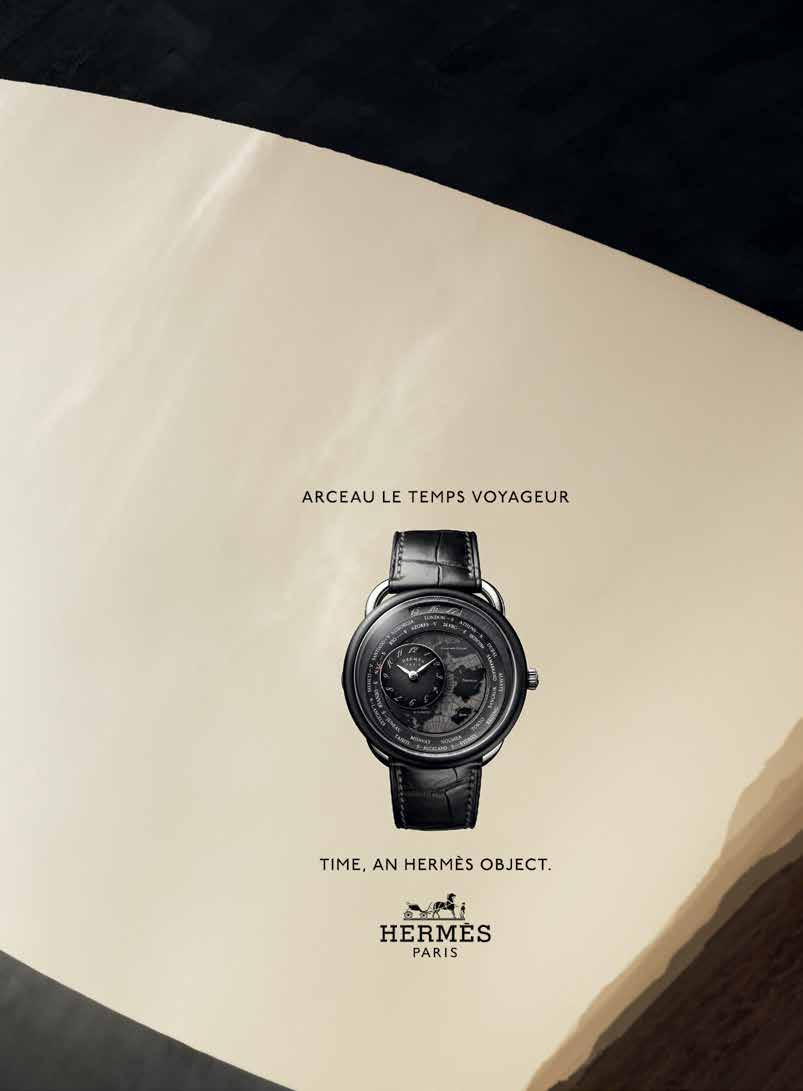
TABLE OF CONTENTS
FEATURES|
FLUX PHILES
20 | Painting
Mark “Feijão” Milligan II
30 | Literature
Joseph Han
38 | Lau Hala
Kekai Naone
48 | Film
Christopher Makoto Yogi
A HUI HOU
150 | Cerulean
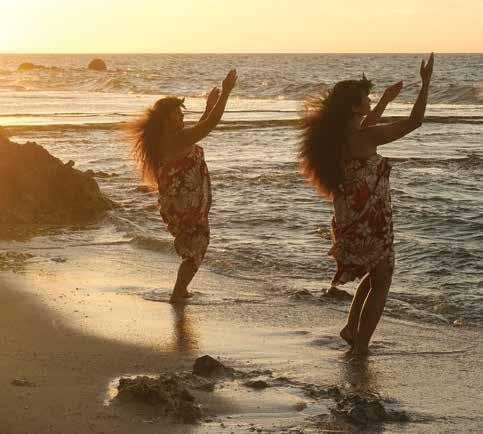
FEATURES
62 | Unsettling Cartographies
Political change depends on getting others to see a story the same way. Writer Jack Truesdale examines the fuel leak at Red Hill fuel and the land the crisis is situated on to reflect on how this stubborn truth frustrates local residents, activists, and Kanaka Maoli seeking justice.
70 | Keepers of Kaiser’s
For generations, a group of local surfers known as the Kaiser Surf Crew—friends, brothers, fathers and sons—have established a presence in and out of the water. Senior editor Rae Sojot gathers their stories.
96 | Making It in Mō‘ili‘ili
In learning a neighborhood’s labor history and modern-day eccentricities, writer Sarah Burchard manages to cope with loss and find the resilience to move forward.
110 | Island Gaze
In the images of Kanaka Maoli photographer Josiah Patterson, a portfolio that speaks to the enigmatic nature of his O‘ahu home.
|
F/W 2022
Still from Christopher Makoto Yogi
6 | FLUXHAWAII.COM

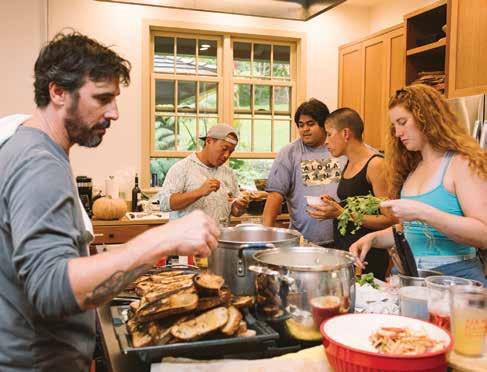
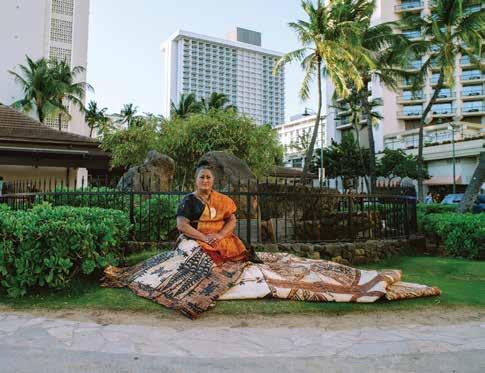
142 LIVING WELL 144 | Kapaemahu Healing Stones 122 EXPLORE 124 | Food Hana
132 | ‘Ōlelo Kumukahi TABLE OF CONTENTS | DEPARTMENTS |
Kū
Image by Josiah Patterson
8 | FLUXHAWAII.COM
Image by Viola Gaskell
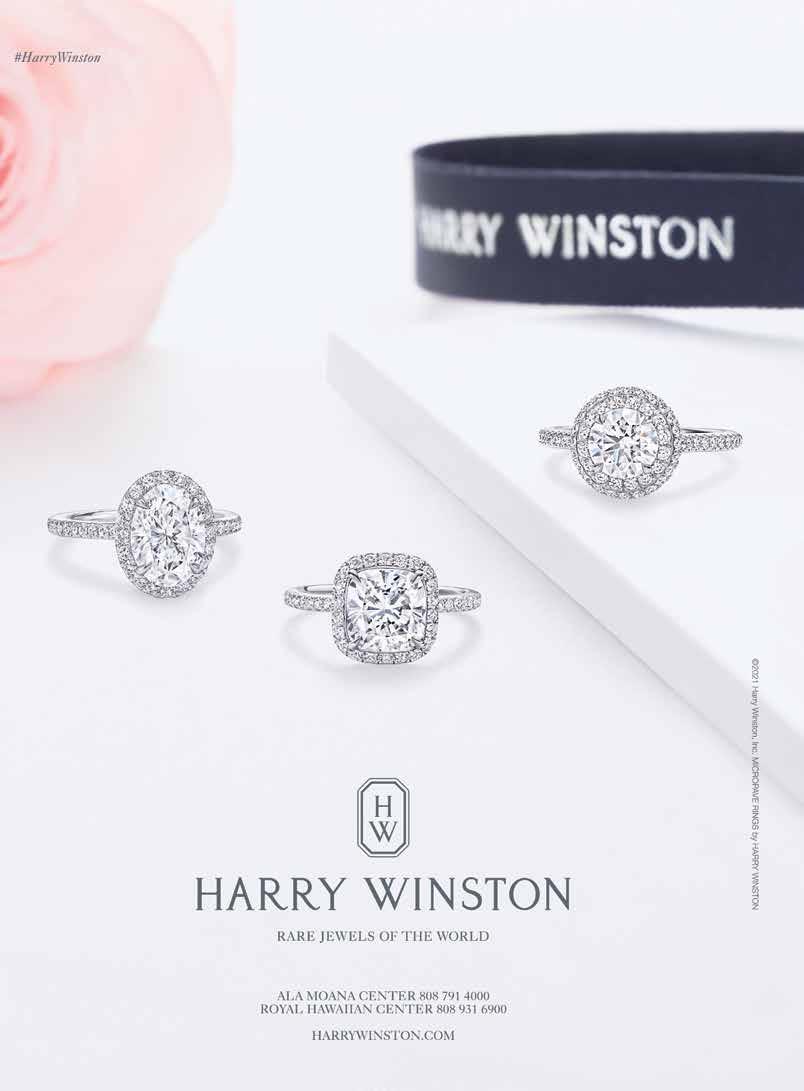
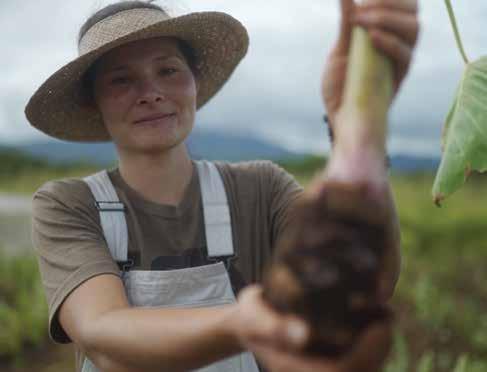
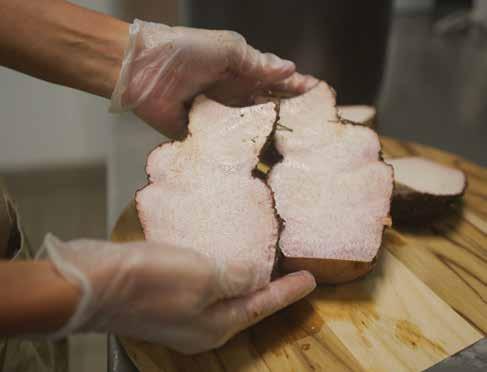
Stay current on arts and culture with us at: fluxhawaii.com /fluxhawaii @fluxhawaii @fluxhawaii INFLUX TV Sweetly Homegrown ‘Ulu and Kalo Bakery TABLE OF CONTENTS | VIDEO | Still from IN FLUX Still from IN FLUX 10 | FLUXHAWAII.COM
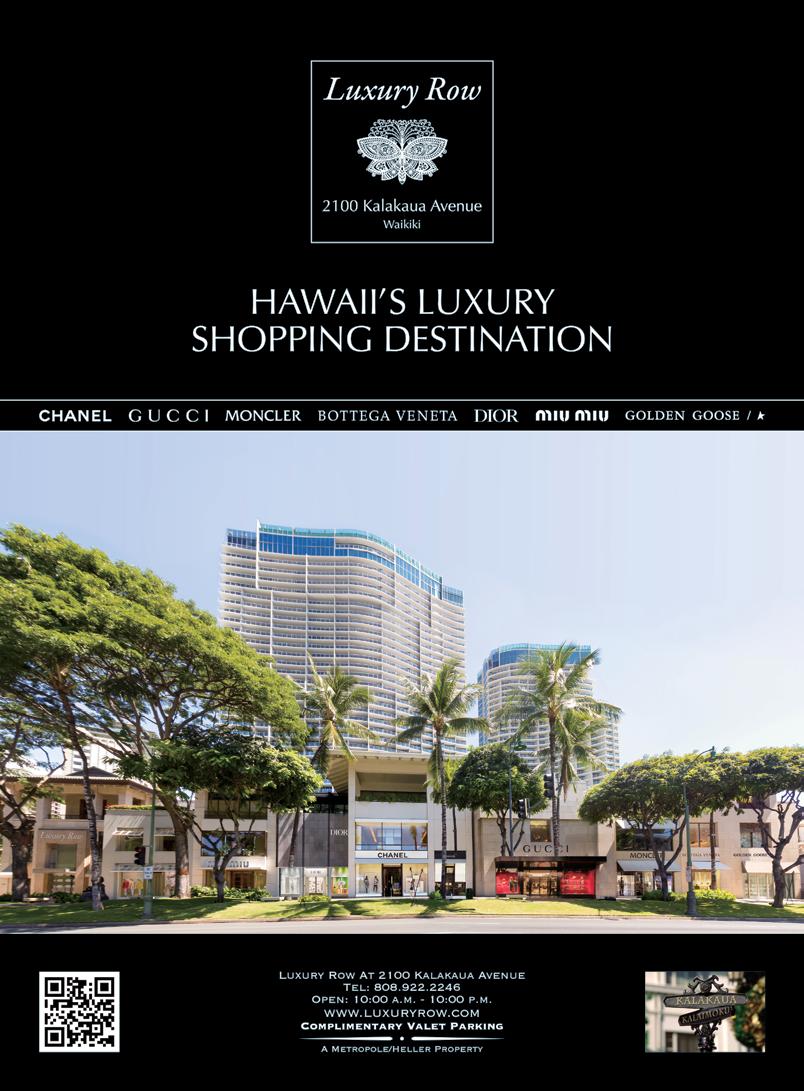
Streaming Videos, Newsletters, Local Guides, & More
We’ ve refreshed the website for Flux Hawaii with a more dynamic viewing experience. Watch all the original episodes from our themed seasons, find ways to support local small businesses, and sign up for our weekly newsletters curated with fascinating reads. You can also browse past issues of the print magazine for purchase.
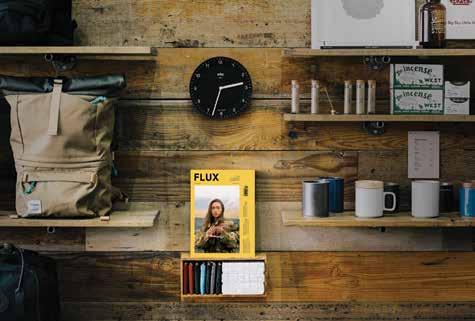
On the Cover
Three images highlighting stories from inside the issue. Clockwise from right: 1.) Portrait of Iosua Stevens at the beach, photographed by Josiah Patterson; 2.) the hands of Kekai Naone, gathering lau hala, and 3.) kumu hula Taupōuri Tangarō, in protocol at Kumukahi, both on Hawai‘i Island and photographed by Keatan Kamakaiwi.

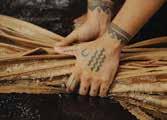
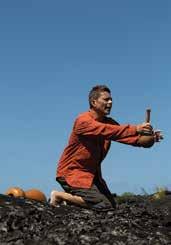
| ONLINE | FLUXHAWAII.COM
TABLE OF CONTENTS
12 | FLUXHAWAII.COM
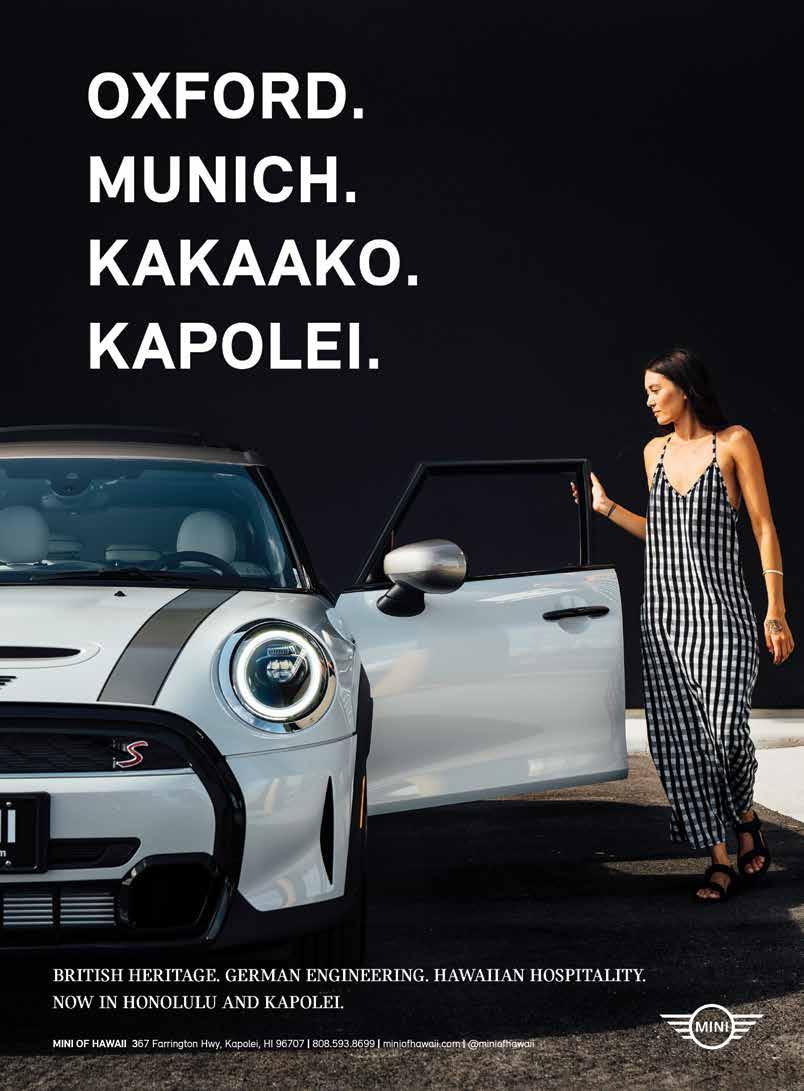
PUBLISHER
Jason Cutinella
VP BRAND DEVELOPMENT
Ara Laylo
GLOBAL EDITORIAL DIRECTOR
Brian McManus
EDITORIAL DIRECTOR
Lauren McNally
EDITOR-AT-LARGE
Matthew Dekneef
SENIOR EDITOR
Rae Sojot
DIGITAL EDITOR
Eunica Escalante
SENIOR PHOTOGRAPHER
John Hook
PHOTOGRAPHY EDITOR
Samantha Hook
DESIGNERS
Nico Enos
Taylor Niimoto
CONTRIBUTORS
Vincent Bercasio
Sarah Burchard
M. Kaleipumehana Cabral
Frank E. Ka‘iulani Damas
Viola Gaskell
Krystal Hope
Mitchell Kuga
Jackie Oshiro
N. Ha‘alilio Solomon
Jack Truesdale
Kylie Yamauchi
IMAGES
kekahi wahi
Kevin Brock
Mahina Choy-Ellis
Sean Connelly
Viola Gaskell
Keatan Kamakaiwi
Josiah Patterson
Pūlama Long
Mark “Feijão” Milligan II
Christopher Makoto Yogi
CREATIVE SERVICES
Marc Graser VP GLOBAL BRAND
STORYTELLING
Gerard Elmore VP FILM
Blake Abes
Romeo Lapitan
Erick Melanson FILMMAKERS
Jhante Iga VIDEO EDITOR
Kaitlyn Ledzian BRAND & PRODUCTION MANAGER
OPERATIONS
Joe V. Bock PARTNER/GENERAL MANAGER – HAWAI‘I
Francine Beppu VP INTEGRATED MARKETING francine@NMGnetwork.com
Gary Payne
VP ACCOUNTS RECEIVABLE
Brigid Pittman
DIGITAL CONTENT & SOCIAL MEDIA MANAGER
Sheri Salmon CREATIVE SERVICES MANAGER
Sabrine Rivera OPERATIONS MANAGER
ADVERTISING
Mike Wiley VP SALES mike@NMGnetwork.com
Courtney Asato MARKETING & ADVERTISING EXECUTIVE
Nicholas Lui-Kwan ACCOUNT EXECUTIVE
Taylor Kondo BRAND PRODUCTION COORDINATOR
General Inquiries: contact@fluxhawaii.com
PUBLISHED BY: Nella Media Group 36 N. Hotel St., Ste. A Honolulu, HI 96817
©2008–2022 by Nella Media Group, LLC. Contents of FLUX Hawaii are protected by copyright and may not be reproduced without the expressed written consent of the publisher. FLUX Hawaii assumes no liability for products or services advertised herein. ISSN 2578-2053
MASTHEAD | FALL/WINTER 2022 | 14 | FLUXHAWAII.COM
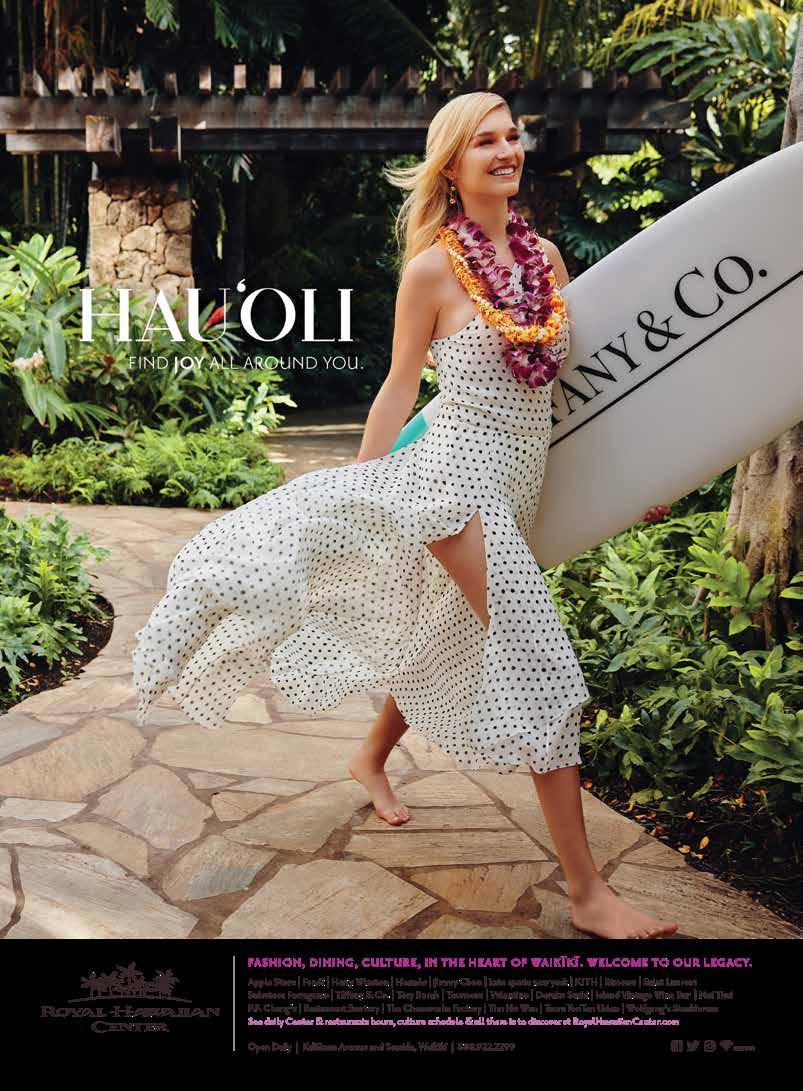
CONTRIBUTORS

Mahina Choy-Ellis
Born and raised in Kalihi Valley, Mahinahokukauikamoana Choy-Ellis is a Kanaka photographer who picked up a camera at 12 and never put it down. With a curiosity that knows no bounds, Choy-Ellis and her camera can be found spending time photographing professors to drag queens, and is grateful for every journey. After eight years in New York City, she felt the call to return back home to Hawaiʻi and has since found creative support from the Lāhui and Māhūi, finding her main inspirations from both. She finds joy in capturing local artists, performers, and beyond. In this issue, she photographed Joseph Han for a profile on page 30. “It was a joy to simply talk story with a brilliant author like Joseph,” she said. “It was only fitting that we spent our time together at the Hawai‘i State Art Museum, surrounded by works with strong connections to Hawaiʻi. I loved listening to the inspirations behind his latest novel and can’ t wait for the world to hear more from this storyteller.”

Krystal Hope
Krystal Hope is an AfroGuyanese American woman raised between Guyana and New York City. She is a subversive, pro-Black feminist who examines the intersections of culture to identify opportunities for collective liberation. Her interest in decentering Western ideologies brought her to Oʻahu to complete her master’s degree in Communication at UH Mānoa. Her work critiques homogeneity and encourages subaltern representation in media. In 2020 she founded KHopeacetic, a digital communications and marketing consulting company that helps missiondriven entities achieve their goals. When not practicing her craft, she consumes an inordinate amount of books, watches terrible reality TV, practices photography, and wanders around art spaces. She interviewed artist Mark “Feijão” Milligan II on page 20. “I am struck by how Mark uses his imagination and curiosity to capture the finer details of Blackness,” Hope said. “ Viewing his artwork is like seeing yourself through the eyes of someone who already loves you as you are.”
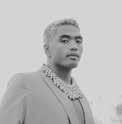

Jack Truesdale
Keatan Kamakaiwi is a photographer born on the Island of Hawaiʻi and raised on Oʻahu. Growing up, he had always known that he wanted to pursue the creative arts and just happened to discover photography. Kamakaiwi started taking photographs in high school, then took a break, but the 2019 protests on Maunakea reignited his practice. A friend and contemporary of his, the photographer Marie Eriel Hobro, asked if he could help photograph and interview some of the people involved on the mauna. Since then he has made images of local people, small businesses, and island-based programs. Kamakaiwi photographed two stories in this issue. For a profile on lau hala weaver Kekai Naone, on page 38, Kamakaiwi said witnessing “the amount of patience it takes really changes your perspective when you see a pāpale or anything handwoven.” On his journey to Kumukahi, for the story on page 132, he added, “to learn about the moʻolelo of the stones, then to see it in person gave me chills.”
Neither born nor raised in Hawaiʻi, Jack Truesdale hails from the icy hinterlands of Massachusetts. Family, William Finnegan’s Barbarian Days, and a fascination with Hawaiʻi’s history, both past and present, brought him to the islands. He initially was based on Maui, where he wrote for local newspapers and now contributes to surf magazine Stab. In August 2022, he moved to Oʻahu and joined the Honolulu Star-Advertiser as a reporter. He holds a bachelor’s degree in English Literature from Brown University. For this issue, on page 62, Truesdale reflected on the Red Hill fuel leak crisis at Kapūkakī and how reimagining and recontextualizing the landscape might reshape the ongoing narrative.
“I was surprised to learn how much conventional mapping obscures Hawaiʻi’s history and culture, and how conversation and a little digging can resurface those old but not out-ofdate stories,” Truesdale said. “These stories live on, and re-enliven the land, if you know where to look.”
|
| FALL/WINTER 2022
Keaton Kamakaiwi
16 | FLUXHAWAII.COM
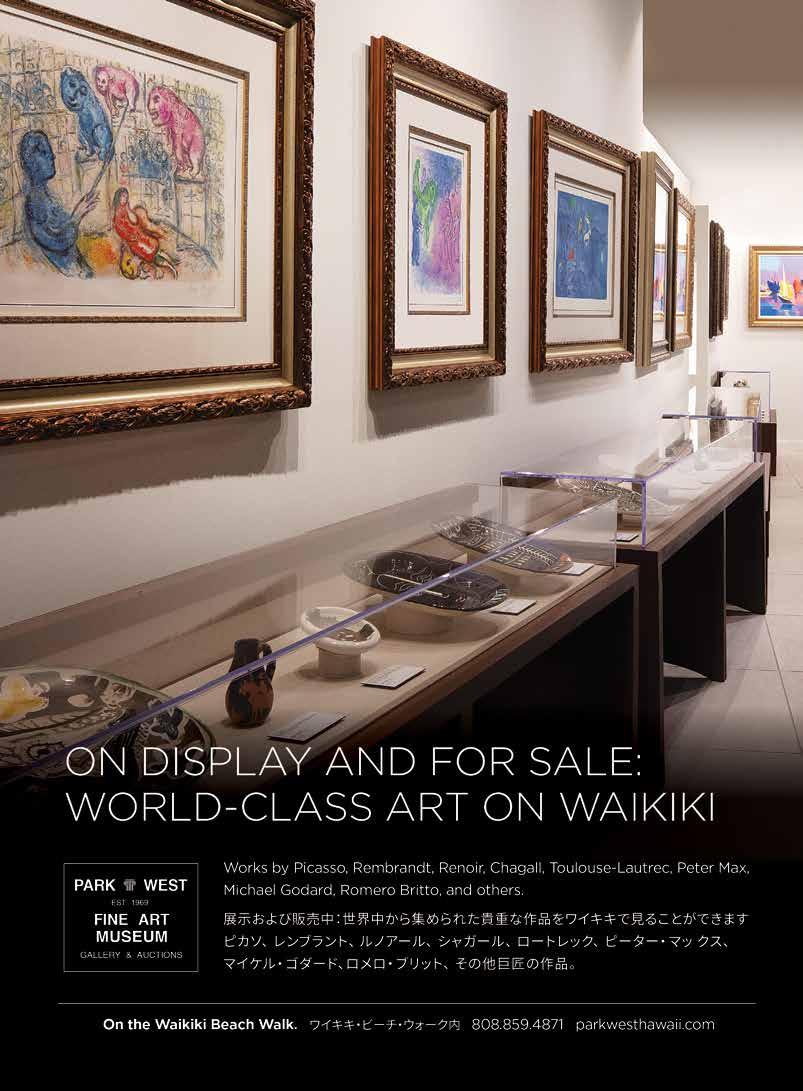
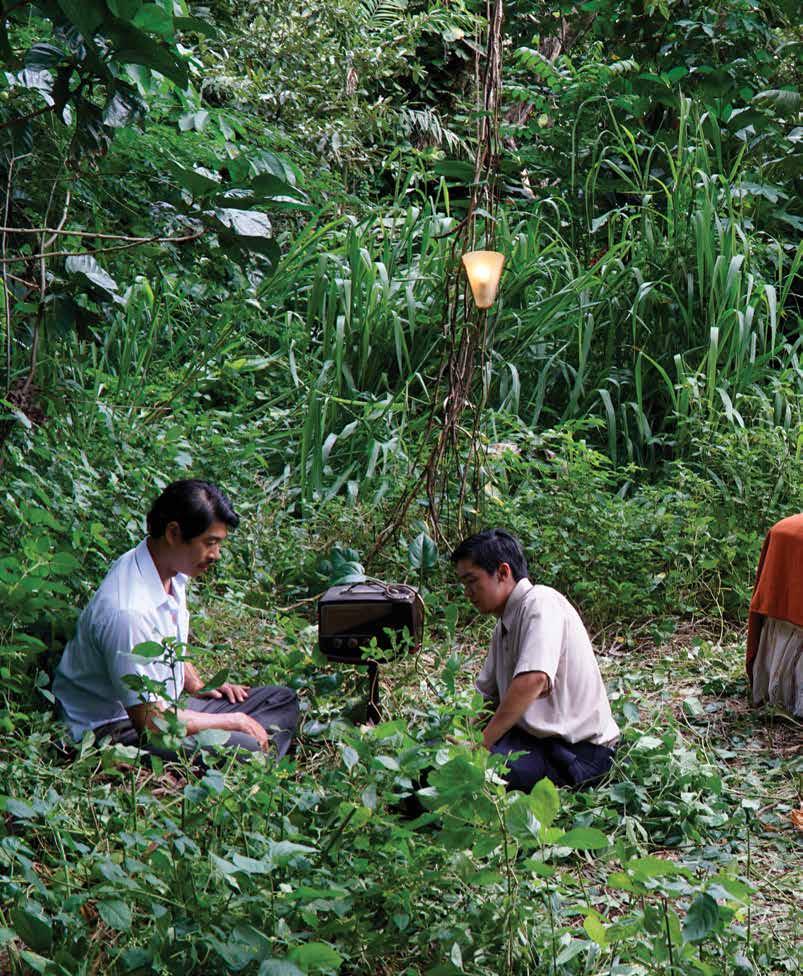 Scene from I Was a Simple Man . Still from Christopher Makoto Yogi.
Scene from I Was a Simple Man . Still from Christopher Makoto Yogi.
ARTS & CULTURE
“Fiction became a home for me, a place where I can return to articulate the important connections that continue to shape who I am and what I live for.”—Joseph Han

Black Abundance
The artwork of Mark “Feijão” Milligan II richly humanizes the African diaspora with the majesty of Black joy and abundance.
TEXT BY KRYSTAL HOPE
IMAGES BY JOHN HOOK
Mark “Feijão” Milligan II is a child of St. Croix, U.S. Virgin Islands, and is a contemporary Hawai‘i-based artist who is imagining and creating abundantly powerful representations of Blackness. He works in figurative painting and drawing to invite conversations that reveal the humanity of Black people across the diaspora.
Pay attention to its finest details and viewers will notice intentionally integrated influences of the Hawaiian Islands reflected in the stories he tells.
As a child of St. Croix, Virgin Islands, how does your identity play a role in how you express yourself through your art?
From an early age, I found identity to be very important. That was the catalyst for a lot of what I continued to do even today.
When I was 11 or 12, I was leaving our house, walking up the street to catch a bus. I was passing by all our neighbors, and I remember how much of an impression it made on me, seeing all these beautiful households of people of African descent, people who are Afro Latino, and people from Puerto Rico. You also have different faiths too. I was very present in that moment, taking it in with a lot of pride.
I remember feeling like, not necessarily making a comparison to anything else, but feeling very full. Like, “Wow, this is like such a beautiful community.” I’m leaving my house, but I’m still in a community that’s so strong. We pass by each other, hail each other up, greet each other— this was all just in a walk from my house. I remember
at that moment also thinking about the portrayal of my community and this area that I lived in and all these neighbors in mainstream media, and seeing how different it was, how twisted and one-sided, and foreign their perspective of our community was.
I knew at that point that I had art inside of me. I knew that even as one person, I’m going to do what I can to affect some kind of change. If I’m not seeing it outside of me and I’m feeling all of this within me, I’m going to be a creator. A part of it was for myself and for other people too.
What does your creative process look like?
Oftentimes my work tends to be a response either to something that I’m feeling internally or something that I’m seeing. Typically, I’m seeing portrayals that are very different from my experience. What I started to do in those moments is to tell the story myself. It becomes a situation where I just kind of sit and think of things that move me. I think in something of icons.
For example, a couple of years ago, I was in church and I was sitting in the pews and I was seeing these images of Caucasians portrayed as Jesus Christ, as Mary, portrayed with reverence and respect. But then, we’re also going into the text and we’re talking about Egypt and the Middle East. Then when you see these places in National Geographic or other travel publications to reference the geography, the people that I’m seeing on the walls are not matching up. I really started to play with that. Fast forward a couple of years later, I actually got a little bit of trouble during my religious teachings because I would
FLUX PHILES | PAINTING | 20 | FLUXHAWAII.COM
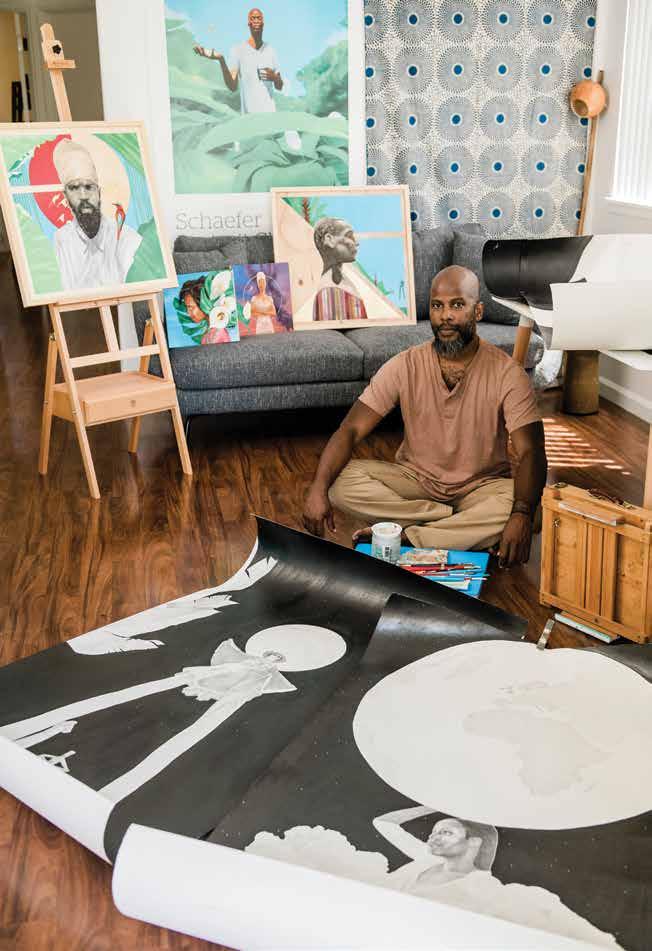
bring it up quite often. [Laughs] For my process, I see something that needs to be adjusted and I do a piece that kind of responds to it. It’s a conversation against untruths that need to be corrected. Then it just flows from there.
What dialogues are you hoping to inspire? Is there a certain conversation that you think folks should be having around your art? The main thing I want the viewer to do is recognize the humanity of the African diaspora. Because I find that so often we are treated as something different. There is a lack of empathy by the mainstream media.
It’s really important for there to be a humanization to realize that our stories are real, that our stories are not always this one-sided portrayal of pain, of a lack of history, of impoverishment, of sickness. There’s so many things that are sometimes associated with the Black experience, but coming from my situation, there was abundance, there was a strong social structure. I had a strong family around me. I grew up very healthy. I grew up understanding my history and realizing that my history did not begin with enslavement, and realizing that my history is actually the history of everyone.
Because if you really look at it, all people’s history connects to Africa, our history is long. We come from a culture that really needs to be celebrated in a certain way. So that’s what I try to capture within the pieces because I feel like oftentimes we only get little snippets in time.
But if you look down the line, if you look over the years, you can see the continuity and these moments are forming a sentence, they’re forming a structure. The larger story is that there’s so much more to us than we are given credit for.
So if the credit isn’t going to be given, I’m going to become a vehicle for telling this story. The question that I want people to have when they see it,
if they’re not from the community, is to express a certain amount of curiosity without an immediate prejudice. I would like to inspire them to kind of realize that our story runs deep.
I love that. I do get that. I can see that you want us to see ourselves. That’s something I’ve been interested in and has inspired a lot of my research and work in communications because I don’t like the way I see myself portrayed. I often ask myself how I can influence that. You’re asking that as an artist. What do you think we lose or gain by seeing ourselves or not seeing ourselves?
By not seeing ourselves there’s a diminishing of a person. By not seeing ourselves, I think there’s a lot of questioning. By not seeing ourselves, we are leaving ourselves exposed to our story being narrated by someone else. Telling our stories is empowering. Oftentimes when I think about that, I’m not thinking about the adults. I think about the children because there is such an impression that can be made when a child looks at images that celebrate them. You’re propping them up and to have that within a community, it does so much.
Totally. I have heard you talk about the people in your life who you have painted or drawn. What do your muses think of your work? How do they respond to you? Or, rather, how do they respond to seeing themselves through you?
Everyone’s reaction is a little different, it’s never exactly the same. Sometimes I can tell they feel very flattered. Some say nothing [laughs]. But in general, I’ve always had a good experience when I work with folks.
Because I personally enjoy the process. I enjoy creating art where it’s collaborative, where I’m able to go to someone and we pose and we do these different things. I think the people have enjoyed it too.
Regarding the symbols that you use
in your art, particularly foliage, water, the stars, what do they mean to you? Why incorporate these natural elements?
I love richness. For instance, with food, I love dishes that have a lot of different elements. One of my favorites growing up back home was callaloo (taro leaves). It’s not exactly the same, but one could compare it to gumbo because it’s this rich mix of the callaloo leaf and different meats and sometimes you even put a little fungi or fufu in there. It’s mixed, it’s layered. That’s kind of how I like to create my artwork. Very layered.
A lot of what the symbolism really boils down to it is actually religious or spiritual. I find that icons already have, within our culture, been given a certain amount of weight. People have certain associations of the sun or the moon, regardless of where you’re from—that’s global, that’s almost genetic. When you see the sun, generally people will think of brilliance, wisdom, growth.
If I want to bring in a different kind of vibe, maybe I'll reference the moon, to create a sense of solitude and the wisdom associated with that. Oftentimes it’s about creating that right balance, you know?
Absolutely. How has your art evolved, shifted, or surprised you since living in Hawai‘i?
I have not shifted my art a lot, but there’s a reasoning behind that. I did not want to come to the islands, not know about the culture, and start feeling like I can include all kinds of imagery, acting like I am in a place where I can start to speak for the Native Hawaiian culture. I take that very seriously. If I’m going to be a vehicle, I want there to be some kind of knowledge base there. I want there to be time.
I intentionally have not tried to take on that kind of voice until recently with the mural Tapestry in 2020. I had this huge wall for Pow Wow Hawaii, it was the size of a
22 | FLUXHAWAII.COM

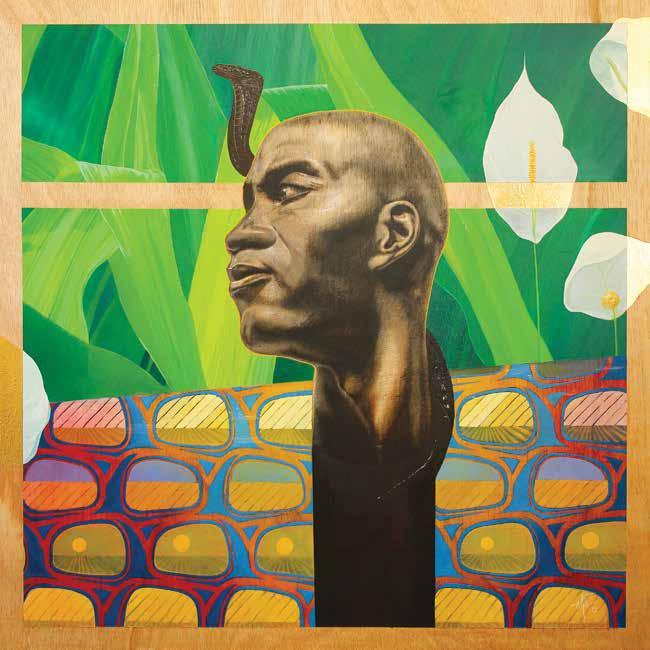 “Gordon in Flora.”
“Gordon in Flora.”
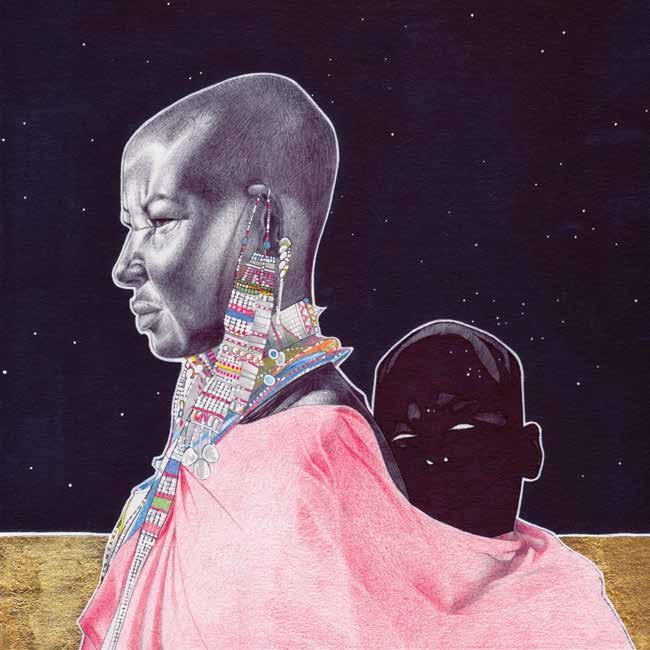 “Dibujo Nocturno.”
“Dibujo Nocturno.”
tennis court. It was in the Salt complex at Kakaʻako and there was a connection with Kamehameha Schools too. I requested to have two students from KS join me and work on the wall together. I could almost mentor them throughout the process, and give back in a way that I remember being given back to when I was a child. I went to a teacher and I asked questions because I knew, in that instance, I wanted to create a piece that spoke to the native experience. I wanted to use that public platform as a vehicle for that portrayal, but I did it with research and seeking permission.
That mural was already influenced by the foliage there too it seemed.
Oh, yeah, without question. A lot of what my experience has been living in Hawai‘i is seeing a the strong connection between the West Indian and Caribbean experience in the environment. I’ll go out on the west side in Waiʻanae and be like, “Oh, that’s kasha (buckwheat).” Even the plumeria, we have plumeria back home, we just call it something different.
So there’s so many connections and I do bring that to the pieces. For example, in Yeshua/Horus and Madonna/ Isis, the foliage is Hawaiian. If you have the eye, like you do, you can see the connection, you can see that there’s a dialogue with the Hawaiian experience and the West Indian experience just through the inclusion of the foliage. That I definitely can do. There’s so many conversations that can be had there. The political connections, the experience of the Native Hawaiian culture here and the experience of us back home.
Can you be more specific? What do you mean by the experience?
I’m speaking to the experience of colonization. We’re both cultures that have histories of colonization. I think that’s one of the reasons why I also approach the culture with a certain reverence and respect because I know what it’s like to come from a culture where people colonize a place and bring their perspectives of who we need to be and impose that on us. Almost with like martial law. I know what it’s like.
I come from St. Croix, which is the furthest east possession within the United States, Point Udall, as far as I know. Then to be here in the furthest west, there’s a whole dialogue there. And, so many different similarities, even the way that we speak. There’s a resurgence of ‘ōlelo Hawaiʻi, which I think is beautiful, taking on your language and taking it on with pride. Back home, we have different Creole. I come from a culture where we speak Cruzan and sometimes one would refrain from speaking it because it may not be the “proper” way to speak. I remember going to school and sometimes they would tell us not to speak Cruzan.
I’ve seen your artwork in so many different phases and I’ve just developed a new relationship with your artwork. What are you creating these days?
I did a really cool collaboration with Solomon Enos left me very inspired. I always appreciated his work before, but to actually do a collaboration … we gave each other sketches and then completed them. So he completed a sketch that I did, I completed a sketch that he did.
With something like that, you actually have to kind of get into the person’s mind a little bit. It’s like you starting a sentence and then me finishing it, but we actually did it without actually meeting each other. We were kind of familiar with each other—we had seen each other’s artwork—but we had not actually even had a conversation. So to have that kind of dialogue, you have to like, you know, do a little research, you have to get into their head.
That was really inspiring for me because he’s an amazing artist, has an amazing portfolio — in actually working on his piece and completing it certain things kind of to re-bubble up within me. It had my mind thinking in different ways. A lot of what I’m gonna start working on now has threads of that experience in it. There’s a certain amount of surrealism in it, it is gonna have a little element of a native Hawaiian experience in it. I actually have models that are gonna be posing and there’s a new series that’s gonna be coming out that.
Who are you inspired by or who are you looking forward to seeing grow? Anyone you want to shoutout or uplift? One person that is really amazing is Jules Arthur. I don’t think I even tell him this that often, but he is an amazing artist. We went to school together and I just knew him more as a person. He’s really warm and little did I know he is a genius. Over the years from college to now, we continue to have some dialogue over social media. He is very inspiring to me personally. He might be actually surprised to hear that, but that’s the truth right there.
If I would like to be some place, I would love to be at a level where I’m working like Kehinde Wiley because he has really revolutionized the whole concept of what it means to be a Black artist. The way that he has been able to establish himself has been fantastic. He is just working with such high autonomy, it’s just amazing.
Local artists, too, like I mentioned before Solomon Enos. His prolific ability, like, when you look at the breadth of his work and what he creates, he is able to do so much with the amount of detail he has in there.
La Vaughn Belle, she’s an artist from St. Croix. Seeing the way that she works with the narrative of the culture that we come from and then kind of references past historical instances. She just created this beautiful sculpture that was displayed in Northern Europe that is a dialogue between the West Indian and European cultures and colonization called I Am Queen Mary. It’s really
26 | FLUXHAWAII.COM
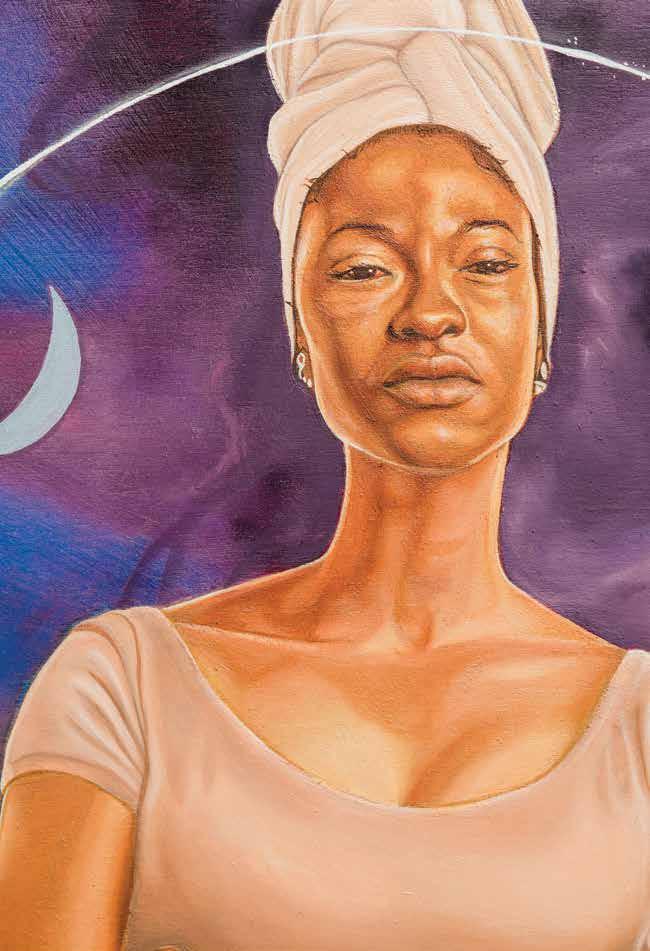
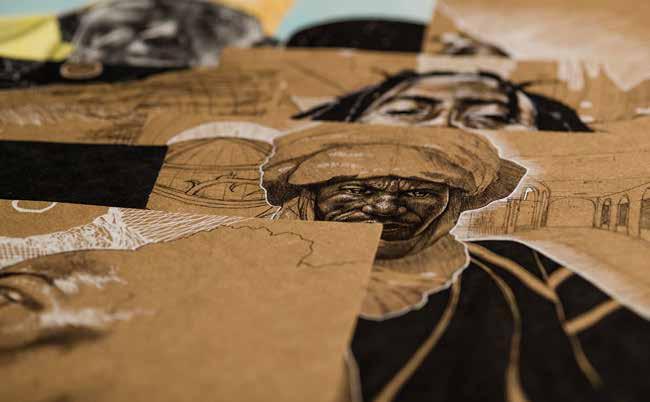
beautiful to see the way that she’s growing within her artwork too.
Where can we find your art these days?
I just recently had, surprisingly, two of my pieces on national television. One was on NCIS: Hawaii. Another on Lizzo’s show, Lizzo’s Watch Out for the Big Grrrls, one of my pieces is in that too. My work just recently got included in the personal collections of a couple substantial people. I’m gonna honor their privacy, I’m not gonna name names. But, you know, one is a former president of the United States of America. Another one is the current governor of the US Virgin Islands.
I love to hear that you’re being celebrated in the way that you should be celebrated. I love that your art is reaching the people who need to see it. Thank you. I love what I do. I love the opportunity that I’m being given, our conversation, I love this. I just want to continue to grow and to better myself.
This interview has been edited for length and clarity. For an in-depth discussion on the origins, references, and in-depth symbology behind more of Milligan’s work, visit fluxhawaii.com.
Milligan II is a figurative painter whose work concerns the Black diaspora.
Explore his portfolio at markmilliganart.com.
28 | FLUXHAWAII.COM

Culture Clash
In Joseph Han’s debut novel, imperial legacies in Hawai‘i and Korea are confronted with humor and heart.
TEXT BY MITCHELL KUGA
IMAGES BY MAHINA CHOY-ELLIS
Nuclear Family, the debut novel by Joseph Han, is many things: a ghost story embedded into a multigenerational Korean family saga; a typographical experiment utilizing elements of concrete poetry; a reckoning with the U.S. military; a lowbrow stoner comedy. But don’t call the book, which takes place largely in Hawai‘i, a beach read, with all the genre’s connotations of escapism. Han, a National Book Foundation “5 Under 35” honoree, says he thought a lot about the words readers use to describe their favorite books: It was so immersive; I felt transported; I escaped into the text. But that impulse felt complicated by writing about a place so often framed as an idyllic escape for tourists. Or, as Han explains, “I was very wary of allowing readers to visit the Hawai‘i in their imaginations.”
So instead of Hale‘iwa, or Waikīkī, or Kailua—places that favor the postcard image of Hawai‘i—Nuclear Family takes readers to Ke‘eaumoku Street, where “somewhere in the middle,” Han writes, “between a strip club and Ala Moana Center on the other end, bloated with a Target, a Walgreens, and a Walmart on each block,” sits Cho’s Delicatessen. It’s an unremarkable Korean plate lunch spot, with styrofoam plates that squeak under the weight of banchan, until it’s anointed by a visit from Guy Fieri, America’s “diner troll,” Han pans. Fieri’s co-sign elevates Cho’s Delicatessen into a bustling franchise, with lines suddenly out the door. But many years later, Umma, the family matriarch, still harps on one detail from his visit: “He didn’t even pay for his food.”
It’s funny, but at its heart Nuclear Family is about the many fractures, fallouts, and fissures caused by war. The Cho family—Umma and Amma and their children, Joseph and Grace—are Korean immigrants living in working class Honolulu. When Joseph, a closeted 25-year-old, leaves Hawai‘i for South Korea to teach English, his parents are elated. “You’re Korean is going to get so good!” Umma exclaims. But then Joseph gets possessed by the spirit of his dead grandfather (hate when that happens) who’s desperate to reunite with the family he abandoned in North Korea. A viral video of a possessed Joseph unsuccessfully attempting to cross the demilitarized zone into North Korea sends shockwaves across the Pacific, bringing shame to the Cho family. Business slows, as Grace, a 21-year-old senior at the University of Hawai‘i at Mānoa, tries her best to remedy the PR crises. She copes
30 | FLUXHAWAII.COM FLUX PHILES | LITERATURE |
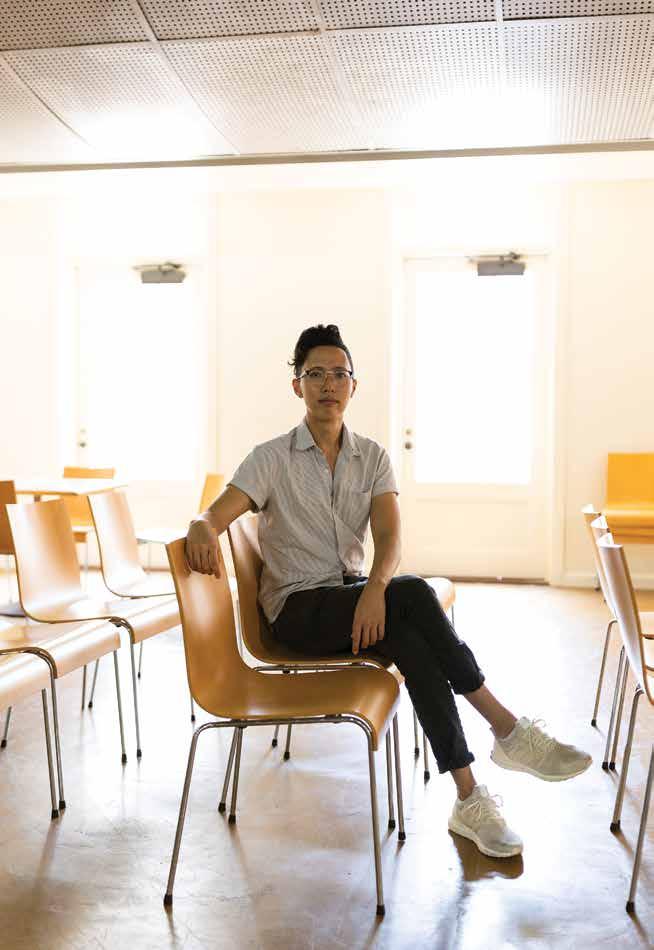
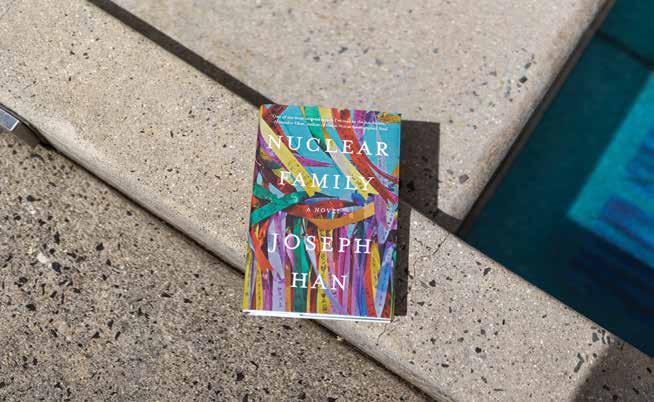
primarily through smoking an increasing amount of weed, which leads to one particularly extravagant meal at Zippy’s.
Throughout the book, O‘ahu’s housing crises, Red Hill’s jet fuel leak, and development on Kānaka Maoli burial grounds are all alluded to, grounding Nuclear Family in a socio-political present that places the concerns of Hawai‘i residents at its core.
“You’d have to visit Cirque du Soleil to see someone juggle as much as Han with such effortless dexterity and tenderness,” writes a critic for The New York Times. But for Han, that balancing act felt instinctual. He sees parallels to the structure of the plate lunch, a culinary mishmash often posited as a metaphor for local culture: the best of everything. “And that kind of informed how I approached writing the book, offering a little bit of everything in terms of style, and point of view, and also different genre registers,” Han says. “In writing in all these different genres, I was really just trying to create the language that I needed to survive as an artist.”
He was also inspired by the Korean ceremony known as jesa, in which a large
table is set with an overflowing assortment of foods as an offering to those who’ve passed. “So much of the novel is about how our nourishment is so conditioned on how well fed our spirits are,” Han says. He’s come to think of the writing of Nuclear Family as its own elaborate ceremony, a table he’s returned to over and over again to bear the weight of his ancestors, and to offer them something in return. “I needed the novel to structurally be able to hold as much as it could,” he says.
Han, 30, was born in Seoul and moved to O‘ahu with his grandmother, a devout Christian, when he was a baby (his parents eventually followed as he was about to start high school). Because he was born prematurely and prone to sickness as an infant, “my grandmother frames my life as having been saved by God,” Han says, with a chuckle. “And that’s why they needed to protect me, by finding a healthier environment for me [in Hawai‘i].” He grew up in Honolulu, in low-income housing on Vineyard Boulevard, feeling like an outsider. At Hawai‘i Baptist Academy, where Han graduated, he was bullied, his Koreanness most legible either through the
In writing about Hawai‘i, a place so often framed as an idyllic escape for tourists, Han explains that he was “very wary of allowing readers to visit the Hawai‘i in their imaginations.”
32 | FLUXHAWAII.COM
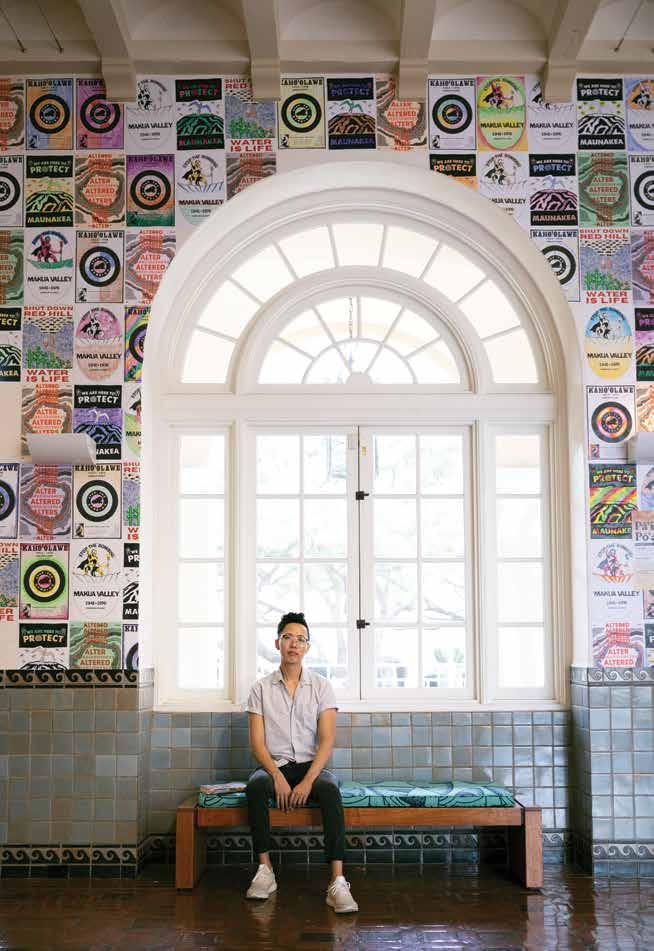
specter of North Korea or food. Though his mostly Japanese classmates “loved meat jun, they ridiculed me for being Korean, for my appearance and my flat face,” Han writes, in an essay recently published in LitHub titled “Making Meat Jun, Facing History: Flattening Korean Tradition in Hawaiʻi.”
It wasn’t until college, at UH-Mānoa, that Han began to conceive of himself as a writer. Up until that point, he describes his attitude towards the themes guiding his work today—reckoning with the U.S. military occupation globally; the histories shaping the Korean diaspora—as “totally detached, oblivious, and indifferent.” But during his sophomore year, Han’s father, a taxi driver at the time, was assaulted by a soldier in the military who refused to pay his fare. “That was a really formative moment for me,” Han says. “That anger that I felt and seeing my dad in the hospital really started to feed a lot of my wanting to learn more about military violence, both here in Hawai‘i and Korea.”
Reading scholars like Haunani-Kay Trask and Grace M. Cho radicalized Han, shattering the narrative he was taught growing up of the U.S. as the world’s savior. Just as enlightening was discovering the world of Asian American literature, and Korean American literature in particular. These books oriented Han
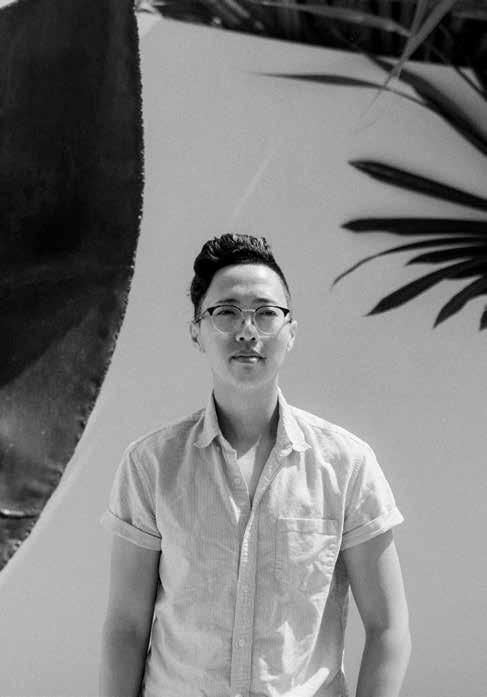
towards the possibilities of using fiction to illuminate histories that were either silenced in his family or distorted by the weight of American exceptionalism. In this way, Han’s project is somewhat of an ouroboros: “That’s what I have to offer,”
he says, “to use fiction to write back against fiction.”
Nuclear Family, which Han began conceiving in 2017, towards the end of his research as a PhD student (also at UH-Mānoa) comes at the tail of what he calls a “huge learning curve.” He
is both realistic about and resistant towards what it means to be a writer from Hawai‘i who’s writing about Hawai‘i within a national framework. He intentionally wrote Guy Fieri into the book as a hook for readers from the
34 | FLUXHAWAII.COM
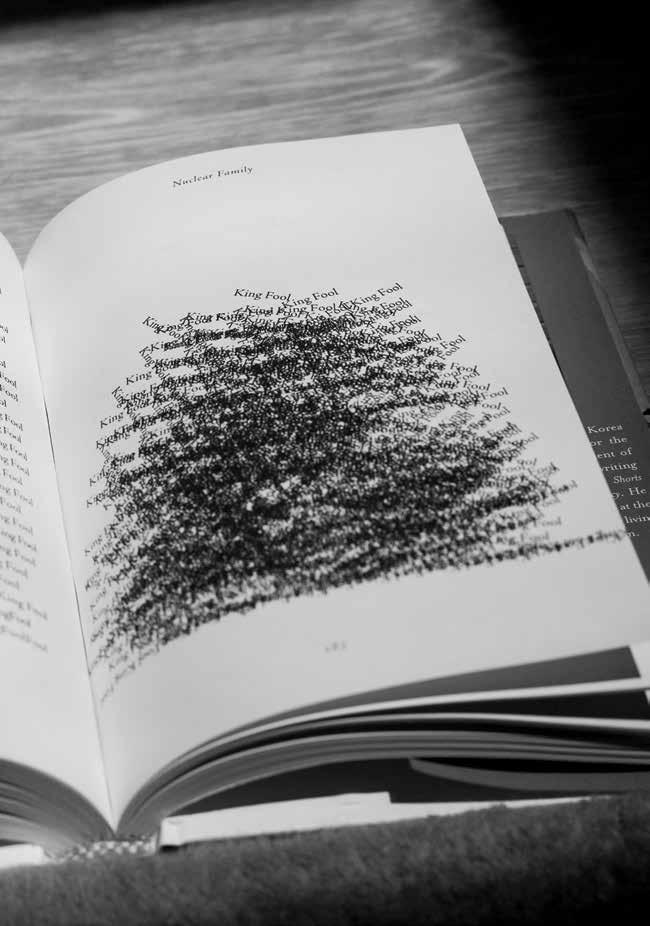

continental United States, “which really worked out, as I'm seeing now,” Han says, referring to the book’s Fieri-heavy press coverage. “Maybe a little too well.” And yet the book rarely panders to an outsider’s gaze, referencing menehune, Puck’s Alley, and iwi kūpuna without an explanatory comma in sight. Foremost, though, Han says he felt “a huge responsibility” to write for a diasporic Korean audience.
It’s a responsibility he’ll carry into his forthcoming book titled Monster Ball. Han describes the collection of short stories as even more personal than Nuclear Family, while taking a broader look at the Korean diaspora in Hawaiʻi. In the meantime, he has shifted into more of a mentor role, serving as an editor for the West region of Joyland Magazine, a literary journal that publishes by time zone, and teaching a fiction workshop this summer at Antioch University’s MFA program, where he was paired with five mentees.
Writing fiction, though, continues to be Han’s primary focus, grounding him in a
sense of place—a respite for someone who’s “always felt in-between in a way, neither of Korea or Hawai‘i,” he says. Rather than fight that in-betweenness, Han has learned to see it as a unique vantage point for his work, a kind of homecoming. “Fiction became a home for me, a place where I can return to articulate the important connections that continue to shape who I am and what I live for,” Han says, “and a lot of that comes back to living for the opportunity to reconnect with those we’ve lost or forgotten.”
Reading scholars like Haunani-Kay Trask and Grace M. Cho left an influence on Han.
Find Han’s debut novel Nuclear Family at local booksellers like Da Shop.
36 | FLUXHAWAII.COM
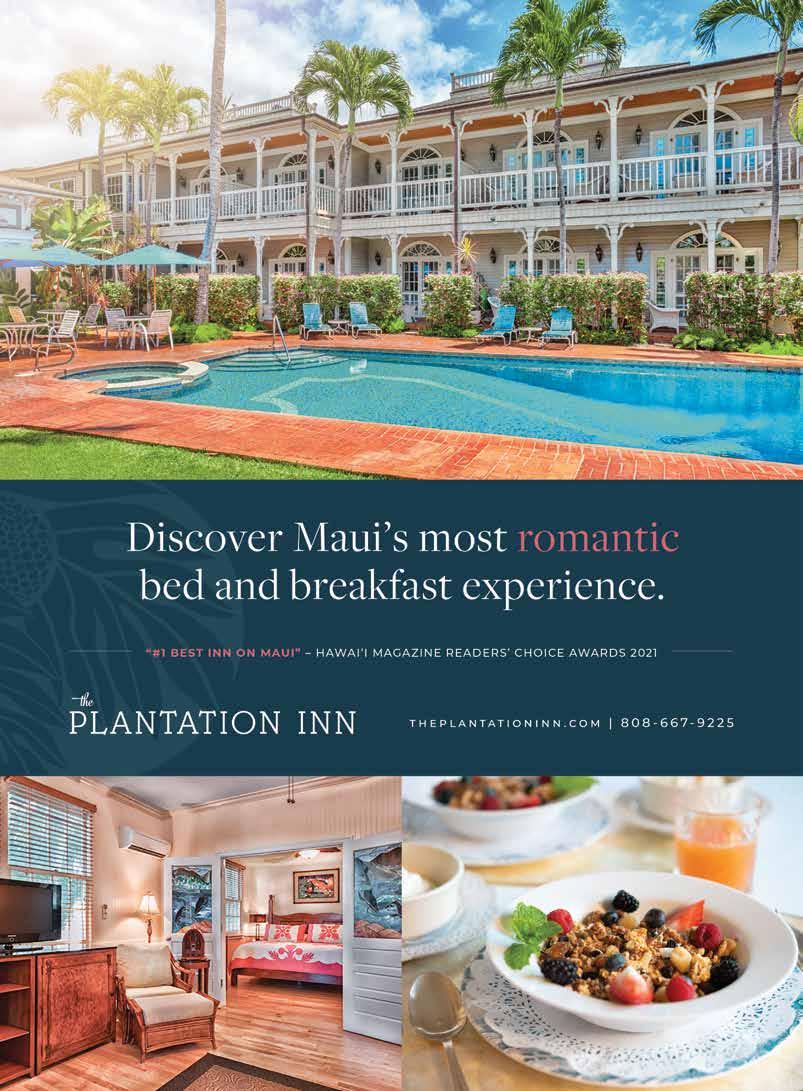
Interlocking Legacies
Through ulana lau hala, Kekai Naone weaves time together, connecting past to future with purpose, pragmatism, and personality.
TEXT BY JACKIE OSHIRO
IMAGES BY KEATAN KAMAKAIWI
In a quiet neighborhood in Hilo, a small stool stands in the middle Kekai Naone’s living room, its seat wrapped in an elegant twist of alternating patterns comprised of thin strips of light and dark lau hala. Like much of Naone’s work, the stool cover is beautiful, playful, and practical— an embodiment of the 26-year-old weaver’s approach to ulana lau hala, which is the weaving of dried pandanus leaves by hand. Chatting with a friend recently about how to best describe work like this, he was struck by her appraisal of his practice: “‘You don’t make culture for art. You make art for culture,’” he recalls, gesturing towards the stool. “It’s utilitarian, but it’s beautiful at the same time. And that was definitely a focal point for Hawaiians,” Naone explains. “We don’t want to have ugly things in our houses, so weaving wasn’t necessarily art—it was functional beauty.”
Functional is almost an understatement. Prior to Western contact, items made from lau hala—the leaves of the hala tree—were ubiquitous in everyday life. Floor mats, sleeping pads, baskets, cordage, and house thatching were all made from lau hala, and weaving was held as a point of pride as each family often had carefully guarded techniques. Over time, however, with the rapid decline of the Hawaiian population post-contact and imported materials becoming more commonly used, lau hala goods came to be seen as works of art meant to be treasured, not regularly used.
Naone’s dedicated lau hala Instagram account, @pikohinano, delights followers with a fresh take on the traditional practice. Intricately woven stools, water bottle sleeves, pāpale (bowties, even!) of all shapes and sizes, Naone’s creations are designed to be seen, loved,
Kekai Naone views Hawaiian weaving as a craft that needs to be practiced, stretched, pushed, and played with in order to remain healthy.

38 | FLUXHAWAII.COM
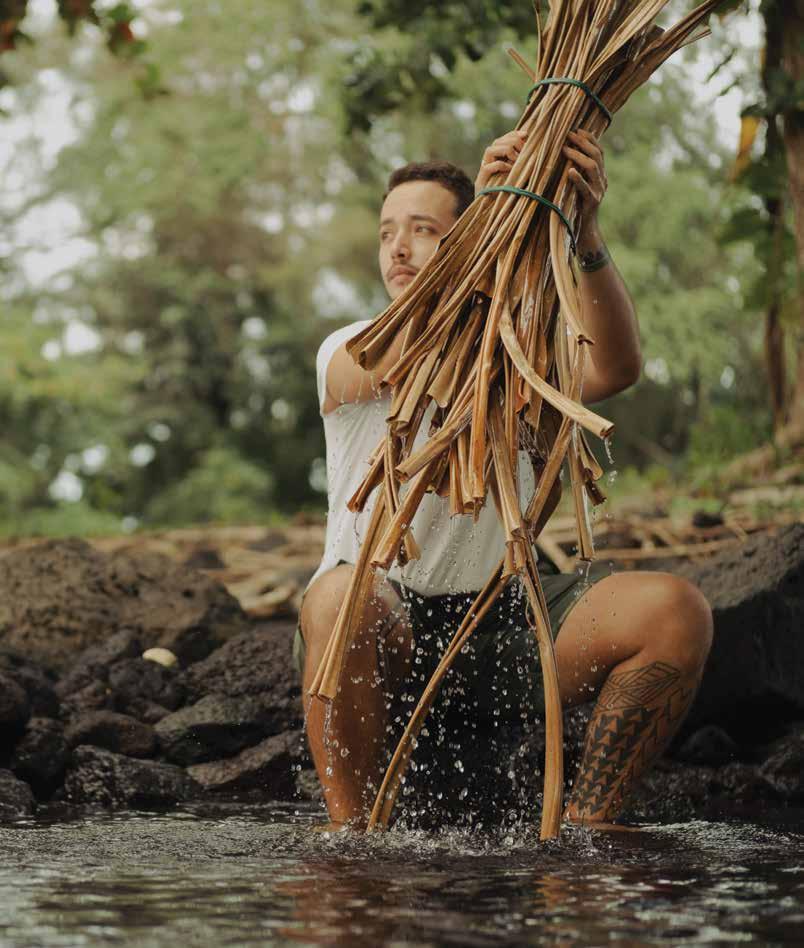
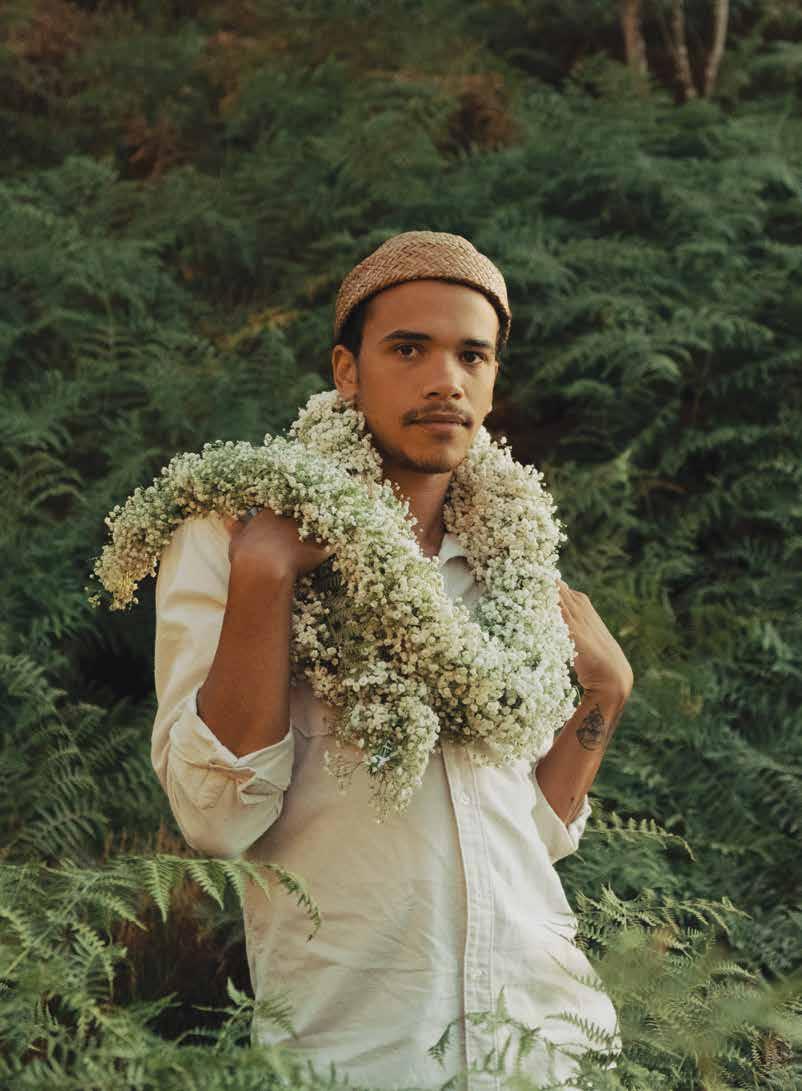
 Naone was introduced to weaving as a teenager in the Nā Pua No‘eau cultural enrichment program run by the University of Hawai‘i. Opposite, Piko Hīnano pāpale on Keanu Wilson
Naone was introduced to weaving as a teenager in the Nā Pua No‘eau cultural enrichment program run by the University of Hawai‘i. Opposite, Piko Hīnano pāpale on Keanu Wilson
and used often, inviting you to rethink your perspective on what constitutes mea lau hala, or lau hala objects, and how to embrace it. “A lot of people only wear their lau hala to church or parties. They don’t really know what they’re supposed to do with it, and I think that adds to the relegation of it to being super sacred or only for special occasions,” Naone says. “But, actually, wearing it is what keeps it in a healthy condition. It’s when you put it to the side that it can get bugs or it dries out and gets brittle.”
Naone views the craft of weaving itself in a similar light. It needs to be practiced, stretched, pushed, and played with in order to remain healthy. “In previous generations there was this sense of urgency focused on preservation,” he says, explaining that before the Hawaiian Renaissance of the 1970s, the knowledge of weaving was in decline, and those who practiced ulana lau hala were focused on preserving traditional methods and maintaining the foundation of lau hala. Learning how to weave meant mastering the exact way it was taught, which was important at the time, but ensuring the future of weaving requires growth. “Now, people love to do Hawaiian things. It’s not so sparse in the community, and I get to think of random things to make, like stool covers. So, I think my own sense of urgency is focused on expansion or living it.” In other words, it’s time to get building.
For Naone, thinking of ways to push the boundaries comes very naturally, perhaps because of his less traditional background. His childhood years on Oʻahu weren’t spent cleaning leaves for his tūtū or watching his mother weave. After he was first introduced to weaving as a teenager in the Nā Pua Noʻeau cultural enrichment program run by UH, he spent years teaching himself through books. Though he credits the only class he’s taken with helping him fill in some knowledge gaps—and introducing him to his kumu Michele Zane-Faridi—much of Naone’s work is characterized by the same figure-it-out attitude today.
“I like to take a lot of naps and that’s usually where I figure things out,” he says. “I kind of just envision it in my mind. I’m like, ‘Oh, that’s how it works.’ And then I get up and I’m like, ‘Okay, let me try this.’ But even
Prior to Western contact, items made from lau hala, which are the leaves of the hala tree, were ubiquitous in everyday life. Opposite, Piko Hīnano pāpale on Kai‘anuilālāwalu Andaya.
42 | FLUXHAWAII.COM
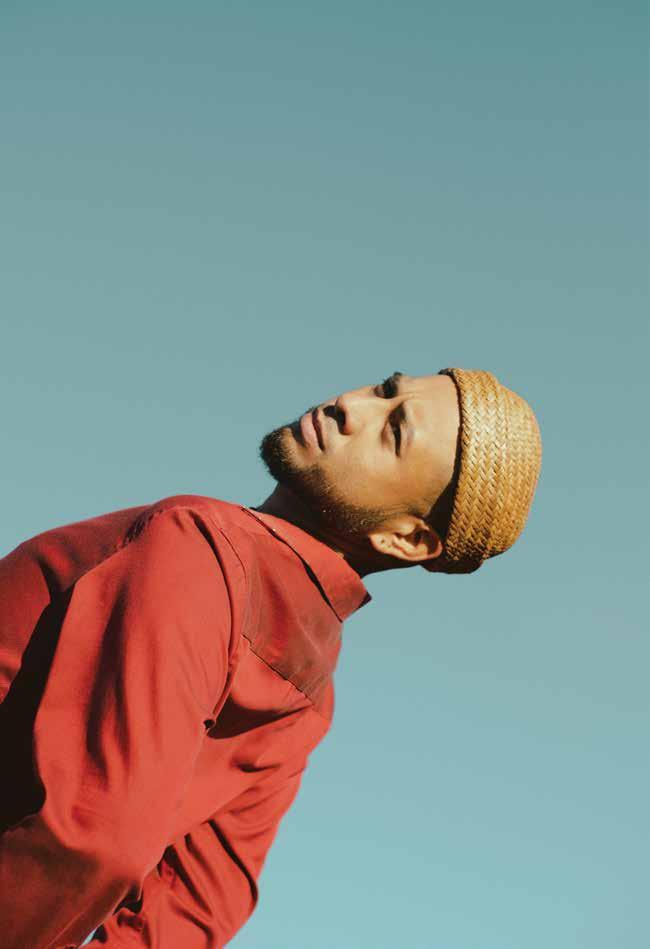
FLUXHAWAII.COM | 43

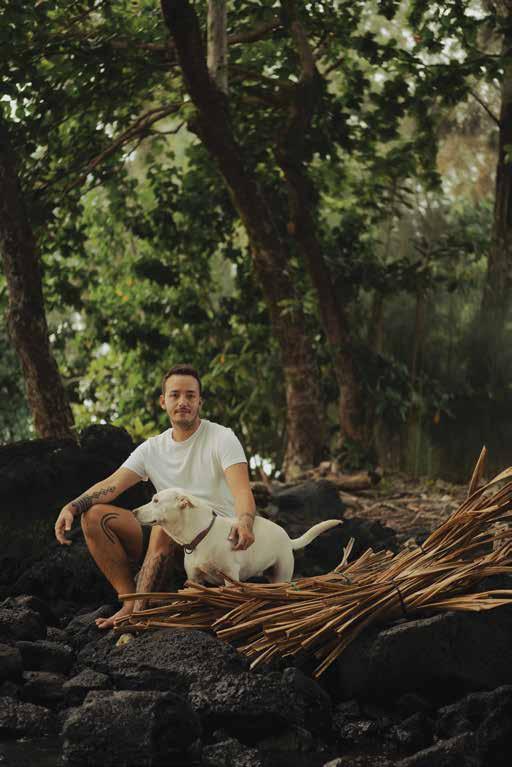
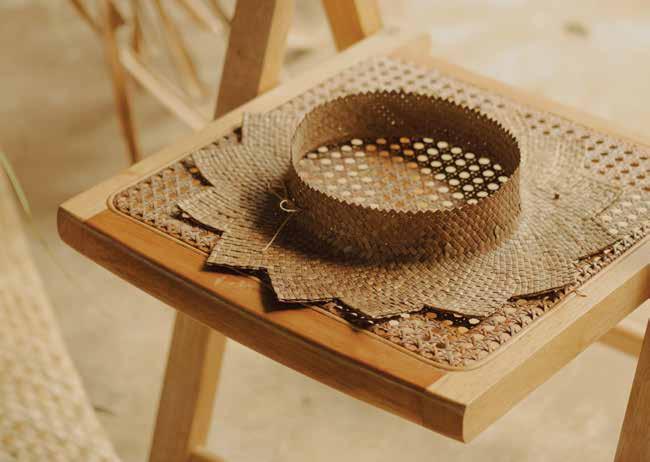
if I don’t know how to do it, I figure it out as I go. I’m very inspired by the spirit in that way.”
But Naone’s seemingly casual, inspiration-driven approach is not without intention. “I feel like Hawaiians always had a reason to do something, and there was always a meaning behind it,” he says. “We didn’t do things just to do it. I always keep that in my mind. What larger things am I speaking about by creating this? And even if it’s just for me, does this change the way I view the world?”
Naturally, Naone hopes to contribute to a future where more people have more lau hala things in their homes, where lau hala goods are part of one’s everyday life. Reaching that point is going to require many more hands, and while it may be daunting to start learning as an adult or without any personal connections, Naone points to his own journey as an example. “Whether you have ancestral connections or not, by learning to weave you’re making ancestral connections,” he says. “I think
people forget that back in the day everyone had weavers in their family. It wasn’t only special people. It was very utilitarian. If you didn’t know a weaver, I don’t know how you’re going to sleep—no pillow, no mat—it’s going to be a pretty junk life. It’s just about seeing what you’re good at, what you’re pulled to, and just going with it.”
Naone’s creations aredesigned to be seen, loved, and used often, inviting you to rethink your perspective on what constitutes mea lau hala, or lau hala objects, and how to embrace it.
Visit @pikohinano on Instagram to peep more of his designs.
46 | FLUXHAWAII.COM
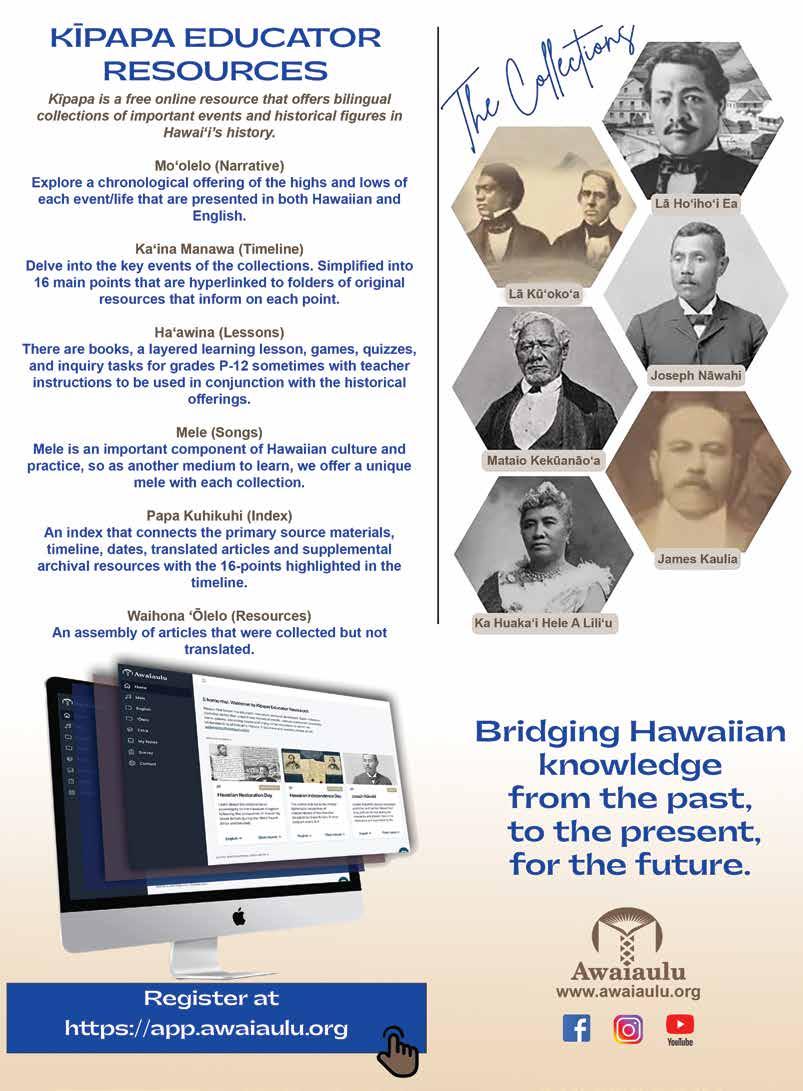
Cinematic Poetry
Memory, sorrow, and colonial fantasies continue to cycle anew in the filmmaker’s oeuvre with startling artfulness.
INTERVIEW BY VINCENT BERCASIO
IMAGES COURTESY OF CHRISTOPHER YOGI
In March 2022, the Hawai‘i-born filmmaker Christopher Makoto Yogi’s feature film I Was a Simple Man (2021) saw its streaming premiere exclusively on the Criterion Channel. Plaintively described as a “ghost story,” its programming on the platform was also joined by another subdued achievement, his Hawai‘i Island feature August at Akiko’s (2018), and a selection of seven shorts from the past thirteen years. Collectively, they compose perhaps the largest body of Hawai‘i-related cinema from a single filmmaker yet on the American streaming service. Vincent Bercasio spoke with Yogi about the maturation of his practice, how local politics surface in his filmography, and the outsized influence of the Taiwanese New Wave.
VINCENT BERCASIO Hello, Chris!
CHRISTOPHER MAKOTO YOGI Hi, Vincent. It’s nice to see you again.
VB Firstly, I hope you and your family are doing well.
CMY Yeah, we’re doing great!
Christopher Makoto Yogi is a filmmaker from O‘ahu. Overleaf, still from Layover, on the Shore (2009).

48 | FLUXHAWAII.COM FLUX PHILES | FILM |
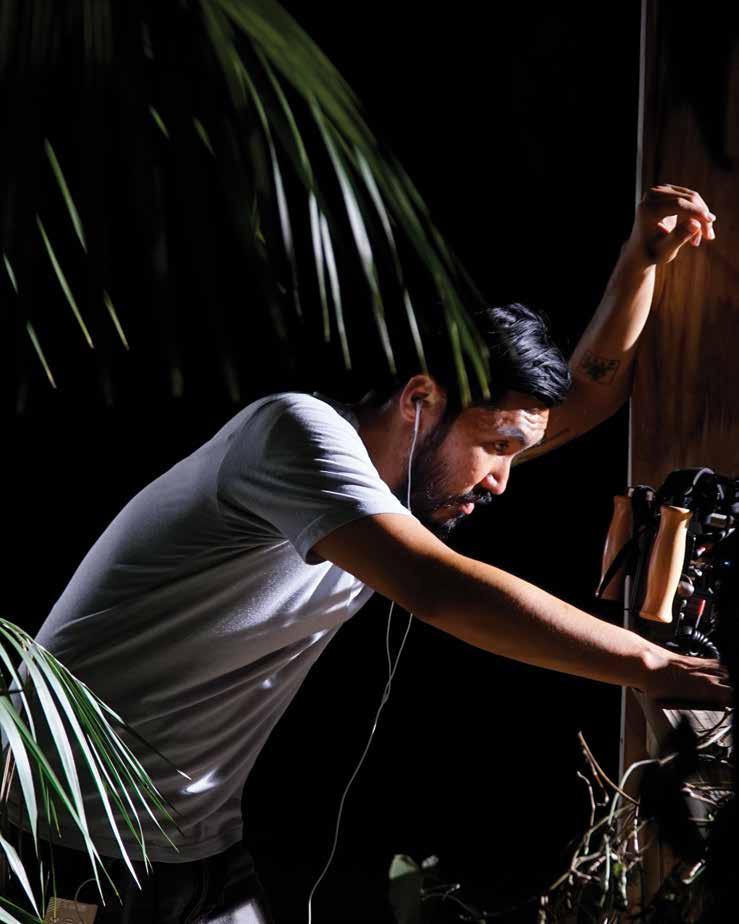
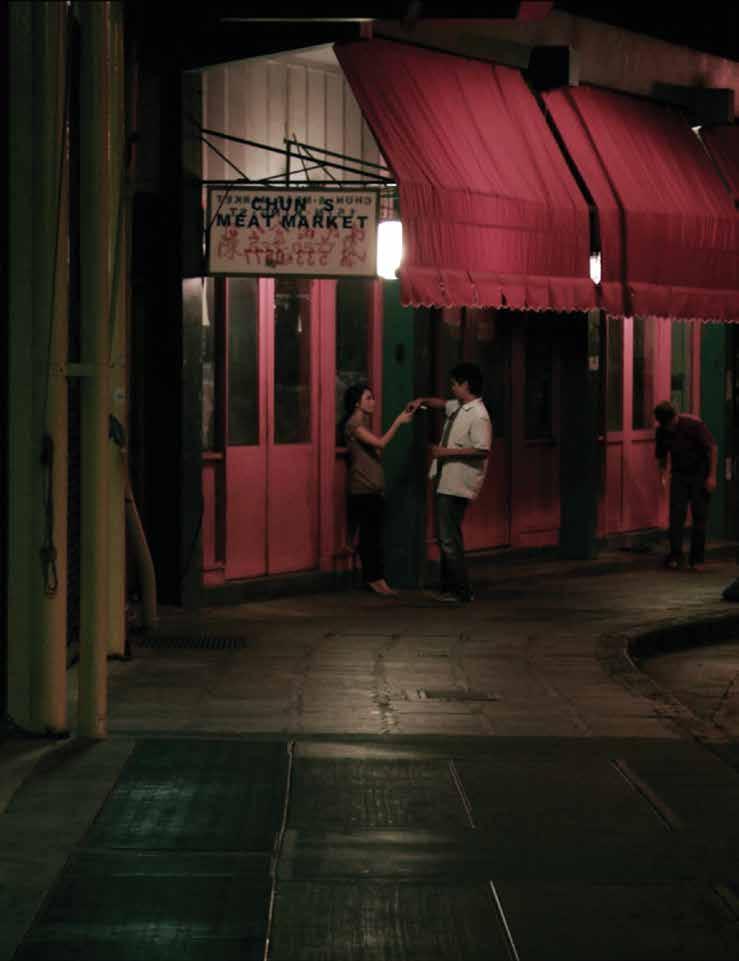
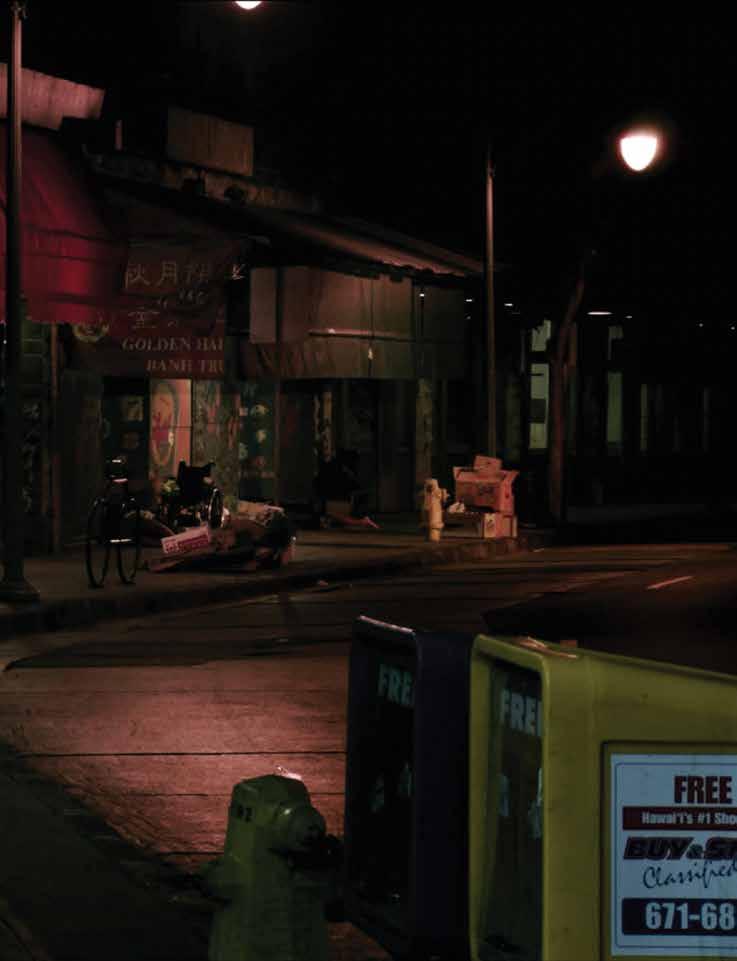
VB I’m happy to be talking and to get an opportunity to revisit your work. It’s beautiful seeing the common threads, repeating motifs, and even some of the same actors in your films, and how they grow and evolve throughout the years. One thing that stood out to me in particular were the repeated shots of [tower] cranes.
CMY You know, there’s that old joke, the crane is the state bird of Hawai‘i [laughs]. Everywhere you look, there’s a crane, there’s some kind of development going on. Hawai‘i is a place that’s being pulled in two different directions, and the crane is a really great encapsulation of that.
VB It’s especially emblematic of this idea of Hawai‘i as a construction, both literal and figurative. Layover, on the Shore (2009) concludes with ambient sounds of construction. In I Was a Simple Man, they open the film with an almost aggressive loudness. How have those ideas evolved for you between the two films?
CMY I actually hadn’t watched Layover, on the Shore in many years, and only just recently took a look at it because I had forgotten what a lot of the film was. There’s a theme that runs through both works, of buildings, concrete, development. While producing Simple Man, so much of what I was thinking about was this idea of the land being covered up. The concrete being this mud that envelops everything. Over the course of the film, nature breaks through in spite of that. Before shooting, Akiko [Masuda, an actor in August at Akiko’s] was telling me how she grew up in Kalihi before moving to the Big Island in the ’80s. I asked her if she ever came back. She said, “No, I never go back. When I go back, it’s just concrete…that’s all I see, everywhere.” And when I got back, that’s all I ended up seeing too. But sometimes I would be walking around and I’d see roots busting through the concrete, or a plant emerging through the cracks in the wall. Akiko is right that there’s concrete everywhere now, but over time, if you were to take a more geological view of time, I think nature wins.
VB Nature eventually reclaims itself.
CMY Exactly, given time. Simple Man is essentially telling that story. In regards to the soundwork, that was something we found in post-production. We knew there would be some kind of industrial sound at the beginning, but we didn’t know we were gonna go that big until we were in the mix. I just love this idea of confronting the audience upfront with an
abrasive wall of sound that they must pass through. It’s something like an entrance or a cleansing. You have to pass through this grinding barrier, then the film starts in earnest, becoming a much quieter experience onward.
VB Sound in general plays a beautiful role in your films. I grew up in an area that had relatively little development, then came a Wal-Mart, a few shopping centers, and then the rail, so those construction sounds ended up becoming very familiar to me.
CMY Yes, and that’ll continue, cause the rail will definitely make noise, even though they say it’s supposed to be pretty quiet. It’ll be like living by a subway in New York, just a constant sonic interruption in daily existence.
VB I wanted to mention the role that Hawai‘i and Hawaiian politics plays in your films. They’ve always been present in your work, but Simple Man defines its presence more clearly.
CMY It’s important that Hawai‘i’s political dimensions are incorporated into the work on a more subtle level. They aren’t necessarily making up the narrative of the film, but they are integral to the tellings of the stories. The production of Simple Man was a really interesting experience because we started shooting in the midst of the TMT protests, which rippled out to the rest of the islands. We were in this production bubble on the North Shore, and it wasn’t until the first weekend of shooting that I figured out through social media what was going on at the mauna. Throughout Hale‘iwa, we saw all these flags coming up, and there were protests going on that were impossible to ignore in this very exciting, energizing way. We were seeing the movement awaken, the nation rise, it was so beautiful. Meanwhile, here we were shooting this movie, which suddenly started to feel totally unimportant [laughs]. At one point, I asked myself, “Should we stop shooting?” The statehood elements were already integrated into the script, but during production, it felt even more important that Hawai‘i’s colonial history was incorporated in a way that hopefully inspires those unfamiliar to seek out, to learn more. It touches upon it enough, I hope, that it will motivate viewers to educate themselves.
VB The political potential of films should never be doubted, I think, even if their function is more reflective than propulsive. I saw Occasionally I
52 | FLUXHAWAII.COM
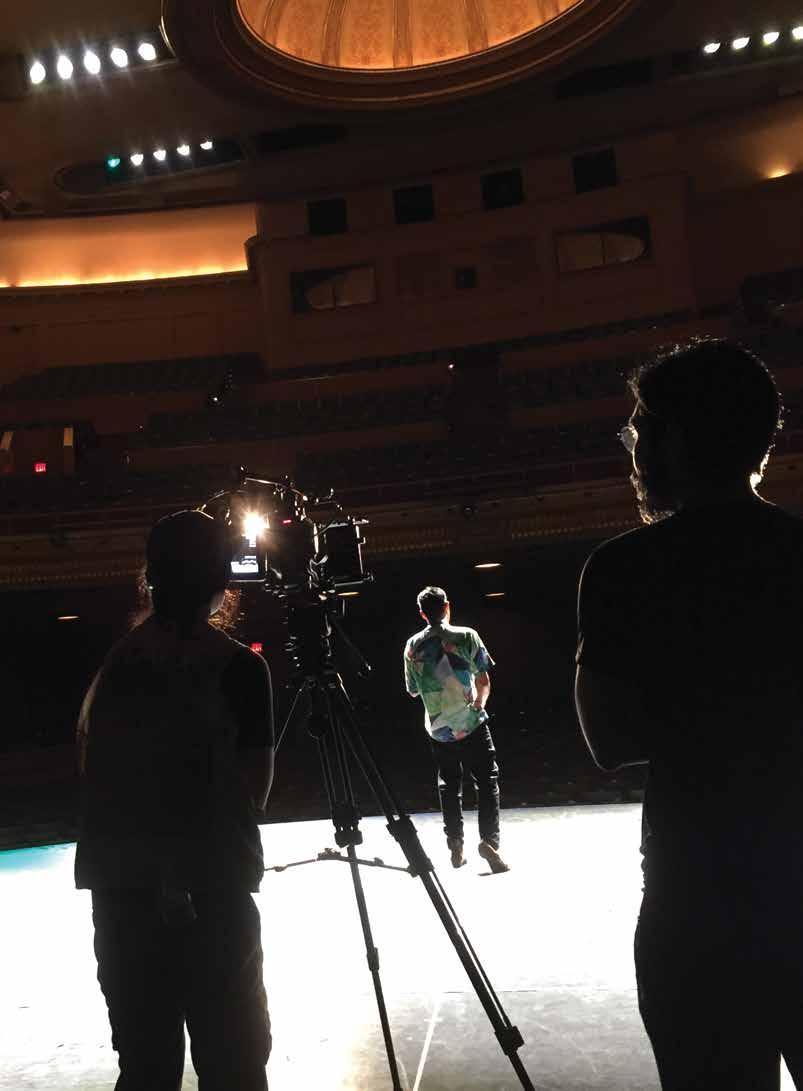
Saw Glimpses of Hawai‘i (2016) and Anthony Banua-Simon’s Cane Fire (2020) around the same time, which made it click for me that there are ways, even through recontextualized imagery alone, to politically subvert the narrative imposed on Hawai‘i. Both are a sort of destruction of images, a catharsis.
CMY When I made Occasionally it was never supposed to be a film project. It started off as me just saying, “I’m gonna sit down and watch these images that I’ve avoided for my entire life.” Growing up in Hawai‘i, I thought, “Why should I waste my time watching these movies? They’re not for me. They’re for the outside world.” I eventually came to think I should at least be in dialogue with them and educate myself on what these images are. So I started to watch everything. I started to see films quoting films quoting films, artifice upon artifice upon artifice. The most interesting part, though, was when it played at HIFF. Most of Occasionally came from a very angry place. Then at the screening, people would come up to me and say, “That film was so beautiful, it reminded me of my childhood, it took me back to the good old days.” Cinematic images become memory in this way that’s almost indistinguishable from our personal memories. It becomes the lens in which we look through our own lives. It remotivated me about the importance of producing images that counteract that narrative, not only for the rest of the world, but for people who have lived in the islands their entire lives.
VB There’s a certain comfort in those colonial fantasy Hawai‘i depictions that a lot of people I know find warmth in. It’s unfortunate that it takes up a large bulk of what we have to work with.
CMY I guess in a way I shouldn’t have been surprised at their reactions. For me, growing up with the version of Hawai‘i that’s sold to the world created a real cognitive dissonance. I’m still questioning what a real Hawai‘i is. Of course, my experience of everyday life there differs from that of my friends, people I don’t know, other parts of the islands, the outer islands…these questions were always spinning in my head. For me, the reaction was a sense of detachment from Hawai‘i as a young person. I felt very alienated from the place in which I was living. Now, I look back and think, “That’s really unhealthy.”
VB Would you say it took leaving the islands to gain that renewed connection?
CMY When I left the islands to move to LA, I was in this very disorienting period of my life. My father had just passed away, and at the same time, I was living outside of the islands for the first time of my life. It was a period that was full of grief and longing which channeled itself into a deep sense of homesickness. Every time I sat down to write, the pieces would be set in Hawai‘i. I was already interested in telling stories from a local perspective, but it didn’t really crystallize until after I had left.
VB Did the films you watch over the years shape your idea of what’s possible within Hawai‘i?
CMY One-hundred percent. The biggest influence was the Taiwanese New Wave. It wasn’t until I started watching films by Hou Hsiao-Hsien, Tsai Ming-liang, and Edward Yang that I started to understand cinema’s ability to capture the history of a place in a way that’s both personal and incredibly artful. They’re all touching upon the history of colonialism in Taiwan, often not so overtly, and it opened my brain to the possibility to tell stories about home that are simultaneously localized, personal, political, and cinematically progressive.
VB Layover felt a little like a Tsai Ming-liang film to me. [Yogi laughs.] I really appreciated those shots of the Chinatown streets at night for that reason, and another, more incidental one—you were capturing an era of Chinatown that doesn’t really exist anymore. So much of it looks and feels different today.
CMY Yeah! That goes back to what we were talking about earlier in how film can incidentally capture a specific window of time.
VB Have you seen Los Angeles Plays Itself? There’s a quote from it that goes, “If we can appreciate documentaries for their dramatic qualities, perhaps we can appreciate fiction films for their documentary revelations.”
CMY That’s amazing. When I think of fiction and documentary, it’s more of a spectrum than it is a binary. Obviously, hybrid filmmaking is really in vogue now, but even creating fiction films, you can’t control everything, and every documentary film has elements of fiction in it.
VB Even towards the beginning of the documentary form, you have stuff like Nanook of the North, the city symphonies, it’s all very deliberately constructed.
54 | FLUXHAWAII.COM
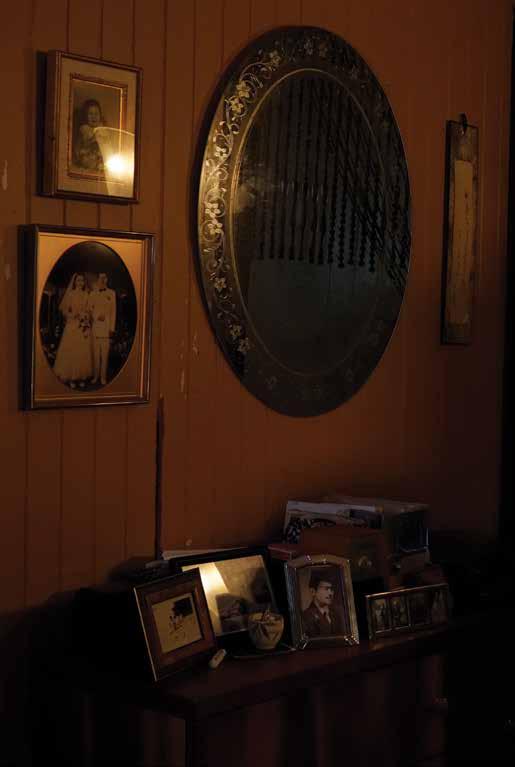 I Was A Simple Man , written and directed by Christopher Makoto Yogi, is set in the pastoral countryside of the north shore of O‘ahu, Hawai‘i. Told in four chapters, an elderly man facing the end of his life is visited by the ghosts of his past.
I Was A Simple Man , written and directed by Christopher Makoto Yogi, is set in the pastoral countryside of the north shore of O‘ahu, Hawai‘i. Told in four chapters, an elderly man facing the end of his life is visited by the ghosts of his past.
CMY It’s funny that where cinema started was more or less operating in that hybrid form, then somewhere along the way it got barricaded off into a binary when they crossover more than we would like to think.
VB On the other hand, you have stuff like the shorts of Lumière and Edison that are incredibly pure. Technologically, it was a miracle to document a baby eating, people shuffling around, the waves crashing, things like that. There’s a certain purity of vision. In your films, the way you and [cinematographer] Eunsoo Cho film plants, the mountains, the sky—I feel that same sense of wonder. Sometimes it really is just about pointing your camera and shooting.
CMY Getting back to that sense of beginner’s mind, that purity, was basically the goal. Before I start every film, I try to forget everything and start from zero to see what we can come up with. Leaving Hawai‘i gave me an ability to more easily inhabit that emptied state of mind. For example, I’ll come back and be completely blown away by the clouds. When the sound of rain in Hawai‘i is no longer a thing I’m hearing every day, upon returning, it becomes this incredibly evocative music that I haven’t heard for so long, and I’m like, ‘Oh my god, I’ve missed this so much!’ I’m glad you mentioned that because, for me, that’s the intention. To see the everyday anew.
VB The beauty of Hawai‘i is undeniable. It’s also, unfortunately, the tourism industry’s most valuable commodity. How do you respond to this contradiction and represent its beauty in a way that feels new, subversive, or pure to you?
CMY If you asked me this when I first started to think about cinema, I would’ve thought to reject those images completely and be like, “We’re not gonna interface with that at all,” and that would be the radical statement. Now, I feel like that would be a bit dishonest because the beauty is certainly there. I find emotion out of the nature, the ocean, the mountains. It’s not about refusing to engage with that grammar at all, but finding a way to personalize it. With Layover, on the Shore, the city and the country are split in a way that makes their differences apparent. Like, here’s the city, which is supposedly more gritty and real, and here’s the country, which is supposed to be more fanciful and constructed and based on the presumed ideas of Hawai‘i. The fact that they are split up in that way shows where my brain was at the time, whereas now I don’t think I would be as didactic. Each
part is both imagined and real at the same time. Cinema is one of the great art forms where we can interrogate these tensions. Now that there are more artists telling their personal stories here, it complicates the entire narrative in a way I think is healthy and beautiful.
VB I’m definitely excited for the future and how it seems the local film scene is cross-pollinating. The first batch of graduating classes from UH Manoa’s film program are now mature enough to be producing features. You have professors coming to these students with an explicitly Indigenous perspective.
CMY What was really important was that I was able to be a part of a filmmaking community in Hawai‘i. Up until that point, I didn’t know a lot of filmmakers or people who were interested in cinema. It was really only our small group of friends who were just screwing around and having fun creating things. But then to contextualize it amongst this diverse group of people who are all interested in film and all telling their specific stories, we were encouraged to look at Hawai‘i as a legitimate place to create films. It’s strange that it should seem like a radical thing, but if you’re growing up here, there isn’t really much of an arthouse scene or cinephile culture. A lot of the films we were watching were big Hollywood movies, and it wasn’t until I watched those Taiwanese New Wave films where I was like, ‘Oh, this is possible!’ To couple that with a community of filmmakers, it’s like, if this continues to grow, then this could be a thing. Fast forward a decade later, it has become a thing. It really is exciting. At the most recent Hawai‘i Shorts program at HIFF, I was almost gonna cry, it was so beautiful. The ambition of the filmmakers there, their craft, every year it just seems to level up.
VB It feels like local filmmakers are more in dialogue with each other’s work than ever.
CMY When I was at Mānoa, it seemed like the only avenue people were trying to enter was Hollywood filmmaking because that was how limited our scope was. Now there’s cross-pollination, the work is in dialogue with one another, and the craft is evolving much faster now than it ever seemed to be before.
VB My last question is more practical. For those who would like to tell non-traditional stories such as yours, what was the process of procuring funds for your films like for you, and is it any more easy or difficult from when you first started making films to now?
56 | FLUXHAWAII.COM
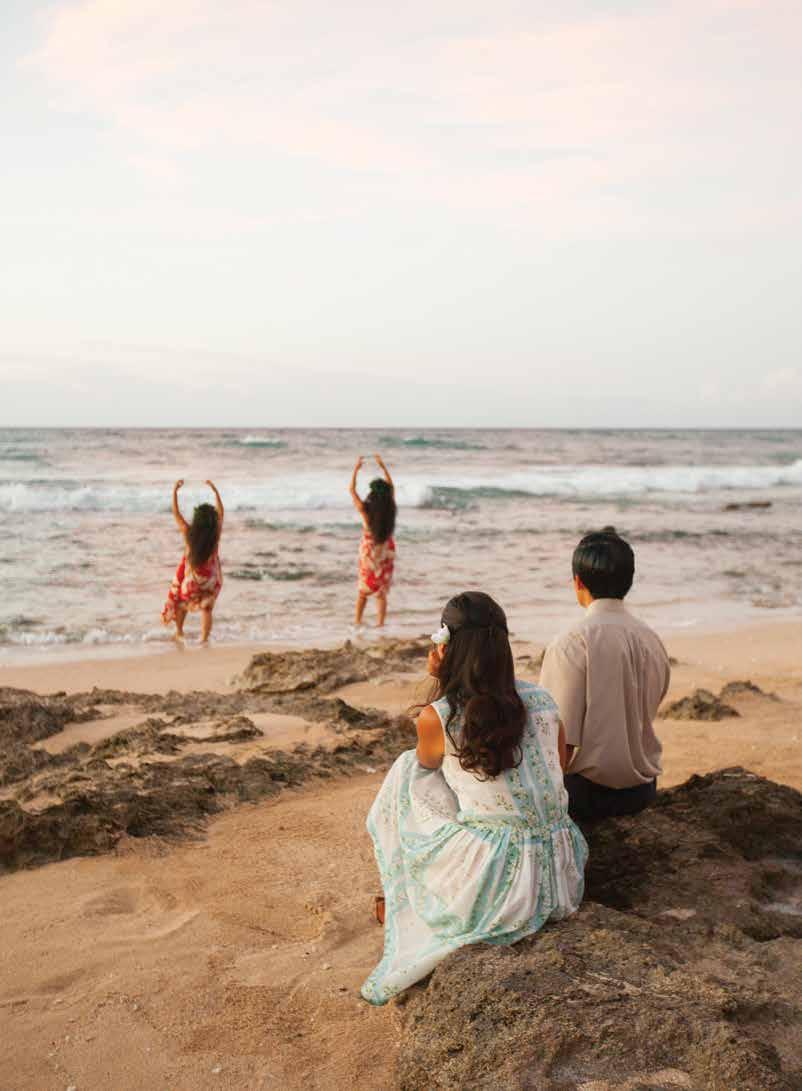

CMY It’s definitely still difficult. Every independent filmmaker would say that raising funds is the hardest part of the development process. You can have a great idea, you can have tons of passion, but you really do need the resources. We were trying to make Simple Man for a very long time and found it impossible to get the financing. We took a break from raising the money to make August at Akiko’s simply because we were kind of burnt out trying to get the film made. We created it for a shoestring budget and a very small crew, which was like a palate cleanser for us. There was a laboratory-type atmosphere that allowed us to try things, play around, to have fun, to do what we want and not be beholden to anybody. That freedom reinvigorated my own love for filmmaking. After making that film and coming back to Simple Man, I came back with a renewed confidence. The success of August
at Akiko’s proved to investors it was possible for us to make a film that is embraced by people all around the world, and that there is an audience for it. Raising money still wasn’t easy [laughs]. But it was easier. We could now say, “Here, this is another film we made for much less money, it premiered at a great festival, it has acclaim…” Financiers could trust us more with something a little bit bigger.
This conversation has been edited for length and clarity.
Search online to find the most current streaming options for
The exterior of Masao Matsuoshi’s home feataured in I Was a Simple Man
58 | FLUXHAWAII.COM
the film.
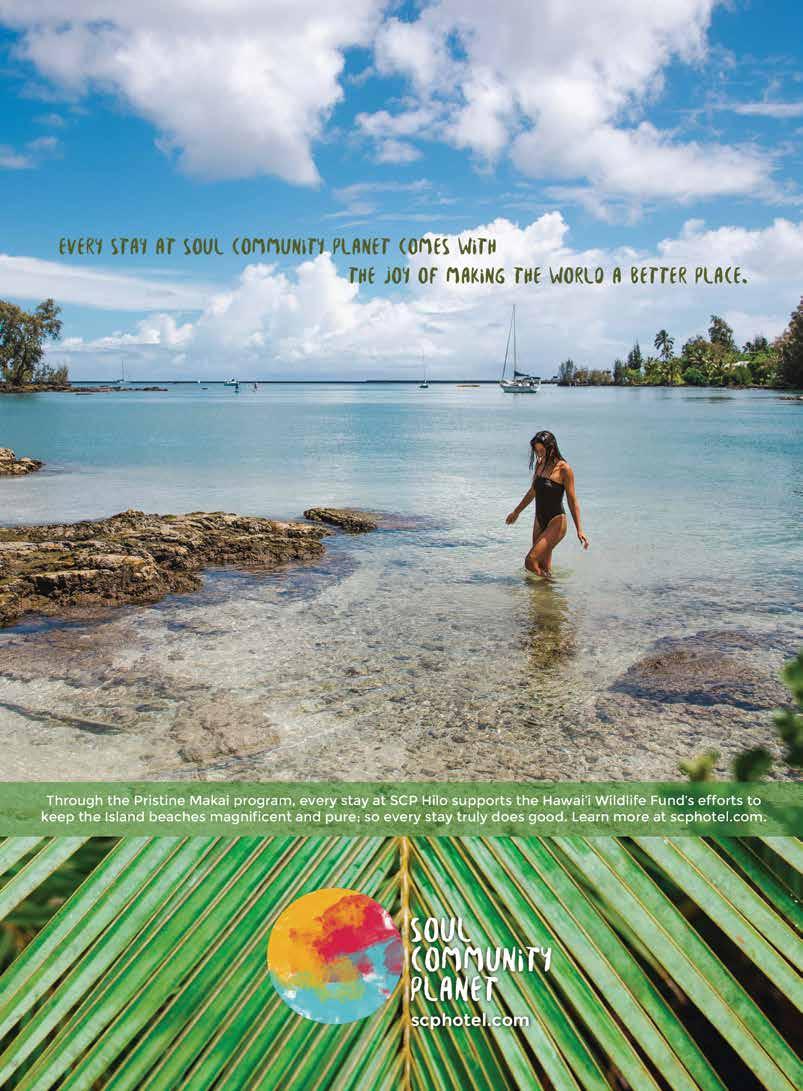
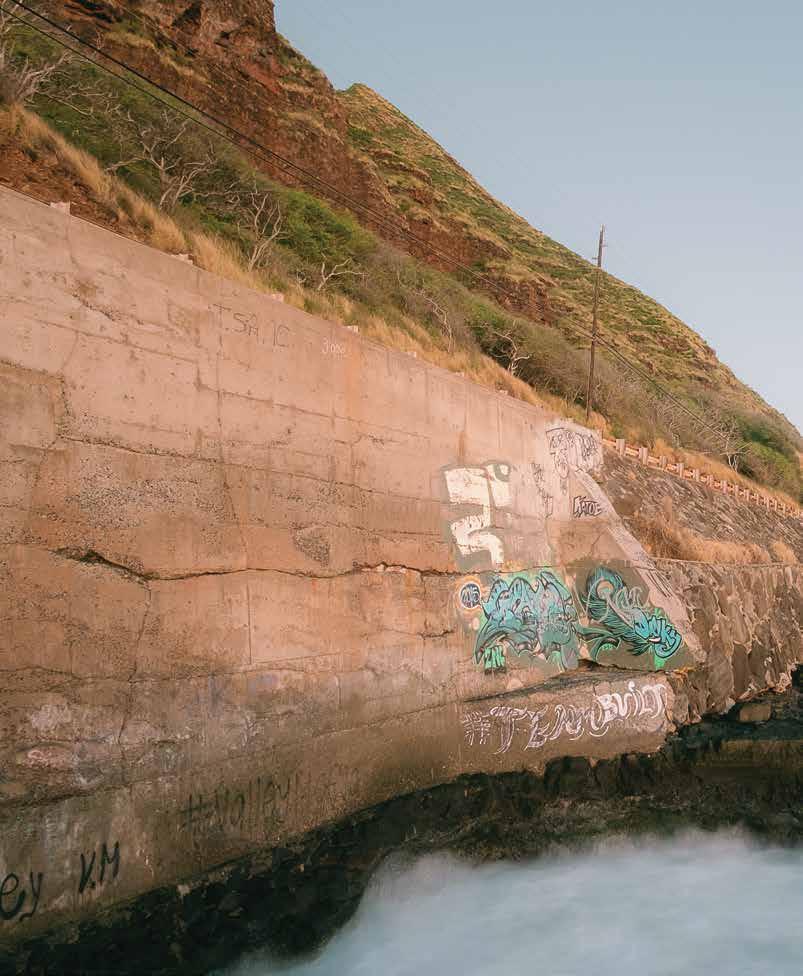 A view of O‘ahu’s west side. Image by Josiah Patterson.
A view of O‘ahu’s west side. Image by Josiah Patterson.
FEATURES
“There it was, a danger of forgetting.”—W. G. Sebald
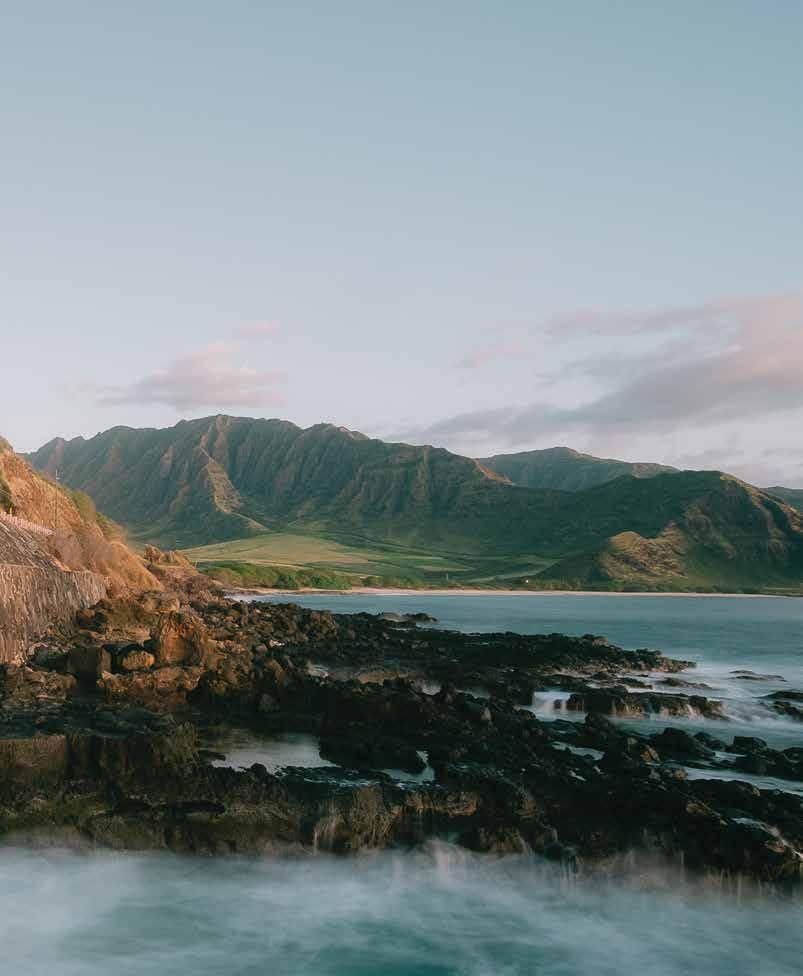
FLUX FEATURE
Unsettling Carto g ra p hies
Political change depends on getting people to see a story the same way. This stubborn truth frustrates activists who seek justice by reimagining and reclaiming Hawai‘i’s maps.
 TEXT BY JACK TRUESDALE
ART BY SEAN CONNELLY & KEKAHI WAHI
TEXT BY JACK TRUESDALE
ART BY SEAN CONNELLY & KEKAHI WAHI
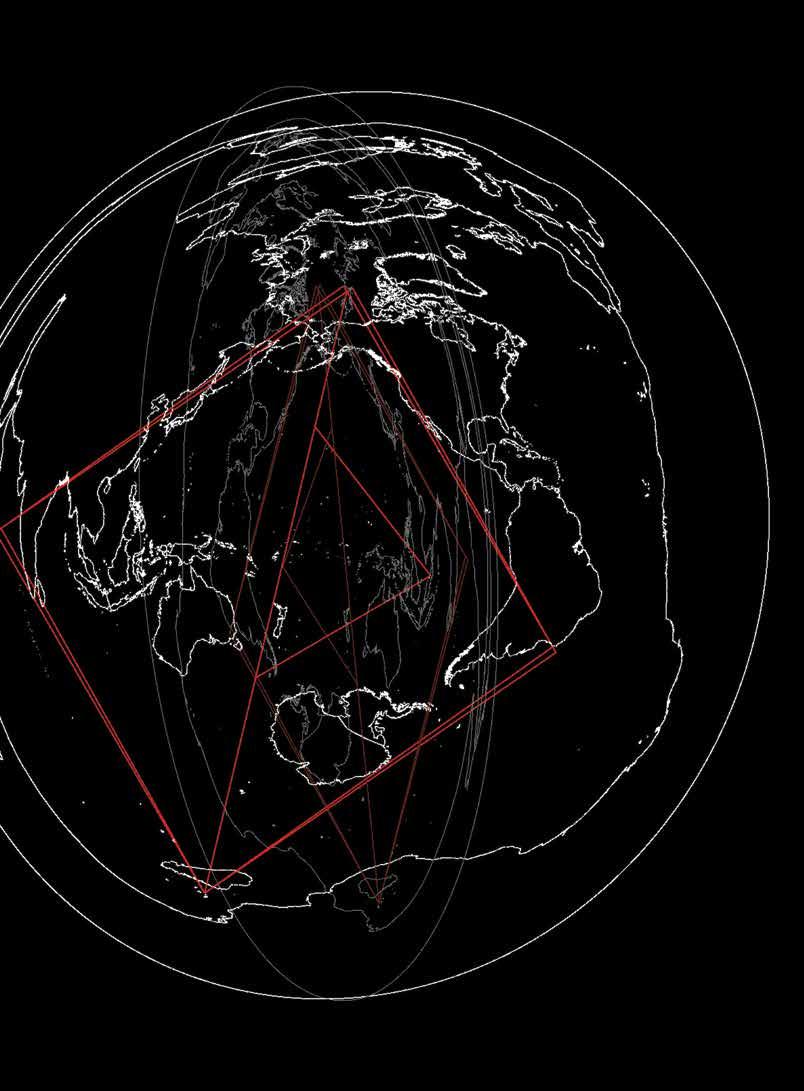
Two weeks after the 80th anniversary of the bombing of Pearl Harbor, the U.S. Navy announced that 19,000 gallons—5,000 more than an earlier figure—of fuel mix spilled downhill from its Red Hill Bulk Fuel Storage Facility in Honolulu. The facility’s 20 underground fuel tanks, built 100 feet above a major aquifer during the Second World War, were known to leak. Military and civilian families alike were turning on their taps and smelling fuel. Those who drank or showered in the water suffered rashes, sores, stomach aches, and nausea—about 2,000 people reported falling ill. More than 3,000 military families left their homes for temporary lodging in hotels. Honolulu shut down three drinking wells, fearing contamination. In March 2022, following mounting criticism, and after the Navy vacillated on whether to fight the state in court, the Pentagon announced it would close the facility permanently. By April, however, there was still no consensus between the Navy, academics, and regulators about where the contamination was moving.
The plot advanced in numbers. The setting was infrastructure—underground pipes, wells—and the characters were bureaucrats, institutions, and victims. Ours is a purportedly secular society, and drinking fuel-contaminated water harms people no matter what they believe. But throughout the fuel leak crisis at Red Hill, the area originally known as Kapūkakī, a necessary context seemed absent. The landscape of Hawai‘i is woven with mo‘olelo, or orally transmitted stories, that store generations of knowledge and patient, detailed observations of the natural world.
I hoped one of these stories might reveal what more was at stake, and the mo‘olelo of Keaomelemele presented an image of a miles-long path packed bumper-to-bumper with 30-foot-long lizard deities, known as mo‘o, migrating from the North Shore to Honolulu. The story of mo‘o migration was a record of a changing climate, according to University of Hawai‘i Mānoa English professor Candace Fujikane. “The arrival of the mo‘o signals a historic moment when Kānaka Maoli began to pay greater attention to the care and conservation of water and the cultivation of fish,” Fujikane writes
in Mapping Abundance for a Planetary Future: Kanaka Maoli and Critical Settler Cartographies in Hawai‘i. With that new concern for water, Kānaka Maoli could imagine in the migration of the mo‘o a network of waterways above and below ground, connecting the land’s far-flung ecosystems. These deities became known as guardians of streams, springs, and fishponds. “Today, it is at Kapūkakī that the mo‘o engage in battle with monsters that lie beneath the surface of the land,” Fujikane writes.
I first encountered Fujikane’s work in college. Asian Settler Colonialism, a collection of essays she co-edited and wrote the introduction to, explored how Asians have helped develop Hawai‘i as a “U.S. colony” through the state legislature, prisons, the military, and the arts. Fujikane, who was born on Maui, calls herself a “fourthgeneration Japanese settler aloha ʻāina.” I followed Fujikane’s output since reading the collection, and I thought that Mapping Abundance, published in 2021, might illuminate the Red Hill spill.
In Mapping Abundance, Fujikane recounts the past decade of activism in Hawai‘i, chronicling attempts by developers and the occupying settler state to “wasteland” the ‘āina—framing it as lacking all but a potential for development—while activists including herself fought to reveal those lands’ abundance. Yet she finds opportunity in others’ apocalypse. The current way of seeing land through “cartographies of capital”—expedient abstractions of complex lands for profit—facilitates the extraction and pollution driving climate change, she writes. And yet, climate change heralds the end of capital, she further explains, “making way for Indigenous lifeways that center familial relationships with the earth and elemental forms.”
In several episodes where capital— developers, the state—depicted lands as scarce, the activists deployed “Kanaka Maoli and critical settler cartographies” to find what the land could provide in not only food and water but also wonder and hope. Sometimes that’s literal, but sometimes that’s less obvious, identifying
Mo‘olelo are rife with double meanings and double entendres. They aren’t always what they appear to be.
Opposite, digital architecture model taken beneath Mānoa stream comprising abstracted GIS rainfall and wind data. Still facing mauka, near Mānoa Shopping Center, Mānoa, O‘ahu, Hawai‘i. Opening spread, from AFRICA-PACIFIC (2014), a digital mapping project by Sean Connelly.
64 | FLUXHAWAII.COM
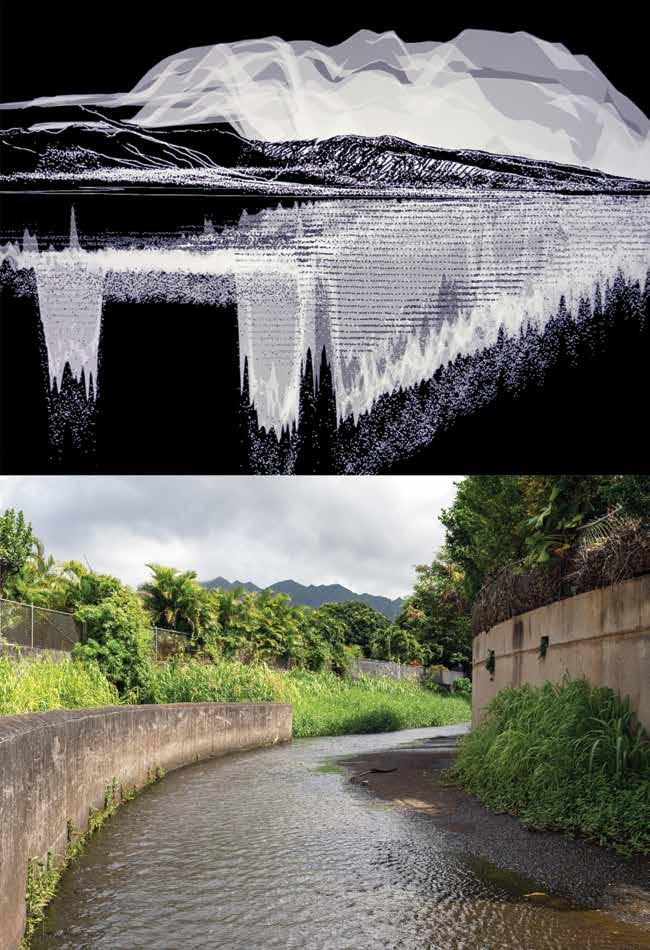
the elemental forms of nature, the akua, which, Fujikane writes, “were identified and named based on the ancestral insights into the optimal workings of interconnected ecological webs.” Just as the developer tells a story of a purported wasteland to develop it, activists tell a story of abundant land to preserve it.
Learning from mo‘olelo, like any story, requires some to suspend disbelief. Mo‘olelo are rife with double meanings and double entendres. They aren’t always what they appear to be. Seeing these stories come to life in the landscape requires some degree of imagination. One story Fujikane calls a “genre of wonder” encourages “listeners to challenge the limits of our conceptions of what is possible and to deepen our imaginative capacities.”
And yet political change depends on getting other people to see a story the same way. Fujikane devotes a chapter to demonstrating how this stubborn truth frustrates her careful methods. In 2010, local activists protested the proposed development of an industrial park in Wai‘anae. Locals argued the development, ignominiously named the Purple Spot, opened the door for yet more development, inevitably eroding their agricultural district. They also worried it would desecrate the storied birthplace of Māui, the supernatural being who pulled the islands from the ocean’s depths with a fish hook.
The dispute evolved into a contested case before the state Land Use Commission. In the commission hearing room, the developer’s attorney presented a five-gallon-bucket of the land’s rocky soil to suggest that it wasn’t good for farming. In Fujikane’s eyes, he reduced complex, storied lands to merely “dirt held in suspension, isolated away from the histories, stories, material practices, and people of the place from which the dirt was taken.”
The developer’s view of the land relied on “stark line drawings paralyzed in time” that “abstract, compartmentalize, and encode the intimacies of land into a ‘parcel’ and a ‘project area.’”
As a counterpoint, the activists projected onto the wall of the hearing room photographs from 1968 of the land’s bounty: farmers held watermelons in green fields. In her own testimony, Fujikane presented maps issued by the Land Study Bureau in 1972 that show the land in rows of green. The visuals suggested that the developer assessed the land in its unirrigated state to prove it was “unproductive.”
The developer was also required to commission “cultural impact assessments,” which resulted in an 11-page evaluation for the property itself and a 145-page evaluation for the surrounding land that contains places described in the Māui mo‘olelo. Comparatively, according to the developer’s reductive argument, the page numbers of these assessments—11 versus 145—suggested the proposed development was less culturally relevant than its neighboring plots. But in isolating the land from its surroundings, the developer was practicing what Fujikane calls “a settler mathematics of subdivision.”
Testifying against the development, one local asserted, “These boundaries were not known to our ancestors.” In her own research outside of the hearing room, Fujikane had been sifting through maps of land commission awards from 1851, where she noticed the term “mo‘o” cropping up. It was a shorthand for “moʻoʻāina,” smaller land sections connected within a larger land base, “genealogically connected to one another across ahupuaʻa, as the long iwikuamoʻo (backbone) formed by the moʻo akua in Moʻoinanea’s genealogical line,” Fujikane writes. Like the waters coursing away with fuel spilled from Red Hill, these lands too were connected.
The developer’s attorney asked for documentation of Māui’s exact birthplace. The meaning of the mo‘olelo, however, is not always forthcoming from text alone, Fujikane writes. On a kūpuna-led bus tour through Wai‘anae, Fujikane witnessed the Māui mo‘olelo
come alive as she moved through the landscape. Driving along Farrington Highway, an elder located Māui’s evolution—hatching from an egg as a chicken then evolving into a man in the landscape. The elder identifies Pu‘u Heleakalā as “an egg lying on its side,” then “two peaks that form a beak emerge as a chick hatches from the egg,” Fujikane writes. Turning up toward the mountains, “the silhouette of a beaked man with a wattle” appears, she writes.
“As we continue up Hakimo Road, the silhouette finally transforms into the rugged facial planes of a handsome man.” Māui’s exact birthplace, in other words, was all around, visible in full only by traversing the land.
The elder explains, “One thing about Waiʻanae is we want to save our viewplanes because that’s where our stories are.” With her cultural memory stored in the mountains themselves, each glance renews the mo‘olelo told long before. One night, under a full moon, the elder took Fujikane to Hakimo Road to look at Māui’s profile. “Oh, look at him!” the elder says. “He is one handsome brotha, you know what I mean?”
The development was eventually called off over an issue about an easement rather than the cultural grounds the activists argued. A Judas had emerged in the form of a cultural practitioner who stood to profit from a community benefits package and claimed that the land was, in fact, a wasteland. “And because of this testimony the land use commissioners asserted that there was ‘no consensus’ on the significance of that land,” Fujikane writes.
Legally, the state isn’t built to buy in either. Fujikane later describes the contested case against the construction of the Thirty Meter Telescope on Maunakea, when activists attempted to make Mo‘oinanea, the mo‘o matriarch deity, a legal party. They claimed she dwelt on Maunakea and therefore had a vested interest in the land. The Bureau of Land and Natural Resources denied the request. “The information provided
66 | FLUXHAWAII.COM
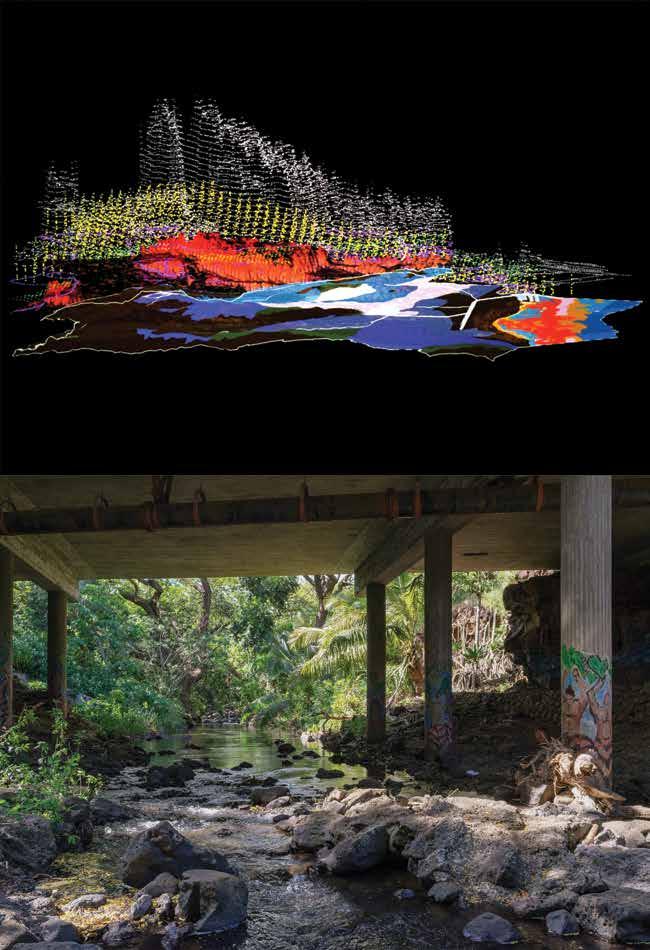
FLUXHAWAII.COM | 67
indicated that Moʻoinanea is a spirit, not a person, and as such does not meet the requirements of Haw. Admin. R. §13-1-31 and 13-1-2 to be admitted as a party,” the bureau wrote in a resolution. (According to the latter law, “person” includes corporations and other organizations. Four decades ago, another non-human resident of Maunakea, the palila, an endangered native bird species, sued the Department of Land and Natural Resources for letting goats and sheep eat the last of its habitat. The bird, represented by the Sierra Club, won.)
On a Tuesday in December 2021, I took a bus to Hickam Air Force Base, where the water was reported to be contaminated. The bus slowed to a halt at a checkpoint, and a man in uniform stepped aboard and asked me for my military identification (non-existent). I flashed my driver’s license, he shook his head, and I shrugged and walked out of the checkpoint. I was there reporting a story about Red Hill’s fuel contamination crisis, trying to get a feel for the scope of the issue, but also its more lasting environmental, cultural, spiritual— call it what you will—impact on the island. Pinching my way through Google Maps, though, I could see no subterranean network of water running throughout Honolulu, no obvious signs of meaning that others before me had found in the land.
The date—still alive in infamy, depending on whom you ask—was December 7th. The same day 80 years before, Japan attacked American territories throughout the Pacific including, infamously, Pearl Harbor. That morning I walked around the memorial, which was populating with visitors in veteran’s hats. Although the attacks occurred on the same day, the Pacific Ocean straddles the international date line: December 7 in Hawai‘i was December 8 in other regions that Japan targeted. In an earlier draft of the speech he would give to Congress, President Franklin Roosevelt framed the main attacks as a “bombing in Hawaii and the Philippines.” I had originally learned this from the historian Daniel Immerwahr’s book, How to Hide an Empire. Now there it was on an 80-year-old typewritten draft in a
glass case at the memorial: Roosevelt drew a pencil through the two names and wrote “Oahu.” By the time he spoke, he called it “the American island of Oahu.” It was a presidential act of cartography—zooming in and cropping to a limited geography and chronology—that determined what would be remembered to this day. Perhaps remembering the same-day attacks on Pearl Harbor and the Philippines and Midway Island and Wake Island and Guam (and a host of British colonies including Hong Kong) would have proven cumbersome, or just narratively inconvenient. The rest of that morning, I walked through an old submarine and chatted with dewy-eyed veterans. In the gift shop sat a stack of facsimile St. Louis Star-Times newspapers dated Monday, December 8, 1941. The headline: “WAR DECLARED.”
Two months later, I spent a night on Hawai‘i Island, on the black lava fields south of Pāhoa. Lava undulated from the volcano to the water thirty years before, and now only spare ʻōhiʻa and other shrubs grew from the soilless, newborn land. I stayed in a plywood bed and breakfast on stilts over bare rock, in a neighborhood of other Burning Man-esque hippie cottagecompounds. I was chuffed to find W. G. Sebald’s novel Austerlitz on a communal bookshelf, sandwiched between a perplexing combination of woo-woo tomes on magical thinking and Ayn Rand.
I couldn’t help imagining the land of Red Hill, missing its context and memory, as I read Sebald’s narrator recall a map of a Nazi prison camp. He contemplates that “everything is constantly lapsing into oblivion with every extinguished life, how the world is, as it were, draining itself, in that the history of countless places and objects which themselves have no power of memory is never heard, never described or passed on.” There it was, a danger of forgetting.
Later in the novel, the titular character imagines what existed where a London train station stands: “The little river Wellbrook, the ditches and ponds, the crakes and snipe and herons, the elms and mulberry trees … had all gone … and gone now too are the millions and millions of people who passed through … day in, day out, for an entire century.” Dwelling in that place, recollecting,
Opposite, digital architecture model of above MānoaPālolo drainage ditch comprising abstracted GIS streamflow data and storm water drainage network. Still facing makai, near Market City Shopping Center, Waikīkī, O‘ahu, Hawai‘i. Previous, digital architecture model of Mānoa Valley looking toward Wa‘ahila Ridge, comprising abstracted GIS cloud cover and aquifer data. Still facing mauka, near Kamakakūokalani Center for Hawaiian Studies, Mānoa, O‘ahu, Hawai‘i.
About the artwork
All digital architecture models by artist Sean Connelly, who works primarily in architecture, sculpture, and experimental cartography. All stills by film collective kekahi wahi (Sancia Miala Shiba Nash and Drew Kahu‘āina Broderick), who document stories of transformation across Hawai‘i.
68 | FLUXHAWAII.COM
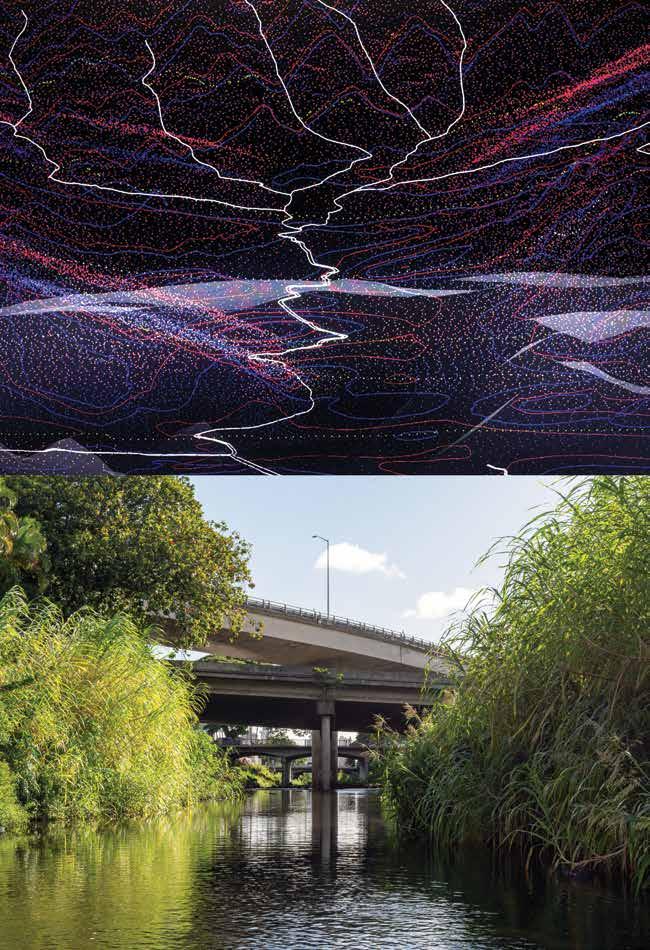
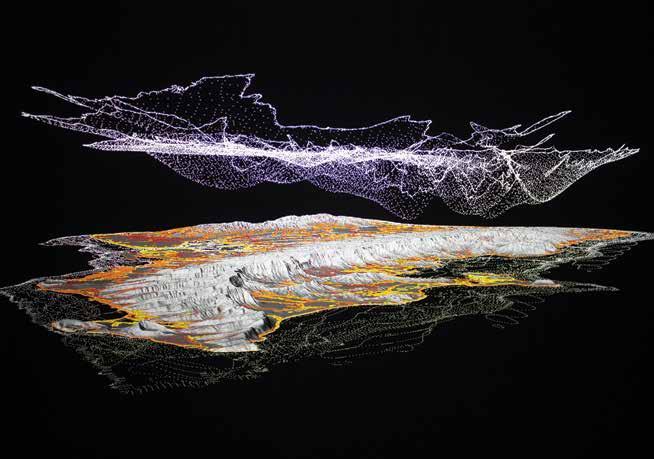
he says, “I felt at this time as if the dead were returning from their exile and filling the twilight around me with their strangely slow but incessant to-ing and fro-ing.”
Back on O‘ahu in December, I left the Pearl Harbor memorial in an Uber headed downtown. The driver asked why I was in town and then offered a detour. He pulled up to the entrance to the Aliamanu Military Reservation, a housing development downhill from the leaking fuel tanks, where the water was later found to contain levels of petroleum hydrocarbons three times the state limit. Its resident military families were relocating to hotels in Waikiki. A guard stopped the car (“unusual,” the driver said). A few dozen yards inside, an electronic sign was flashing: “Do Not Use The Water!” The guard turned the valiant driver away, and back we went down into Honolulu.
Beyond the military complex’s carbon copy housing, the barbed wire, the pavement, and the city buildings, I wasn’t sure I could make out what came before, what was lost and being lost. I couldn’t make out the stories of the land’s former Hawaiian
inhabitants, while another story—nationalist and grandiose—was already shaping the people here. The dead, albeit of a different demographic, were returning now too. I stayed on in Honolulu until evening to watch the hullabaloo before a commemorative parade at Kapi‘olani Park: Hundreds of red-white-and-blue cheerleaders flown in from the mainland, grade-schoolers-in-uniform, slack-jawed and dozing nonagenarians-in-uniform receiving yet more medals on stage. (“Everybody is still receiving a medal!” the master of ceremonies said, after thanking the event sponsor, the History Channel.) On the grass sat a two-story inflated Purple Heart float, a blow-up Navy jet bigger than a bus, a 20-foot-tall eagle with stars-and-stripes wings, and 12-foot balloons for the military’s branches. Here was a narrative complete with characters and gods, a mythology all its own. I wouldn’t know where to begin reconstructing what came before, but I could almost imagine the raw land and the people passing through here long ago, in the time between pure lava and this.
Above, from HI-ATLAS (2015) by Sean Connelly featuring O‘ahu’s annual rain data as a cloud combined with solar data representing the island’s aquifer. Opposite, digital architecture model of Waikīki comprising abstracted GIS soil type/ permeability/fertility data. Still facing makai, near Ala Wai Canal, Waikīkī, O‘ahu, Hawai‘i.
70 | FLUXHAWAII.COM
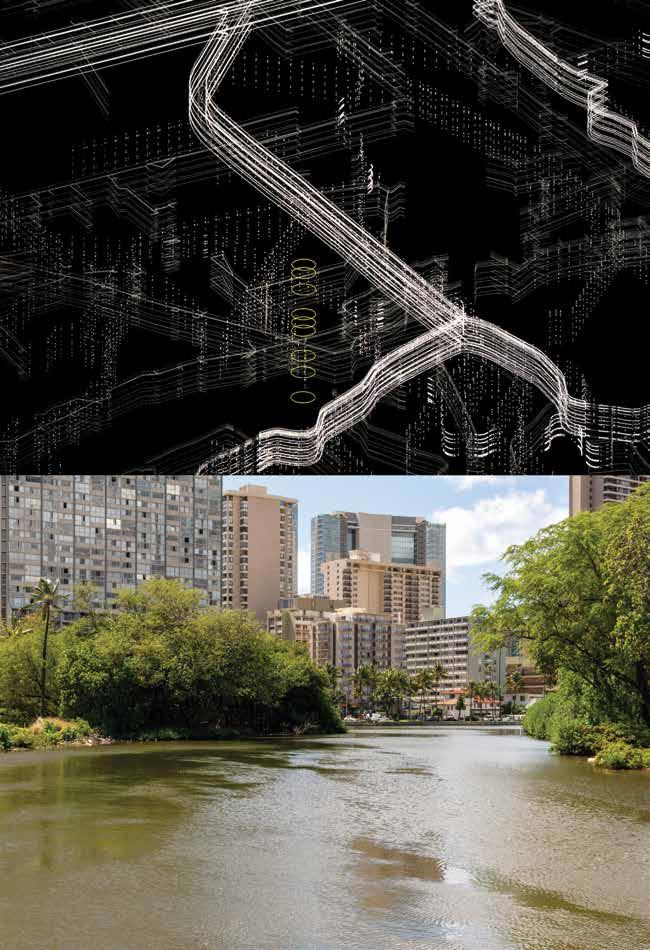
FLUXHAWAII.COM | 71
Keepers of Kaiser ’ s
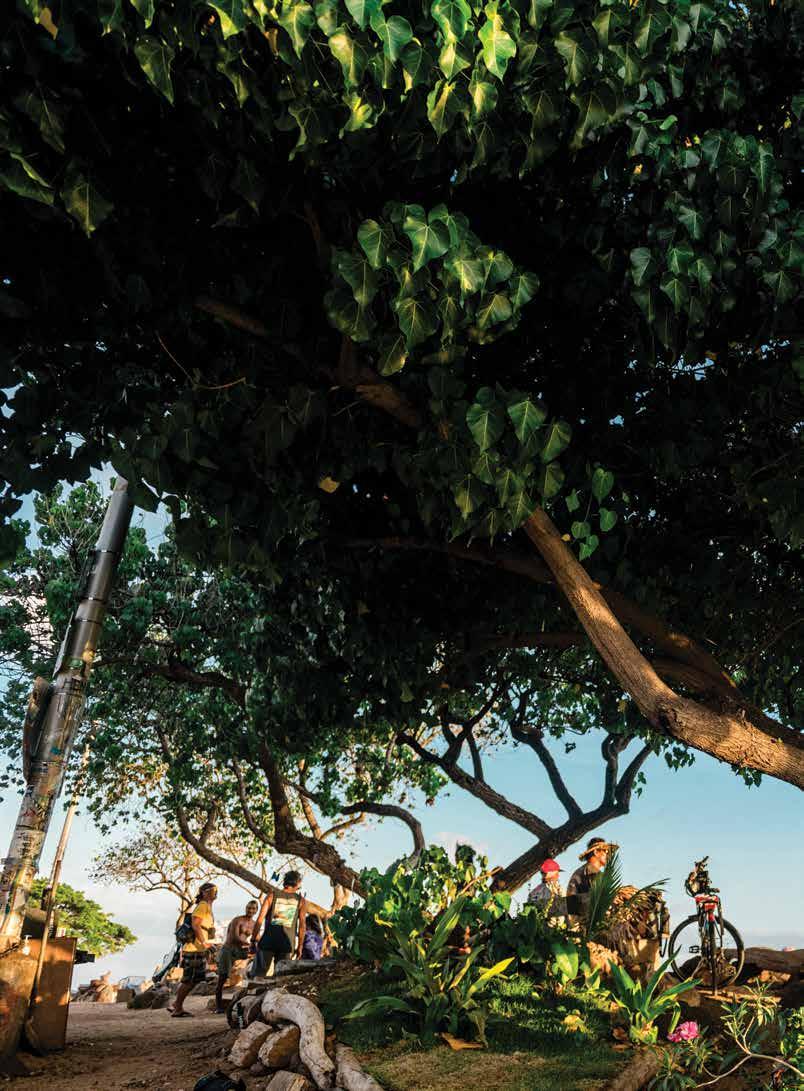
For generations, the Kaiser Surf Crew has established a presence in and out of the water. For them, Kaiser’s is more than a surf break: It’s community. It’s family. It’s Hawai‘i.
TEXT BY RAE SOJOT
IMAGES BY JOHN HOOK
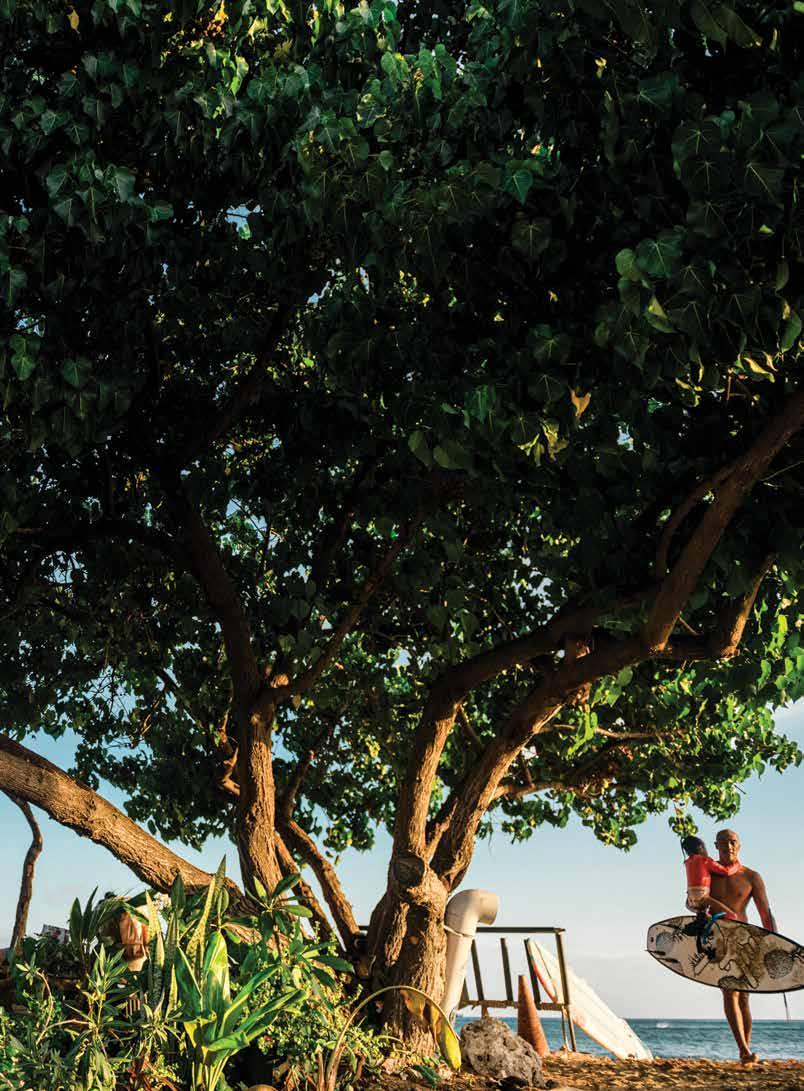
In 1954, when industrialist Henry J. Kaiser built his signature hotel, The Hawaiian Village, the property featured a lagoon, a boating facility and a docking area for water craft. Wanting to provide beach access for catamarans, Kaiser also dredged a channel through the reef. The action produced a prized surf break—a predominate righthander with two highlight sections: the deep, long shot at the top of the reef shelf and a shallower, more compact area with a highly desirable “bowl,” or bend to the wave. Eventually, the property was sold and the hotel’s name changed. But the break’s name—Kaiser’s— stuck, and around it, a local surf community grew.
Kaiser’s feels local because it is local. Because Hawaiʻi’s surf demographics are shifting, these uniquely local pocket communities are in decline. Strongholds at breaks like Mākaha, Point Panic, Sandys, Kaiser’s remain: Each of these communities embody and embrace the culture unique to that surf spot and often serve as their most vigilant keepers.
I met the Kaiser Surf Crew like most do, through a shared love for the ocean. This summer I spent some time with them—sharing waves of course, and meals and stories too. What follows is a collection of profiles, rules, and personal anecdotes from members of this special community.
Tony Ikaika Teves
37, FROM MĀNOA
SURFING KAISER ’ S SINCE 2003
“I’ve been in the water since I was young but wasn’t surfing more seriously until I was in high school. I didn’t play sports like football or basketball, I just wanted to skate and surf. Back then, I was mostly surfing Kewalos and Concessions. Then me and my cousin Nue started going out North Shore more. We surfed V-Land for two winters straight. When Nue got a place right on Hobron Street, we started coming here more often, like every day, every night. I’ve got my routine too. I get my prime parking and see where I’m gonna surf. Tell everybody hi and depending on the day, set things up. I got everything in the truck—chairs, cot, a popup. After that I’ll go surf.
Our crew’s really good. There’s a couple new faces that have come in, and we welcome everybody the same. They’ll stick around and be like, “Hey, Howzit?,” you know? Then they start drinking beers with us. There’s good camaraderie here. It’s funny because my best memories of Kaiser’s are not even about the surf. It’s all the parties we’ve had for people’s birthdays, with everybody here. All the boys having the best time.”
74 | FLUXHAWAII.COM


Solomon Ka makamae wailele me anuenue o mānoa Takao Kawamae
42 , FROM
MĀNOA
SURFING KAISER ’ S SINCE 2005
On any given afternoon at Kaiser’s, expect to find a makeshift kitchen under the milo trees. Here, an impressive spread is underway on the grill. Working off a general menu in his mind, Solomon Ka makamae wailele me anuenue o mānoa Takao Kawamae rummages through organized bins of cooking gear, spices and utensils stored in his van, and directs others around him to the tasks of peeling and slicing, mixing and mincing. Absent is any frenzy of an improvised outdoor cooking station. Instead, under Kawamae’s helm, the atmosphere is industrious and equanimous, mirroring the calm energy of this warmly embraced Kaiser’s chef.
Kawamae’s culinary talents initially emerged out of necessity. His mother couldn’ t keep up with his teenage appetite (“I could eat 3 times as much as my sisters,” he chuckles) so he decided to learn how to cook. He discovered he had a knack for it with his creations disappearing as quickly as he could make them, evidenced by his family members’ cleared plates. Later, a stint in the Army proved the same. On weekends Kawamae hosted large gettogethers in the barracks, the aroma from his home-cooked meals drawing soldiers out from their quarters. Once back home in Hawaiʻi, it was natural for Kawamae to cook for his friends under the milo tree too. “Food really brings people together,” Kawamae says.
Over time, several uncles noted his gift and signaled to him that he recognize his kuleana as a leader for the next generation at Kaiser’s.
If Kawamae is a good cook, he’s also a contemplative one in his examination of the connections between his given names and the service he provides. His Hawaiian name speaks of the valley he was raised in and where he’d often harvest food from his research garden at the University of Hawaiʻi. His English name refers to a righteous king who provided for his people. These inoa resonate for Kawamae: Great leaders, he believes, are able to feed those around them, through the building and procuring of resources of the land thus strengthening of communities.
For Kawamae, being afforded the opportunity to lend his talents towards a higher purpose is an honor. Cooking is part of Kawamae’s ministry and he, along with the others, invites all those who come by the beach to eat.
Kawamae ultimately hopes that the shared meals at Kaiser's can serve as a working example and inspiration of what community life can be like. “Nothing really matters to me except being an example of true aloha,” Kawamae says. And so everyday Kawamae continues to nourish those around him.
77 | FLUXHAWAII.COM
Reid Kai Hideo Joseph Kanae Taira
36, FROM MILILANI
SURFING KAISER ’ S SINCE 2000
“Surfing is super fun but can humble you at any time. Mother Nature is unpredictable. As a surfer, the ability to analyze waves with a split-second decision is still pretty unexplainable to me. It only comes with putting in the time and then being comfortable in the water that it eventually becomes easier.
For many of us Kānaka surfers, we first got comfortable with the ocean through our parents holding us in their arms and jumping up and down in the swells or riding on a board close to shore. Once you got older, you could jump in the swells all by yourself.
I remember my first experience at Kaiser’s. There was swell, probably 2-3 feet Hawaiian size. I didn’t catch a real wave the whole time I was out. I hated
it because either the uncles were taking all the waves and dropping in or the groms were doing the same exact thing. Now I’ve come to the realization that I just wasn’t experienced enough to utilize the wave like everyone else could. Kaiser’s isn’t a place to learn how to surf. Our crew helps to make people aware that Kaiser’s isn’t a place for beginners. We help guide them to the right areas and teach them surf etiquette. It’s our job to keep the spot safe for everyone to enjoy.”
78 | FLUXHAWAII.COM
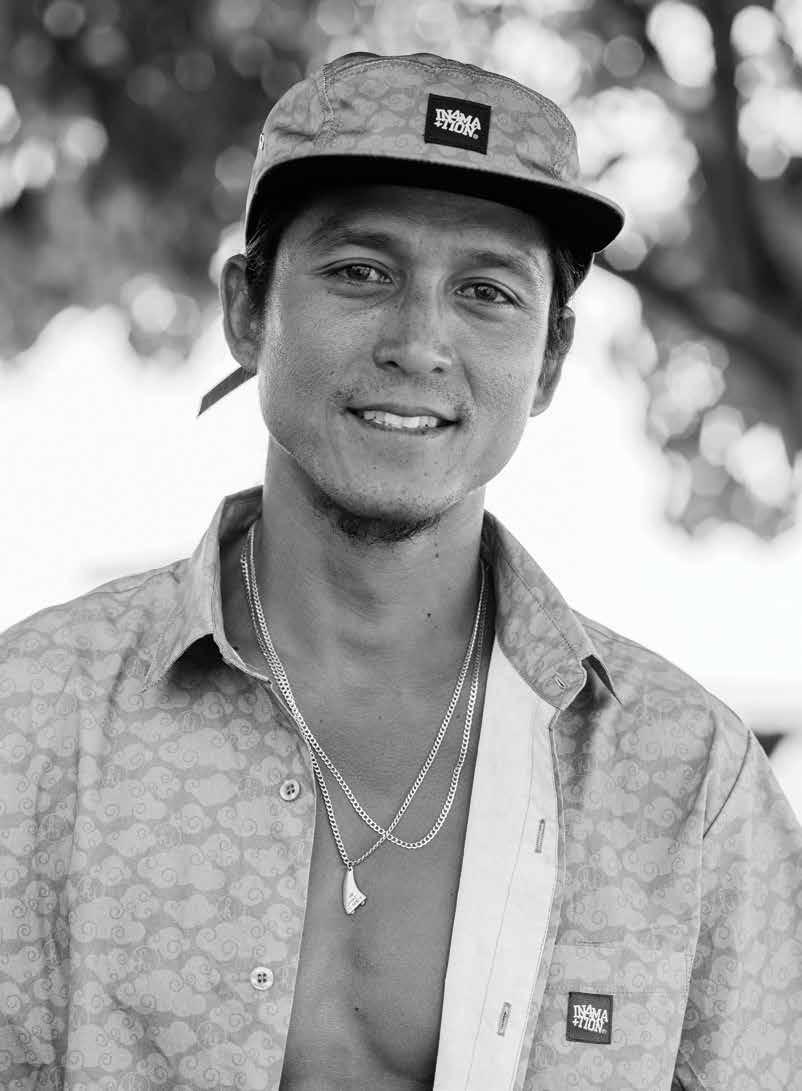

Perry Fernandez 61, FROM PĀLOLO SURFING KAISER ’ S SINCE CHILDHOOD
“I’ ve learned that with surfing, it’s all about performing. I’m regular foot but sometimes go goofy too. My surf style was powerful, real hard. I liked to accelerate into turns. And I had this thing I used to do at Kaiser’s all the time: Whenever a boat came through the channel, I’d time it and then catch a wave right next to it—I’d surf next to it, side by side. It was like having a moving audience with those tourist boats. I’d have ‘em all clapping, cheering and hooting. They’re looking at us surfers making use of the spirit of the wave. So, when the waves were up, the show was on.”
81 | FLUXHAWAII.COM
Justin Silva
25, FROM HONOLULU
SURFING KAISER ’ S SINCE 2010
“Kaiser’s definitely built my confidence. As a kid surfing Queens, I saw just how hollow and much more powerful Kaiser’s was compared to Waikīkī and so I always wanted to get the wave down, to get comfortable. I looked up to the uncles there too. They were all power surfers, with such good style, speed and control, throwing lots of spray.
When I was a grom, you couldn’t take the long shot where the uncles were sitting. Instead, you had to surf the bowl, playing cat-and-mouse because you didn’t want to be in any of the uncle’s way. You had to work your way up and introduce yourself to the uncles at the peak. You had to make a name for yourself before you can sit out there with them.
Now that I can sit at the peak, it means a lot because Kaiser’s’ wave is so special. Once you’ve earned it, you can wait for a good wave with a good wall and take off from the outside. You can pull in straight into the barrel and get a nice vision of Diamond Head before coming out and then casually pulling into another one. It’s amazing. And even today, I still respect all the uncles out there.”
82 | FLUXHAWAII.COM
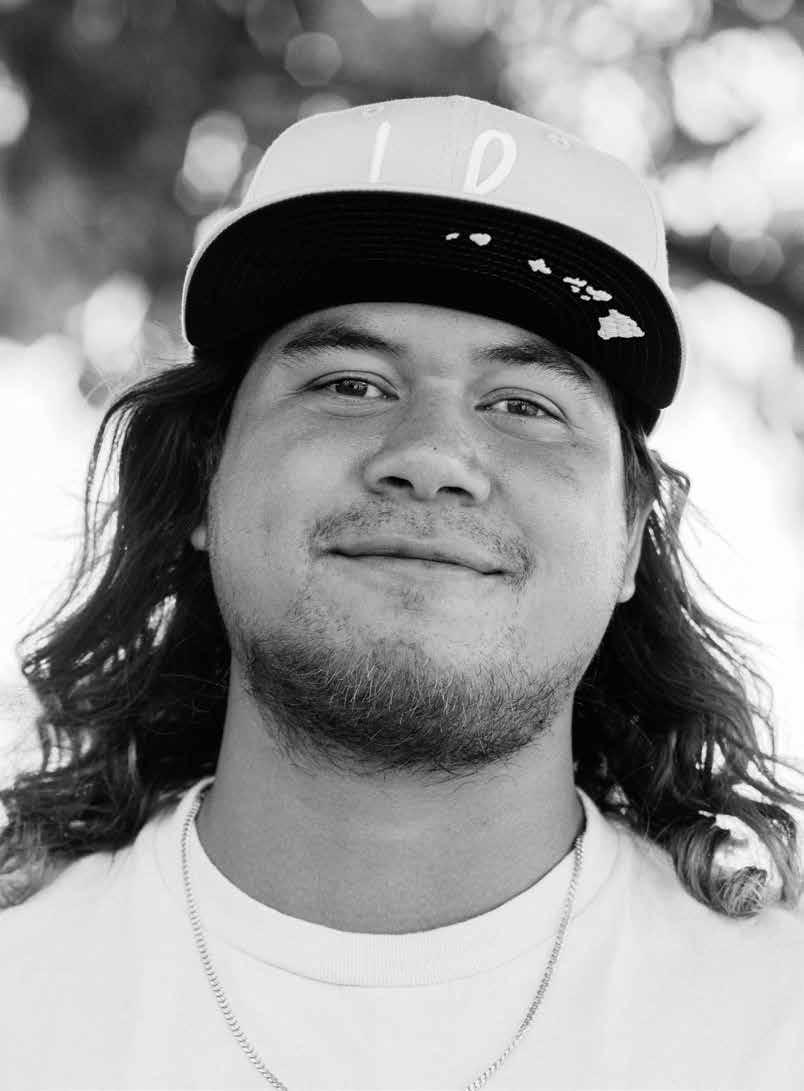
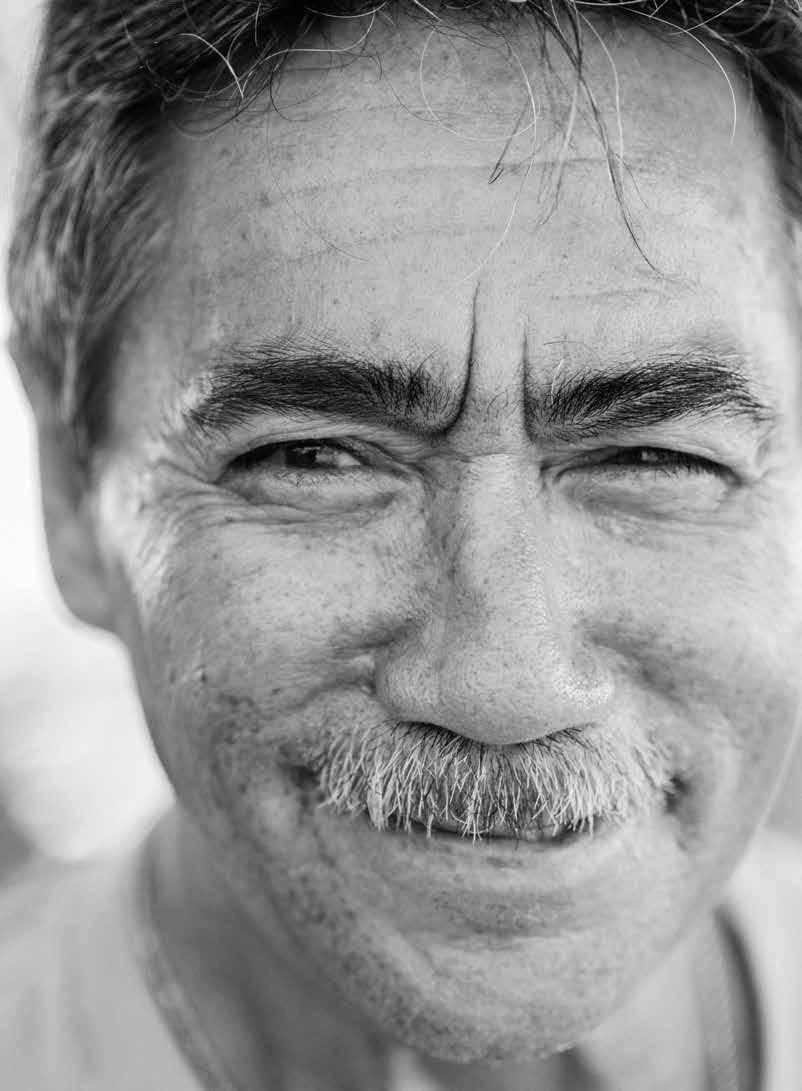
Leroy Miranda
68, FROM HONOLULU SURFING KAISER ’ S SINCE 1968
“I started Kaiser’s when I was about 14. It was convenient because it was close to home. I knew all the top surfers too like Larry Bertlemann, Buttons Kaluhiokalani, Dane Kealoha—all these guys were in school with me. I always wanted to surf. Back then, if you had money you could go spend it on carnival but you then would just lose money. But if you came here instead, you could spend time working out, getting healthy, and having some fun waves. I quit surfing maybe 8 or 10 years ago because I got three pinched nerves in my back. But I still ride my bike down here because I like to watch the waves. All my friends are here. This is my second home.”
85 | FLUXHAWAII.COM
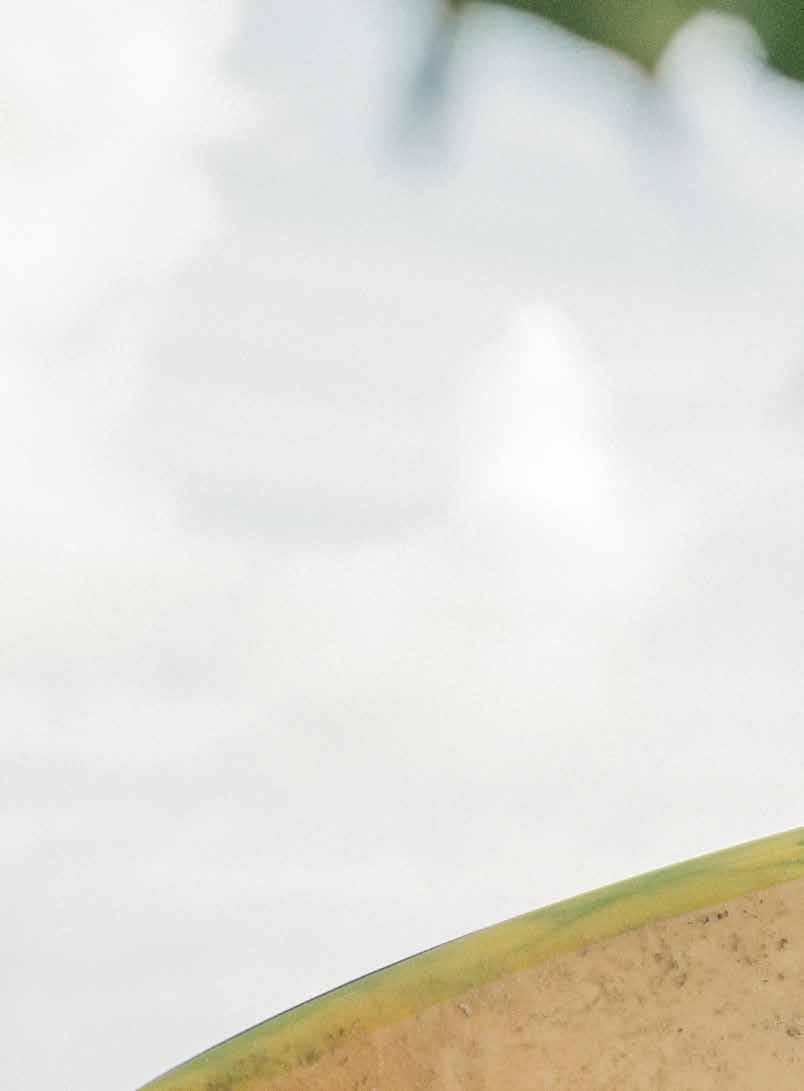
Five Commandments of Kaiser’s According to The Bull
ASK QUESTIONS
“If you are not from here, you better start talking to somebody. Otherwise you’re gonna put yourself in a bad position. We’re here to educate and help you.”
DON’T GET IN THE WAY
“There’s a pecking order. Find out people’s names and who’s been around for 30, 40, 50-plus years. And if an uncle is going right, you go left. Automatic.”
KEEP YOUR SPACE
“There’s so much room in the ocean so find a space that’s kind of your own. It’ll make it easier for you to respect the space of everybody else who is out here. Eventually you can get to a position where you can say, ‘I’m a local at this spot now.’”
GIVE RESPECT TO EARN RESPECT
“It takes awhile to learn about what goes on here. We joke that it’s a 20-year initiation to get respect from our crew. Sometimes it takes a lifetime.”
MĀLAMA THIS PLACE
“You’re not just gonna come here and just go surfing, just show up and blow up. It doesn’t work that way. You gotta come here and do something. Help someone. Pick up rubbish you find on the beach or in the water. Do something good.”
1. 2. 3. 4. 5.
86 | FLUXHAWAII.COM
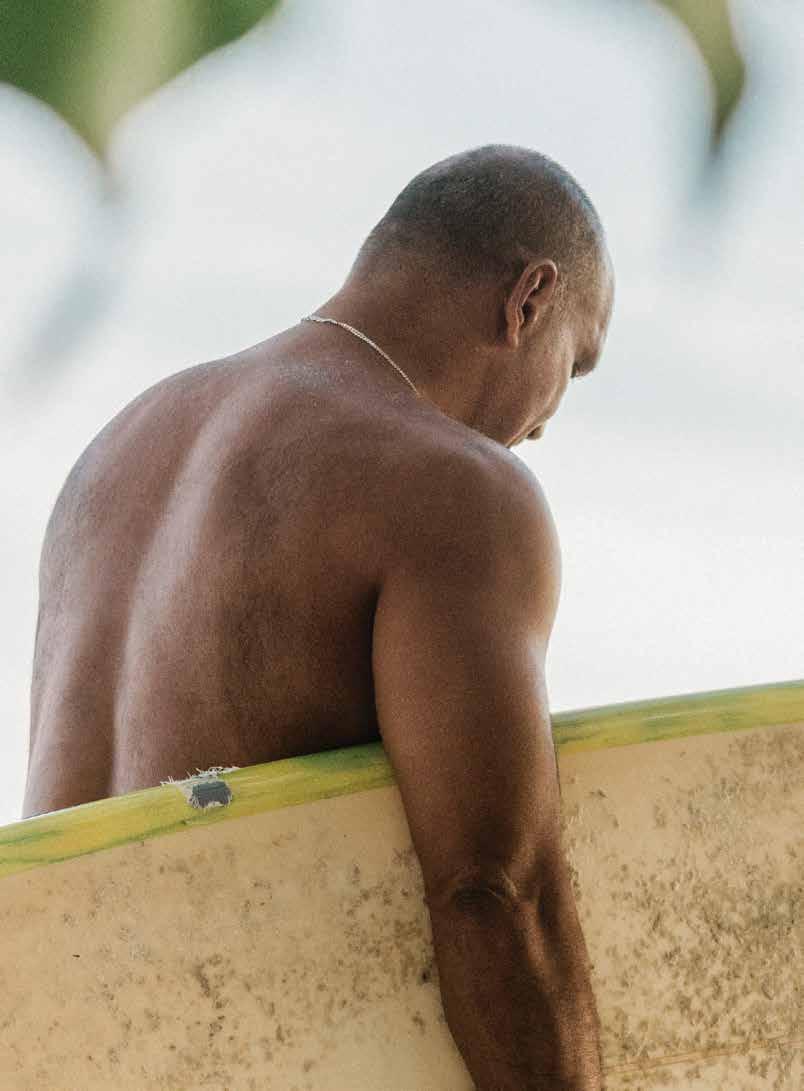
Bob Fernandez
56, FROM PĀLOLO
SURFING KAISER ’ S SINCE 1970S
Bob Fernandez is a man of purpose and passion. At 6’5” and nearly 250 pounds, he is also a visible, if not intimidating presence at Kaiser’s. “I’m the bull here,” he says. Fernandez, who grew up in Pālolo’s public housing, recognizes how a rough and violent upbringing can shape one’s life. “I saw a lot things kids shouldn’t see,” he says. He found joy, however, in the ocean. His father, Kalani, one of Waikīkī’s first hotel doormen, would drop him off, along with older brothers Perry and Troy, at the beach before heading to work. “There wasn’t a parking lot here yet, it was just bushes,” Fernandez remembers. The boys would holoholo all day, taken under the wing by Kaiser ’s’ “uncles” who taught them how to surf and bought them sandwiches for lunch.
The Fernandez brothers eventually would grow up to become a veritable tour de force at Kaiser’s, one that maintained order both in the lineup and on shore. Their presence was admired and feared in equal measure. During those early years, Fernandez recalls, any disrespect at the break or of its tightknit community was swiftly mitigated by the brothers, first with warnings, sometimes followed by blows.
Today, Fernandez is unfazed by any lingering reputation as a heavy-handed Kaiser ’s enforcer. Recognizing the anger and negativity that shaped his early years, he has since learned to develop a more nuanced approach with instances that
trigger a knee-jerk reaction. It’s an ongoing practice, Fernandez admits. “In my 20s and 30s, I used to do crazy stuff and I feel bad about that,” he says. “As I got older, I started to understand I wasn’t here for that.” He notes that a regulator’s role isn’t specific to just Kaiser ’s. “Every spot has somebody like me,” he says. “If you go to Mākaha and someone gets out of hand in the water, there’s gonna be a big boy to set you straight,” he says. “So really it’s about the respect factor.”
For Fernandez, that respect factor is a fulcrum in which everything—the ocean, the ʻāina, the community—is centered upon at Kaiser’s. Underneath that is Fernandez’s fierce desire to protect Kaiser’s. Under that, an even fiercer love.
On a recent late afternoon, Fernandez gazes at the large milo tree that family members planted near the beach shower some 30 years ago. He sees his friends and two sons gathered in its shade. Everyone is talking story, smiling, and laughing. Fernandez observes the scene with quiet pride.
“I’ll go down hard for this place because it’s my home, it’s in my genes,” Fernandez says. “This place is everything to me.”
88 | FLUXHAWAII.COM

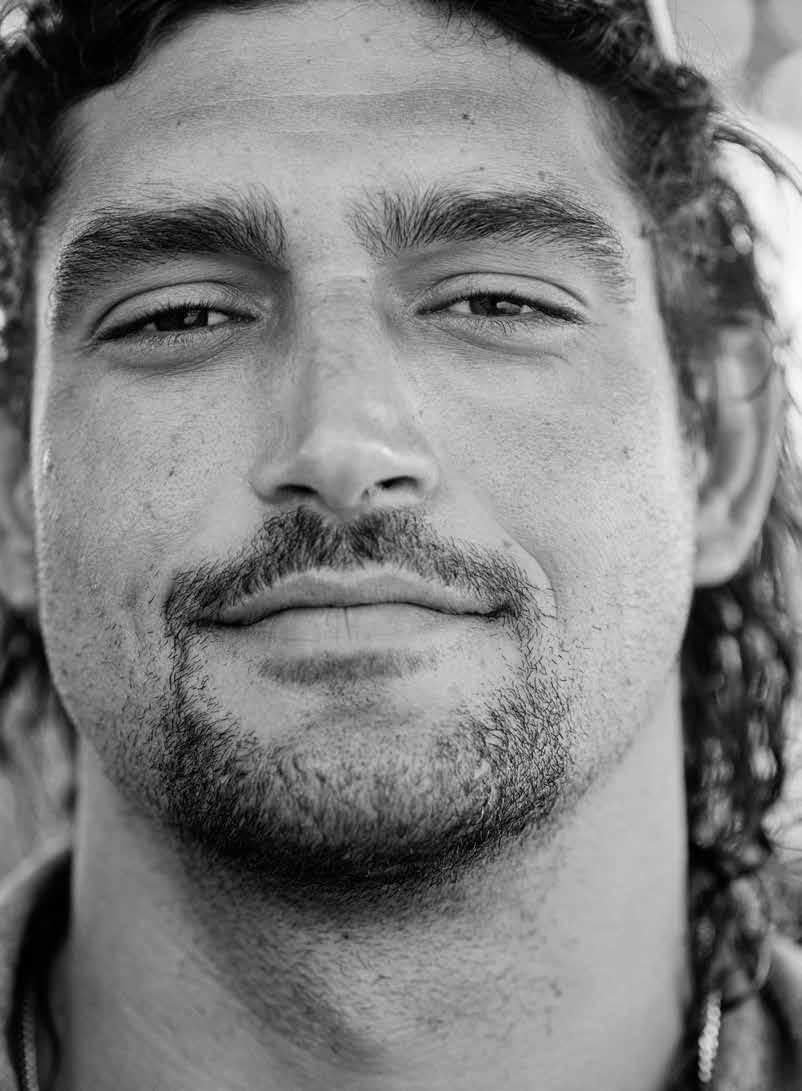
Dustin Kalani Fernandez
33, FROM HONOLULU SURFING KAISER ’ S SINCE CHILDHOOD
Kaiser’s has always been in Dustin Fernandez’s life. “I was here even before I knew I was here,” he laughs, in reference to his early years of being brought to Kaiser’s in a stroller by his dad, Bobby. As he grew older, he learned to surf from his dad, the sport shaping his childhood so much so that when he wasn’t at Kaiser’s, he made-believe he was. He remembers skating the driveways on his street, the undulating sidewalk a concrete equivalent to pumping along a wave’s face. “I’d pretend I was surfing Kaiser’s.”
Fernandez’s indelible bond to surfing and the Kaiser community that surrounds it is matched by his twin passion for art. Recently he discovered a stash of old homework assignments and tests from his childhood school days. “Every single paper was filled with doodles,” he says. Today, when not in the water, Fernandez can be found creating—often sketching and painting, and often first thing in the morning.
Five years ago, he was approached to apply his artistic talents to a surfboard. Demand then skyrocketed and Fernandez saw a unique opportunity in which to intersect his love for color, shape and form with his love for surfing. “Every single one of my friends wanted a paint job of mine.” Today he guesses he’s worked on nearly a hundred boards.
Fernandez credits the Kaiser surf community’s ethos of supporting and believing in each other. “I’ve noticed that in the last few years especially, everyone’s been elevating their niche,” he says. Fernandez is grateful for his friends’ unwavering support of his desire to pursue art. “The crew has really helped me,” he says. “I’ve done pieces that I would have never done without their push.”
91 | FLUXHAWAII.COM
Dylan Makanahiwahiwaokalani Fernandez
27, FROM HONOLULU
SURFING KAISER ’ S SINCE CHILDHOOD
Dylan Fernandez is acutely aware of Kaiser ’s reputation for surf localism. He senses it in the subtle shifts in body language and the inevitable questions of curiosity that arise when someone learns Kaiser ’s is his home break. “Yah, I get it,” he shrugs. “The spot’s gnarly.”
Since the ’70s, Kaiser’s has built a lore of heavily enforced territoriality where wild tales of broken boards, smashed faces, and immediate ejections of unwelcome surfers from the water were commonplace. The vibe has mellowed since Kaiser’s regulatory hey-days but familiar grievances are beginning to resurface. The lineup is changing, and with it, a shift in surf mores. Traditional codes surrounding hierarchy, respect, and order are being drowned out by a new generation of surfers greedy for waves. Many aren’t aware of the general rules of the water, or worse, simply don’t care.
But Fernandez does. Despite these shifts, Kaiser’s remains an intact, stable surf community where, as always, core issues of
safety and respect are paramount: Safety is required, respect must be earned.
Fernandez explains the frustration he feels when newcomers, especially tourists or transplants, choose not to follow the general rules of surf etiquette. He holds specific concerns for the older uncles—“legends,” as he puts it—who just hope to catch a few waves before or after work. “These new guys will be frothing for waves and then just take off on one, without bothering to see if an Uncle is already on it and so they end up hitting him,” Fernandez says. “That’s dangerous. Because of that somebody like us has to step up and say something so it doesn’t happen again.”
92 | FLUXHAWAII.COM
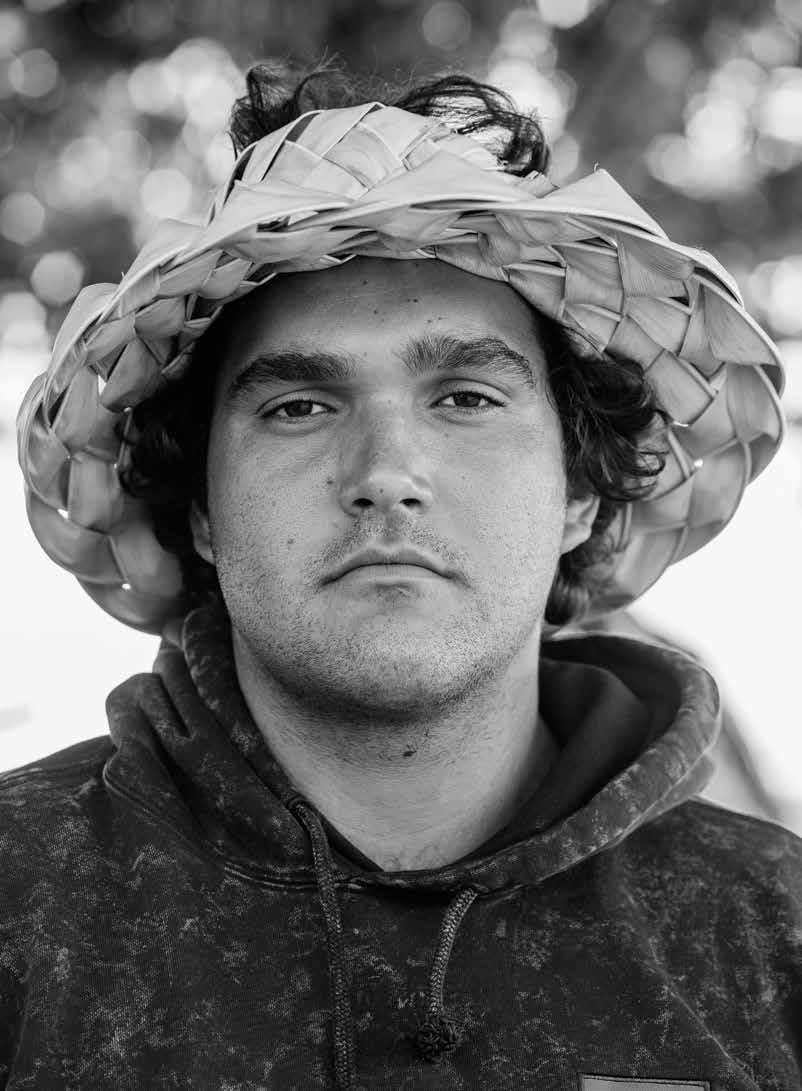
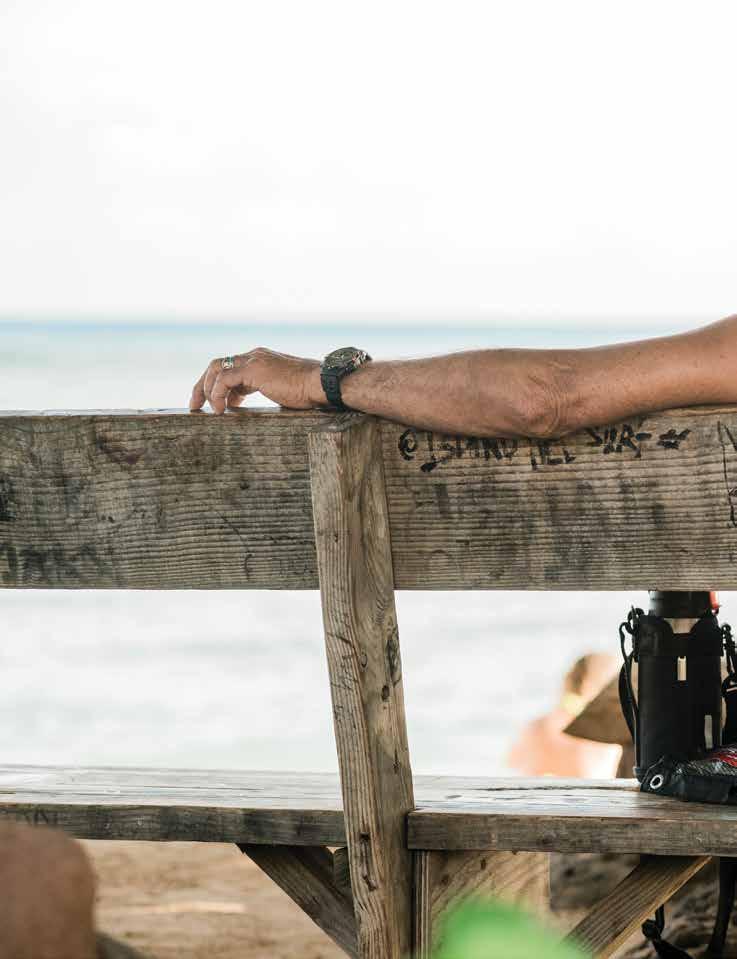
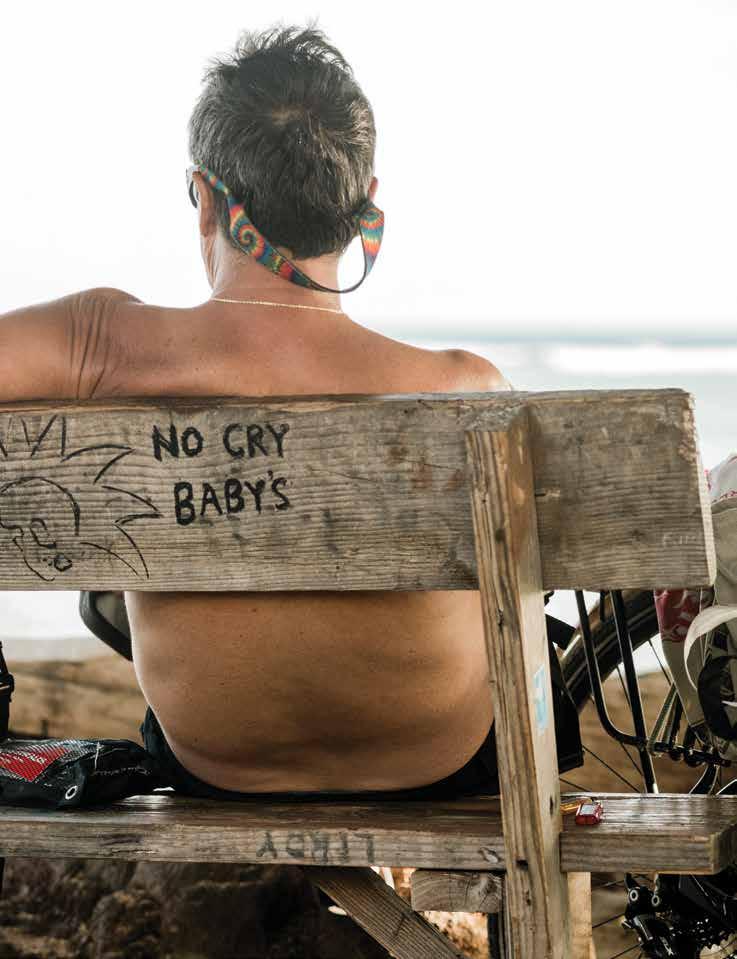
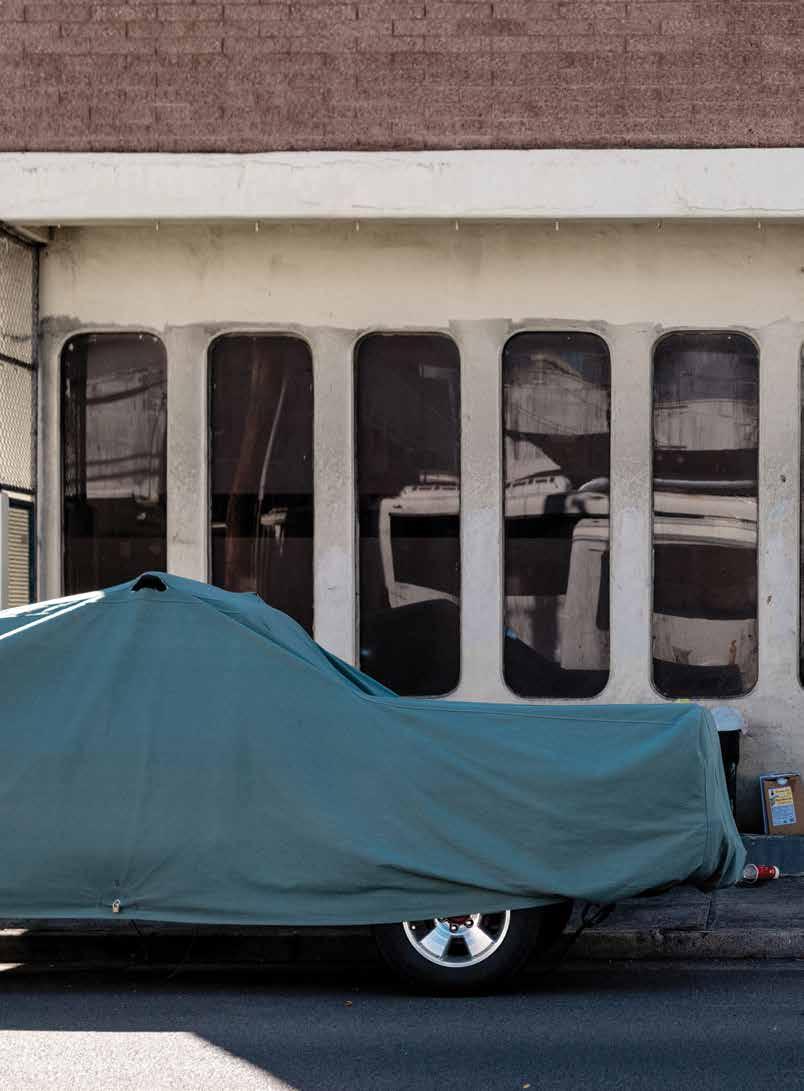 FLUX FEATURE
FLUX FEATURE
Making It in Mo‘ili‘ili
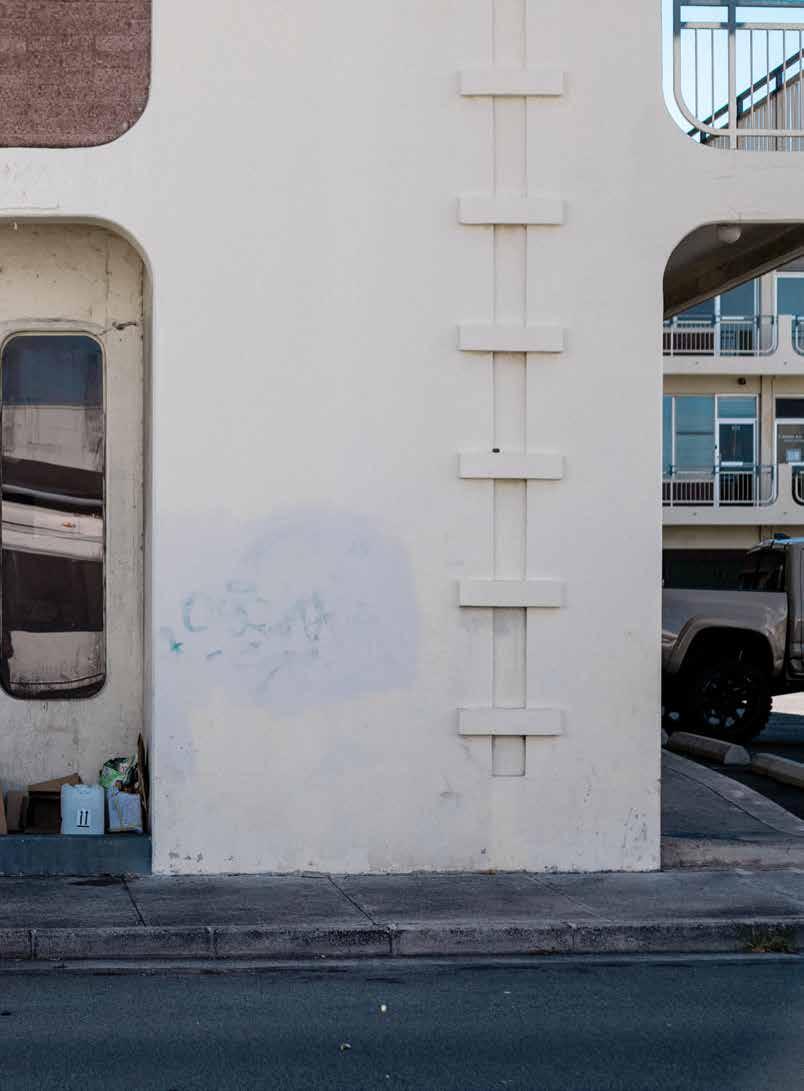
In learning a neighborhood’s labor history and modern-day eccentricities, a local writer manages to cope with loss and find the resilience to move forward.
TEXT BY SARAH BURCHARD
IMAGES BY JOHN HOOK
It was late fall. The year was 2019. Four months had passed since I left my home and the love of my life and I was out of couches to crash on. The room I rented on Paʻani and Date streets was empty except for a squeaky futon graciously gifted from my new roommate. The commercial-grade vinyl tile floor left dust stuck to my feet. I laid down, wincing as my heels hit the frame of my new bed. “Just while I’m in transition,” I told myself.
Mōʻiliʻili was not the dream life I left, not a place I came to by choice. I was on a writer’s budget not even college kids here could survive on, but my wages from my part-time assistant job were enough to cover the rent.
That first morning I woke to the familiar city sound of a garbage truck storming the streets. Outside my jalousie windows hardworking men in neon hurried along their route, whistling at the driver to stop and go, stop and go, without any time to capture the trails of Big Gulp cups, milk cartons, and crumpled styrofoam left on the pavement from the half-open, bulging white bags they heaved into the green truck. I stepped onto the apartment lānai glassy-eyed. The sixteenth floor looked across an asphalt jungle of decaying wood-framed houses and concrete block walk-ups to the Koʻolau Mountains. I was 38 and starting over. The distance from where I stood to those mountains of green felt insurmountable.
My roommate had gone through a painful divorce a few years earlier, so he was not surprised by my long bouts of sobbing. Most days I left before sunrise and was in bed before he got home anyway. I just wanted to walk in the dark and think about something else, anything else. Sometimes I would watch the paddlers in their outrigger canoes glide along the moonlit Ala Wai. The man-made canal built in the 1920s, now notoriously rife with trash and pollution, disassembled the communal ʻauwai system that once flowed from the top of Mānoa to the ocean, providing the waena of the Waikīkī ahupuaʻa ample water for loʻi and life.
I wondered why anyone would destroy such a sustainable food system and learned
that in 1906 the then-Territorial Board of Health reported the marshlands as a breeding ground for mosquitoes and harmful for public health. Changing the drainage route of the ʻauwai essentially sucked the surrounding 19-square miles dry and diverted water from going into Waikīkī. Agricultural land transformed to urban streets and the cultural practice of communal land maintenance was eliminated. Furthermore, in 1934, construction on a new sewer system began, creating sinkholes, breaking electrical and gas lines and splitting apart sidewalks. Mōʻiliʻili, once known for its pristine waterways, was now blanketed in cement. There is no turning back now, I thought crossing the McCully Bridge.
A couple months later, I was peering into a drainage canal on Date Street when I got a call. “Hey Sarah, would you be interested in writing a cookbook featuring Hawaiʻi chefs?” I nearly dropped my phone into the water. Of course I would. A tiny moʻo slithered across the sidewalk. The neighborhood’s namesake were the only reminders of the neighborhood’s free flowing past. A time when you could look over a bridge on this path onto bright green banks of ʻakulikuli and an abundance of gobies and rainbow fish swimming down a clear Ala Naio Stream. On the corner of McCully and Algaroba Streets there is a 250-foot-wide lizard mural that depicts the legend of Hiʻiaka attacking a lizard god to save her friends. Using her skirt to shoot lightning bolts, she sliced the moʻo into pebble-sized bits. Kamo‘ili‘ili, or “pebble lizard,” was eventually shortened to Mōʻiliʻili and used to name the place tucked within the borders of Kapahulu Avenue, the Ala Wai Canal, McCully Street and lower Mānoa.
These days, all I see are toxic tilapia floating in inches of murky water down below. However, the charcoal gray coral limestone that once lined the Mōʻiliʻili Karst, which is a complex maze of streams, caverns and caves, still remains. Most entryways to this underground waterland
Fed up with plantation working conditions, Mōʻiliʻili once promised the hope of a better life.
Mō‘ili‘ili is full of impactful subcommunities to engage with.
98 | FLUXHAWAII.COM
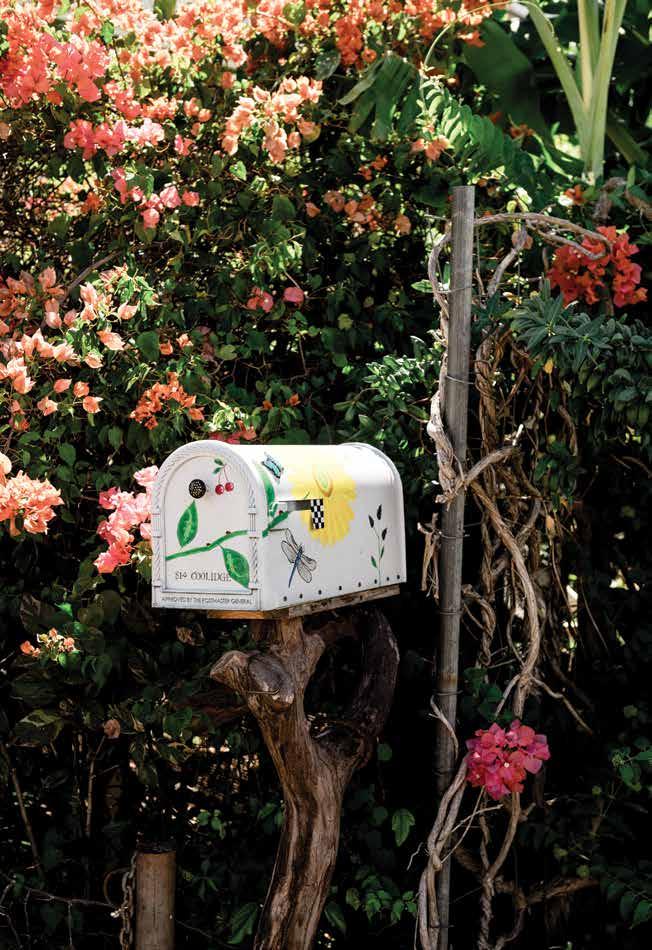
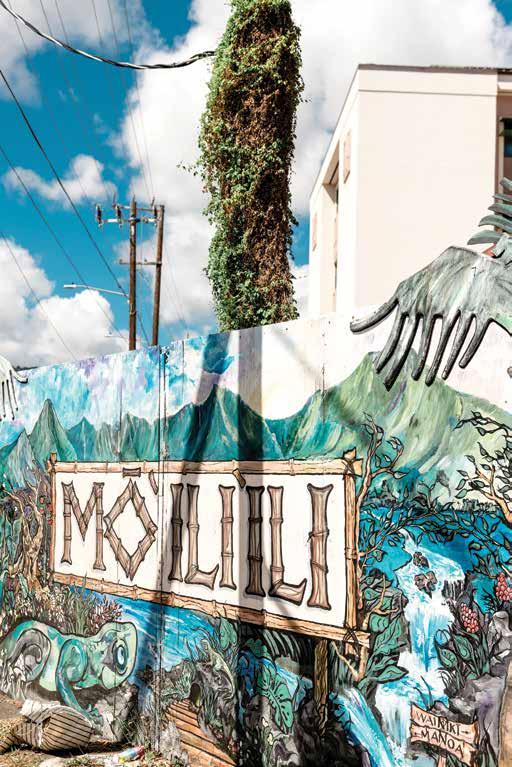
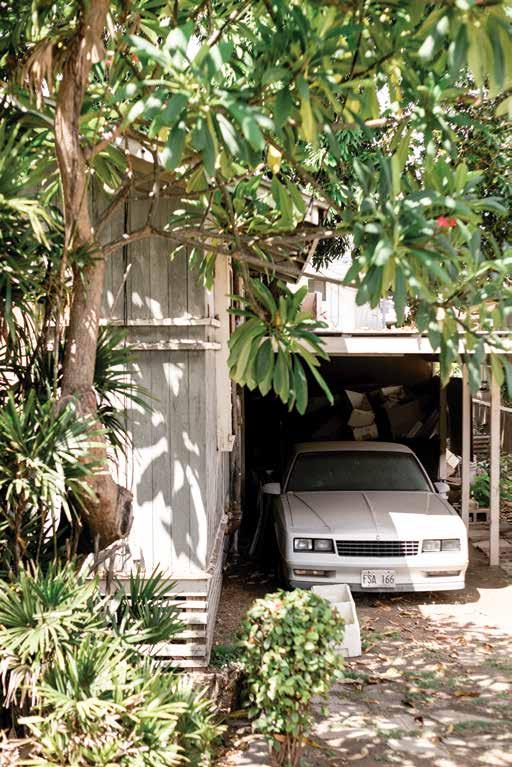
have now been capped, including the most famous opening at The Willows. But the moʻo are still here.
I decided on the way home not to get my hopes up about the cookbook gig. I still had to interview with the publisher to see if I was the right fit. Opportunities feel like safety nets when you are falling, but they don’t always conclude with a happy ending. But, I felt I needed this life raft. I thought about the people who came before me to this neighborhood, also with opportunities and nothing to lose. In the late 1800s, Chinese immigrants arrived planting Chinese taro, rice, and lotus root, raising chickens, ducks and pigs and setting up poi factories. They originally helped strengthen lo‘i systems, but eventually moved out when ag land started to disappear. A century later, following the abolishment of contract labor with annexation, many Japanese laborers obtained leases to land here.
Fed up with plantation working conditions, Mōʻiliʻili promised the hope of a better life. They set up camps lined with plantation-style cottages and furos, owned their own farmland, found jobs, started businesses, built temples and shinto shrines, even a sumo wrestling ring, and established a socioeconomic class of their own. Many of them worked at the quarry where decades of blasting blue-basalt lava rock ensued, leaving the once Hawaiian-owned land under a wealthy coating of white dust. But, during the war in 1941, the military ripped many of them away from their families, homes and businesses, sending them to Sand Island where they endured internment camps until the war was over. Afterward, they came home and had to start all over again. There is a bright orange steel and titanium structure that stands 52 feet tall in Triangle Park. The towering 125-yearold symbol of friendship between Honolulu and Hiroshima, where the majority of Hawaiʻi’s first Japanese sugarcane contract workers immigrated, stands unnoticed in the middle of traffic.
That night I discussed the potential cookbook with my roommate. I posited, “What if I do all this work, meet the publisher’s impossible deadline, and put the rest of my life on hold to write it and nobody pays any attention to it?” His answer was the nudge I needed. “Your entire career has led you to this book,” he said. “You were meant to write it.”
I spent New Year’s Eve in bed, listening to the war zone of fireworks outside. It had been three weeks since
The neighborhood of Mō‘ili‘ili is tucked within the borders of Kapahulu Avenue, the Ala Wai Canal, McCully Street and lower Mānoa.
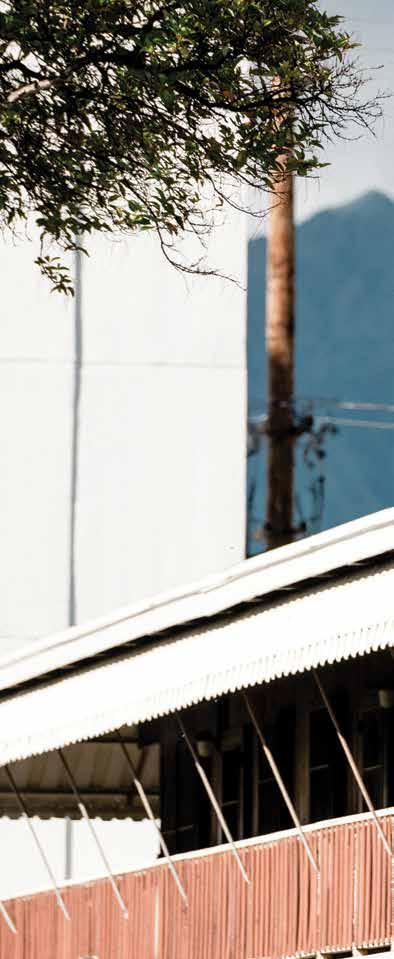
102 | FLUXHAWAII.COM
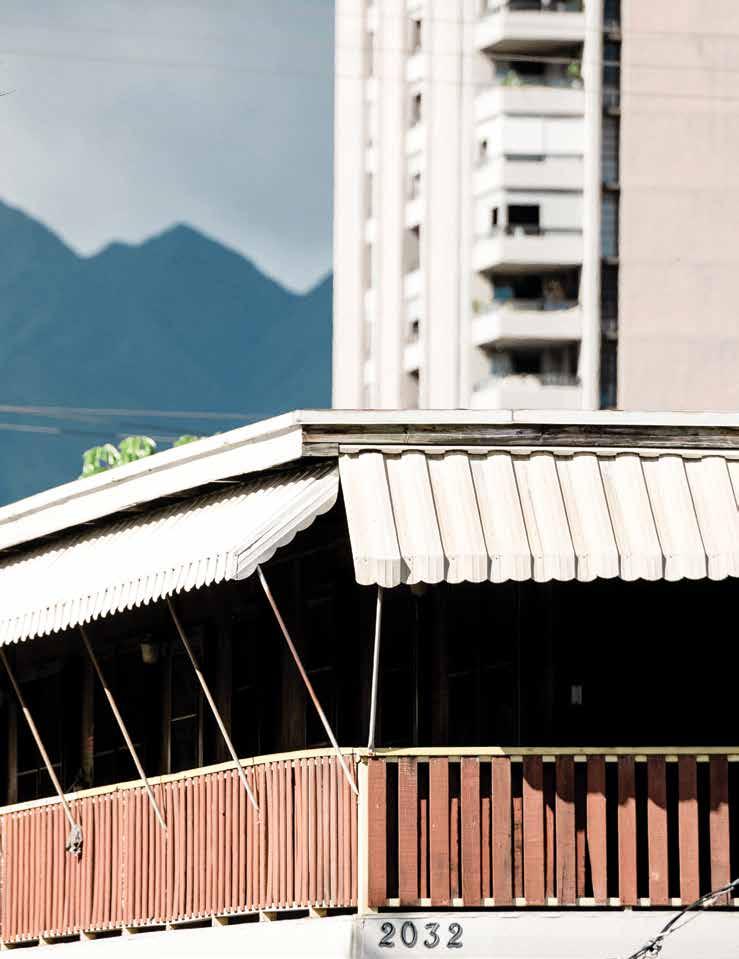
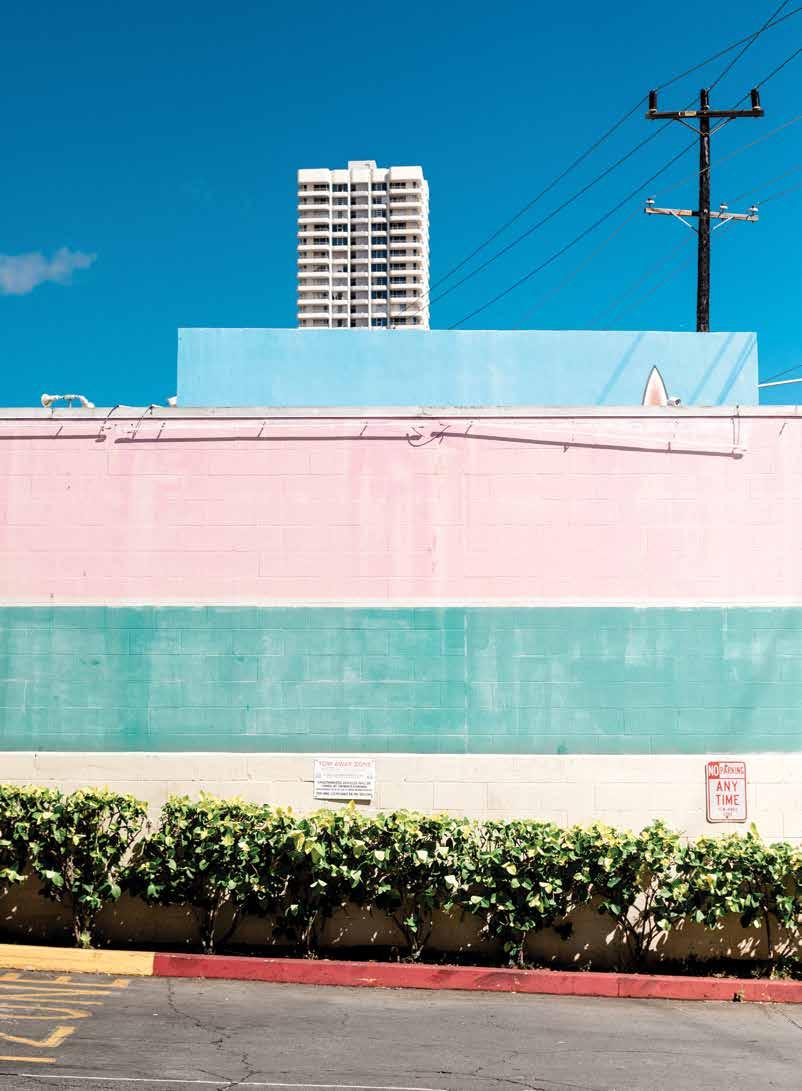
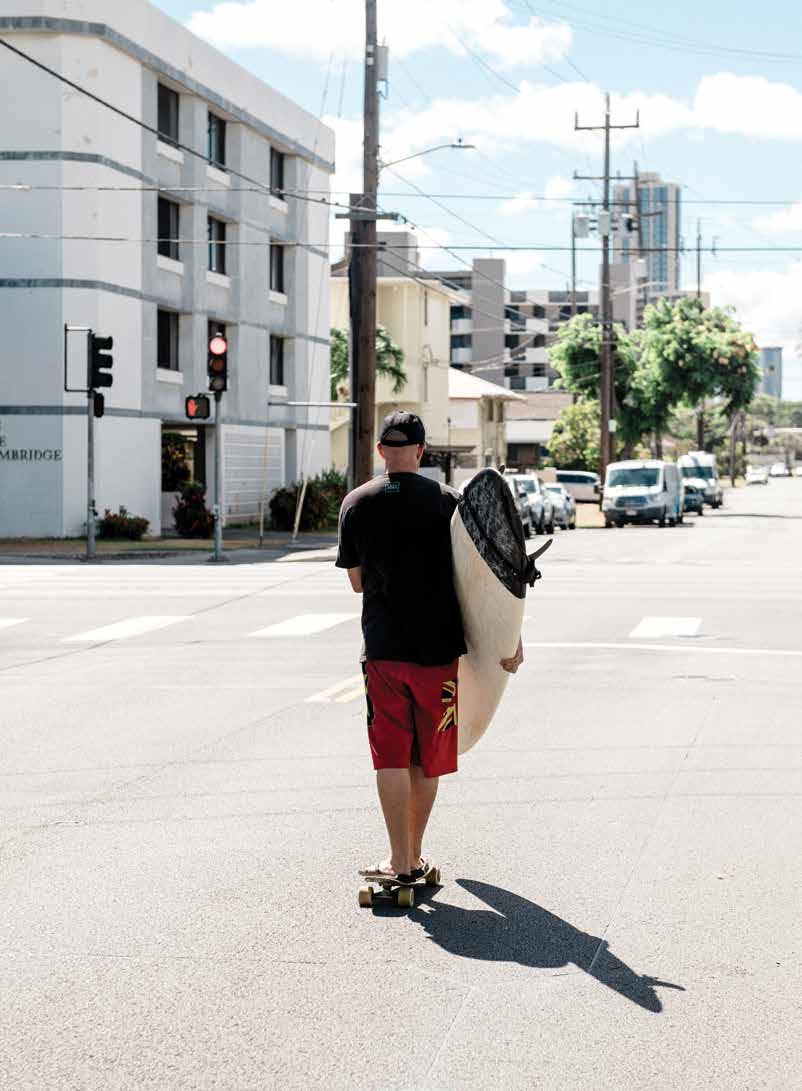
my call with the publisher. The next morning I was on my way home from a walk when I heard squealing. As I approached the cries, I watched three men wrangle a pig out of their truck onto the driveway and stick it with a big knife. The streets were covered in red powder from firecracker residue, an uncle was in front of his home sweeping it up. This cannot be a good sign, I thought. But, two days later, while I was admiring the monarch butterflies and aunties pruning sweet potato and bitter melon leaves in the community garden, my phone rang and I had a book deal.
The next few months were filled with interviews, transcriptions and recipe testing. In the mornings, I spent hours at Glazer’s, a coffee shop on South King Street, opened by Koreanborn Sam Han in 2007. Sam returned to Hawaiʻi after spending a decade in Seattle and chose Mōʻiliʻili because he wanted a college coffee shop like the ones he enjoyed in the northwest. I like the dimly lit space, with the subtle hum of 1960s jazz mixed with University of Hawai‘i students and professors, freelance writers and regulars on laptops or playing chess. I made friends with the barista the first time I went and it has been my good luck spot to write ever since.
Then, the unexpected: 36 interviews, 70 recipes and over 14,000 words later Covid-19 hits Hawaiʻi. I am laid off from my part-time job and begin collecting unemployment in March 2020. Four months later, I received an email from my publisher that read, “After much deliberation, we’ve decided to cancel this project. It makes me sad to do so, but we simply cannot afford to take such risks at this time. I am so thankful for all of your hard work and positive energy throughout this process.”
I didn’t leave my bed for two days. The feeling of rejection from my breakup resurfaced and I no longer had the cookbook to keep me busy. When I finally rose I walked to Old Honolulu
Stadium Park. In 1926, the stadium hosted football, baseball, stock car racing and concerts that lured the likes of Babe Ruth, Joe Dimaggio, Marilyn Monroe, and Elvis Presley. In 1955, the pink Bowl-O-Drome, built next door in the old stock car staging area, brought 24-hour-a-day excitement. After the city tore down the stadium, replacing it with the park, the Discover Mōʻiliʻili Festival was held here in an attempt to prolong the party, albeit once a year. I remembered all of the baseball games and festivals my partner and I used to attend in San Francisco, and the local events we discovered after moving to Oʻahu. Like this block, now primarily a houseless encampment, the excitement of those days felt likely never to return. I left feeling more grim than ever.
One of the things that helped me during this dark time was digging into community work and learning more about my neighborhood. Mōʻiliʻili is full of impactful subcommunities to engage with. I went to hear Mahina Paishon-Duarte speak a few times. Paishon-Duarte is one of the cofounders of Waiwai Collective, located inside the Varsity Building on University Avenue, along with Keoni Lee and Jamie Makasobe. Kamehameha Schools had approached them looking for a new way to uplift the lāhui. Noting a gap in ‘ōiwi business development and economy they created a coworking and event space in this location central to downtown and Waikīkī where culture, community and commerce intersect. Her talks made me think about my kuleana as a person living on an interconnected island and that this connection also has responsibilities to the land we live on and its native people. She told me she liked having the expansive mountain range behind the building. “It's a good reminder in terms of where we are at and how
we behave,” she said. Ka Waiwai, named after the wealth of water its underground caverns once produced, strives to replenish that lost sense of abundance.
I joined Slow Food Oʻahu to learn more about healthy and just food systems too. The regional governor for our local chapter is Laurie Carlson who was managing Kōkua Market on South King Street in 1981 when she helped make it possible for the former nonprofit to become a cooperative with the help of Neal Abercrombie. Kōkua Market was one of the first markets to advocate a healthy diet on Oʻahu, selling organic local produce and bulk grains and teaching people how to cook with canoe crops. She told me that she remembers Mōʻiliʻili being peaceful and kind back then with fishers stopping by to sell their fresh catch, Kuhio Grill across the street serving free food to beer drinking college kids, and anti-war events held at the Church of the Crossroads. She came back in 2019, to manage the store for two more years before retiring, and found a new neighborhood. “My experience working recently taught me just how incredibly gritty and embattled it is compared to then,” she said.
Everyone in the neighborhood wonders what will happen when Kamehameha Schools, who owns a large majority of the land around South King and University, finally renovates this block. The only reason why there has not been more land consolidation in the residential areas is because of the older homeowners hanging on tight to their homes, but it is only a matter of time before Mōʻiliʻili is gentrified. Paishon-Duarte, Carlson, and Han all have safety concerns about the rising houseless population in the area. They are hopeful the changes will help bring solutions, while still preserving the charm of the old buildings and mom-and-pop shops that define this area. Despite its success and trend
106 | FLUXHAWAII.COM
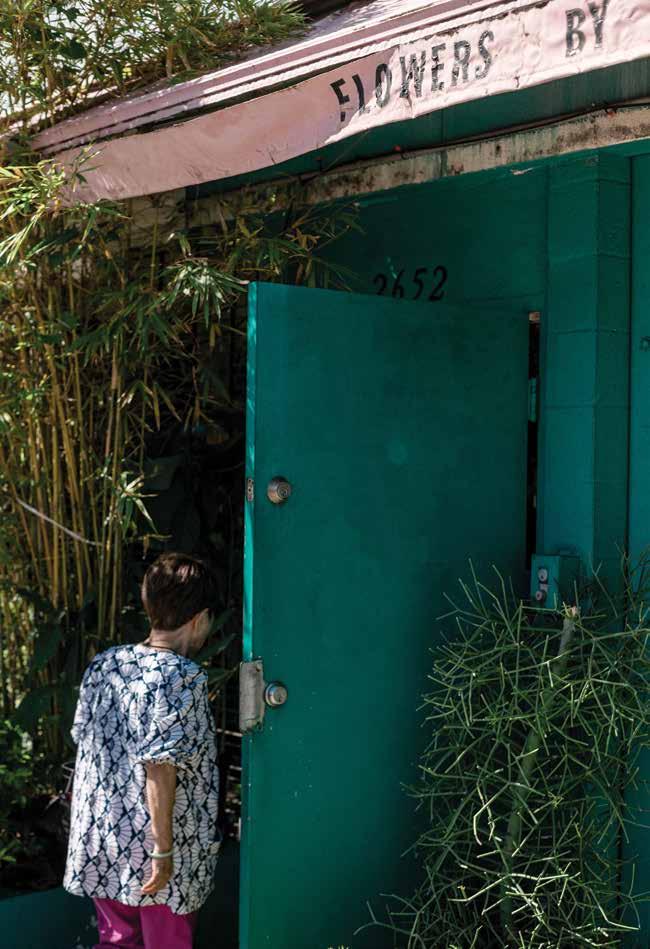
FLUXHAWAII.COM | 107
appeal, none of us want the neighborhood to become another SALT at Kaka‘ako, another Kamehameha Schools development. It may no longer be much of a college town, bustling with Puck’s Alley bars and art studios with a movie theater and trolley street cars running up and down King and Beretania streets, but progressive businesses such as ʻIli ʻIli Cash & Carry, Mono, and Aloha Got Soul show growth happening in the right direction. I thought about my mornings at Glazer’s, going to Izakaya Naru for sake and sizzling taco rice, stopping for ‘awapuhi at Le’s Flower Shop, the institutions such as Fukuya Delicatessen, an okazuya open since 1939, and Uyeda Shoe Store, open since 1915. Mōʻiliʻili may not have been my dream destination, but it had treated me well and taught me to not give up.
At home, the couples fighting and dogs barking outside fade when I hear my neighbor playing the violin. The police sirens that used to pierce my ears maneuvering from call to call and the deafening modified motorcycle exhaust that sets off car alarms every morning become obsolete to the roosters crowing and mynah birds chirping as the sun rises over misty Mānoa Valley. I donated my car after it was broken into twice and discovered a generous maze of bike paths. In the afternoons, I look down from my lānai onto the iconic blue home of Waiola Store to see how
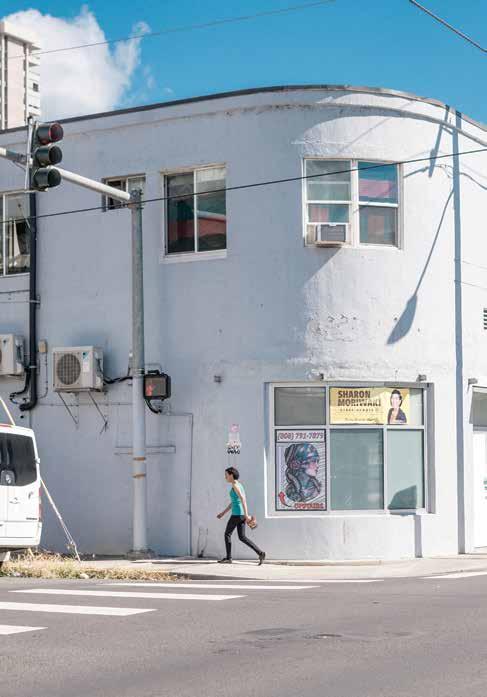
long the line is for shave ice, a big fat rainbow hanging from the highest cloud. Around sunset I hear people singing karaoke in the park where nonprofit workers set up folding tables to feed the hungry people living in tents. When I look to the left, I see my old condo
glimmering in the distance, a reminder of where I came from. I am 41 now. It has taken three years, but I can finally look at it now with dry eyes. As for my oncetransitional home? Last year my roommate moved out, this time gifting me a real bed to sleep on. I stayed.
In the early 1900s, acres of agricultural land transformed to urban streets.
108 | FLUXHAWAII.COM
 FLUX PORTFOLIO
FLUX PORTFOLIO
Island Gaze
Photographer Josiah Patterson’ s images speaks to the austere nature of his native home.
IMAGES BY JOSIAH PATTERSON
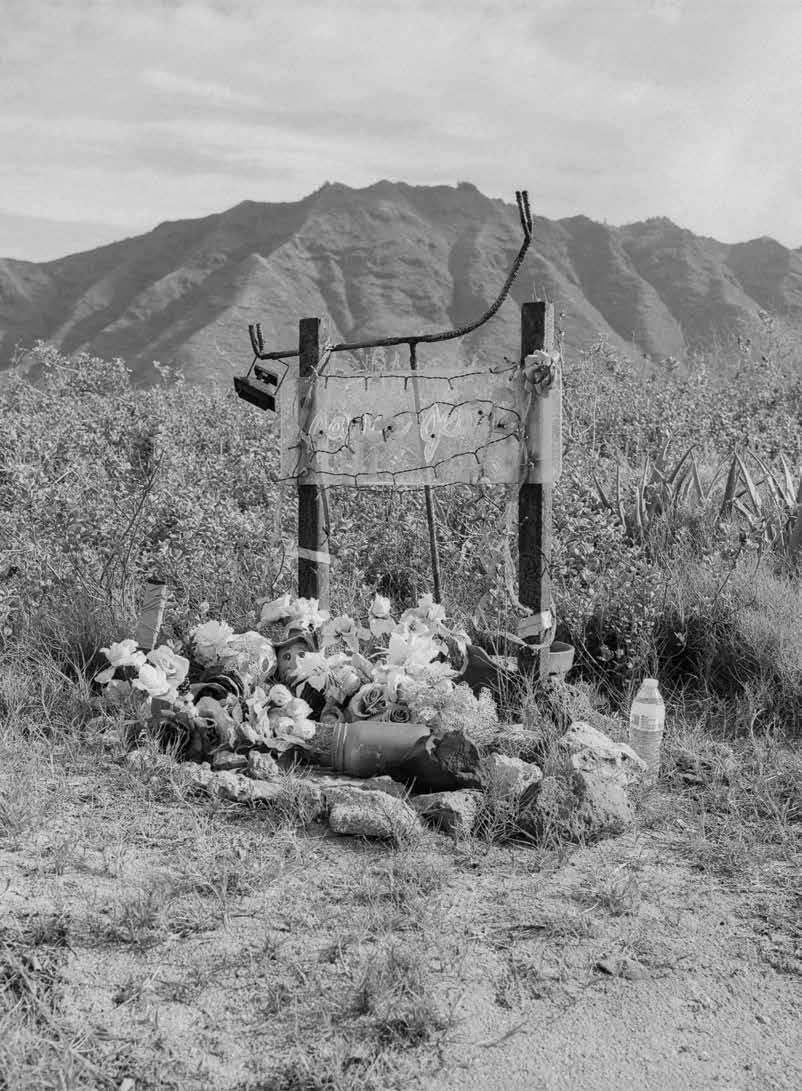
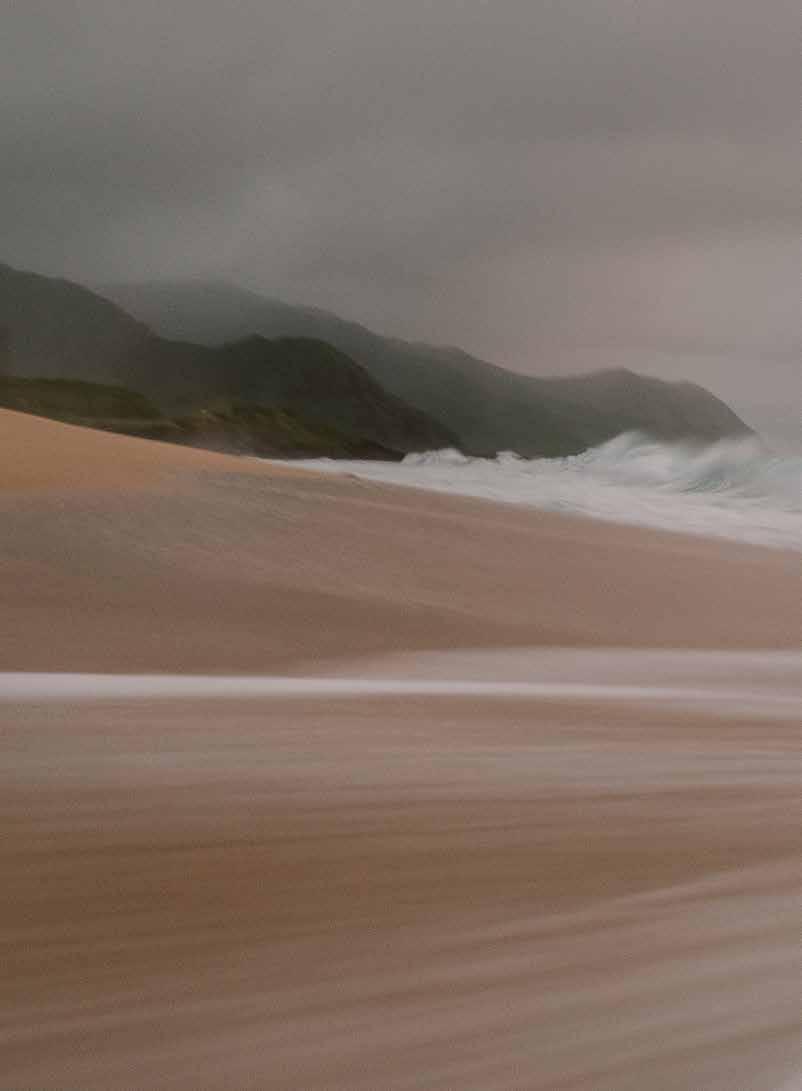

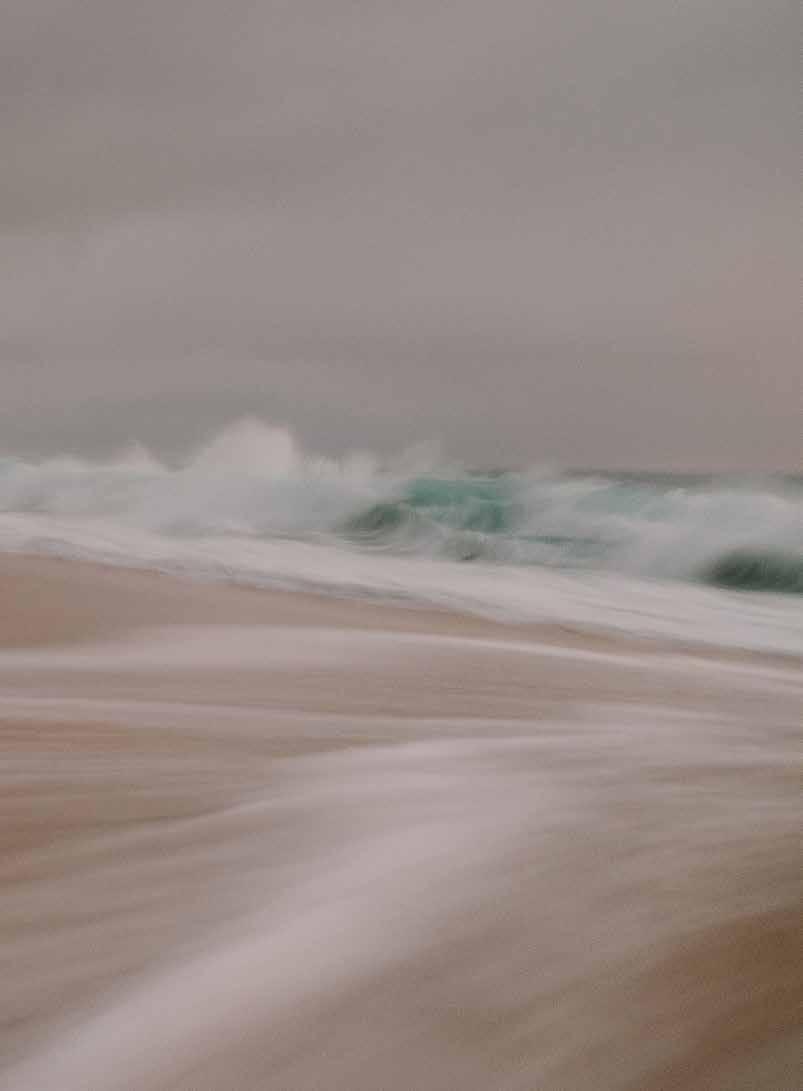
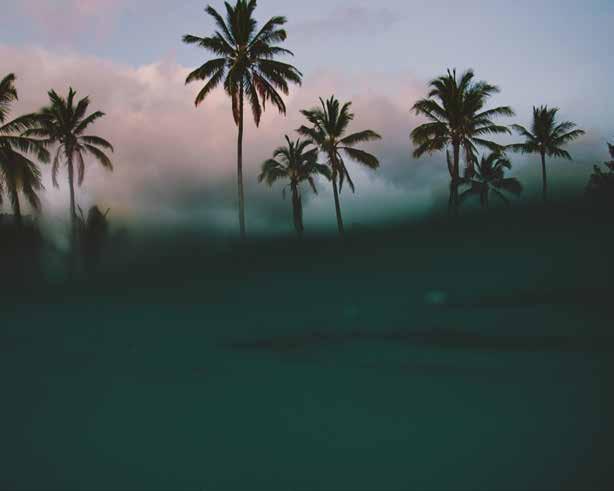
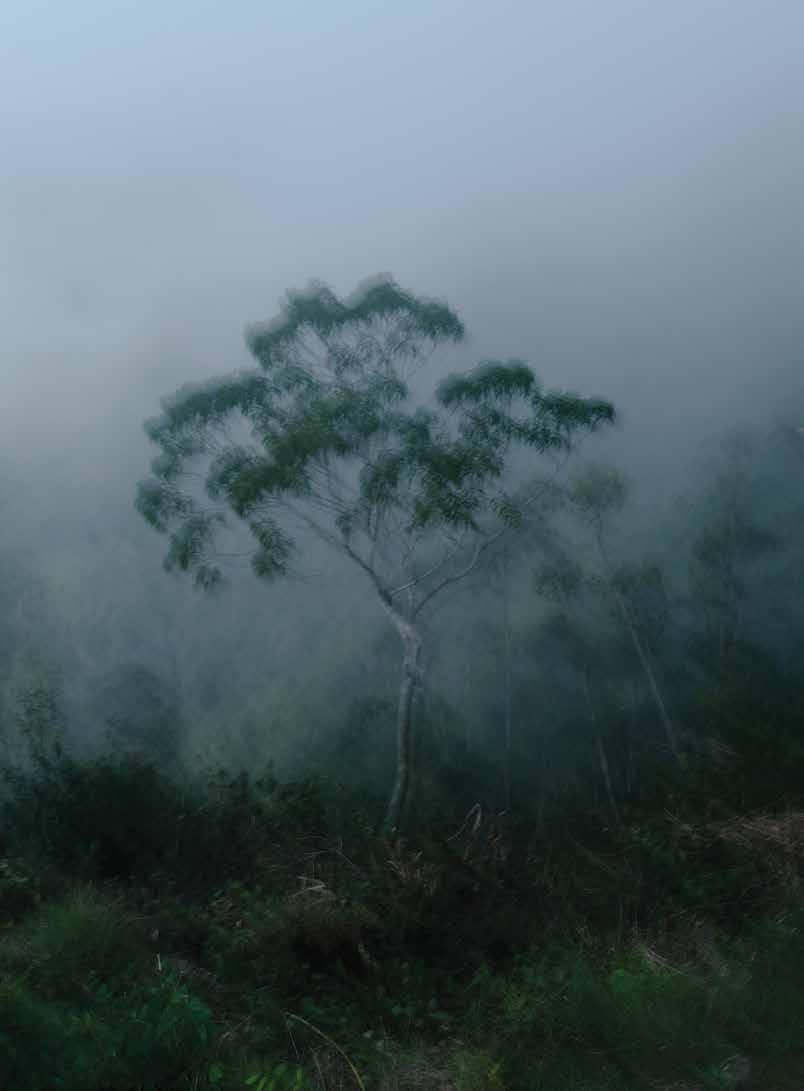
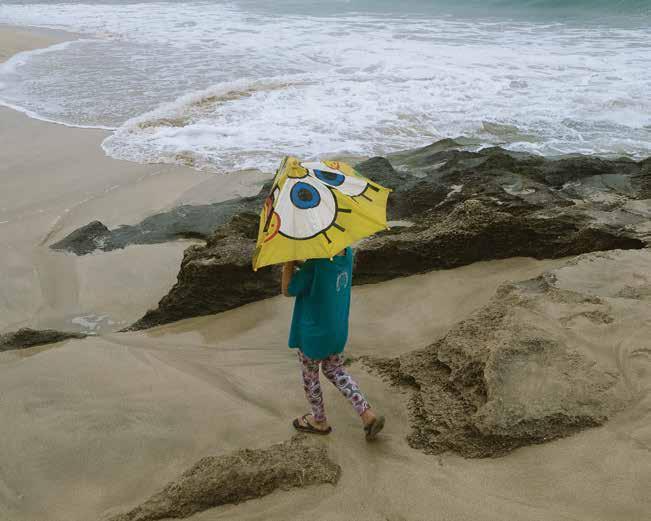
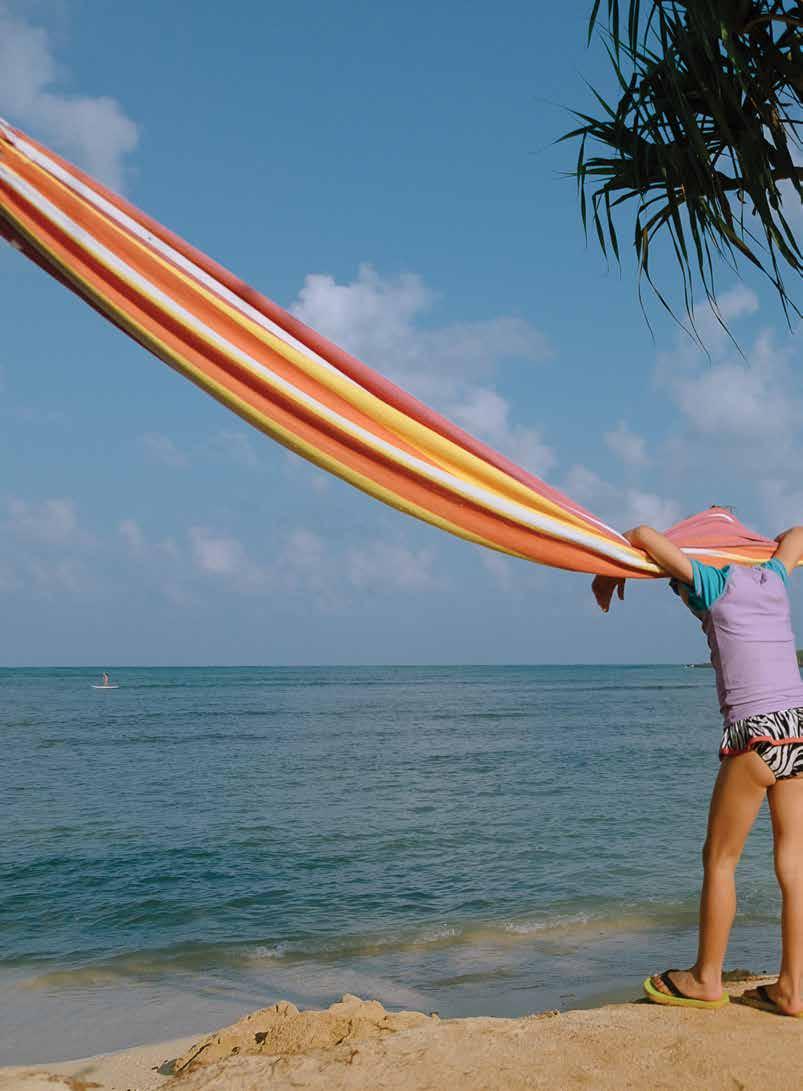

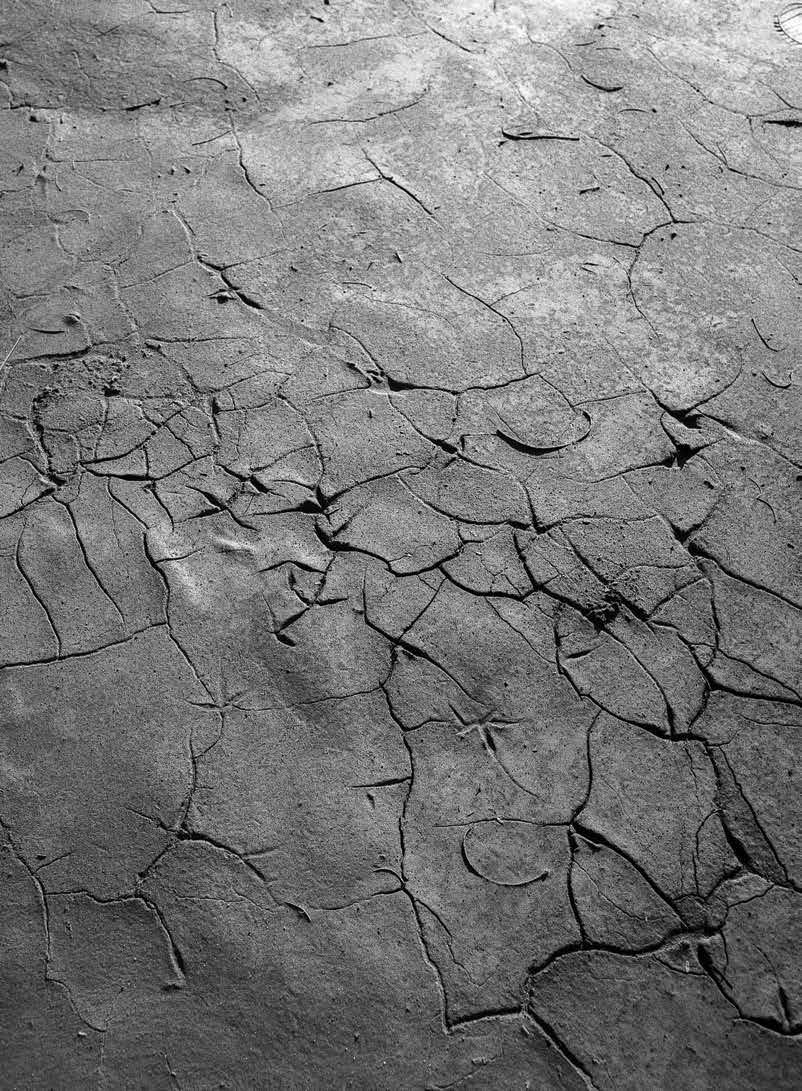
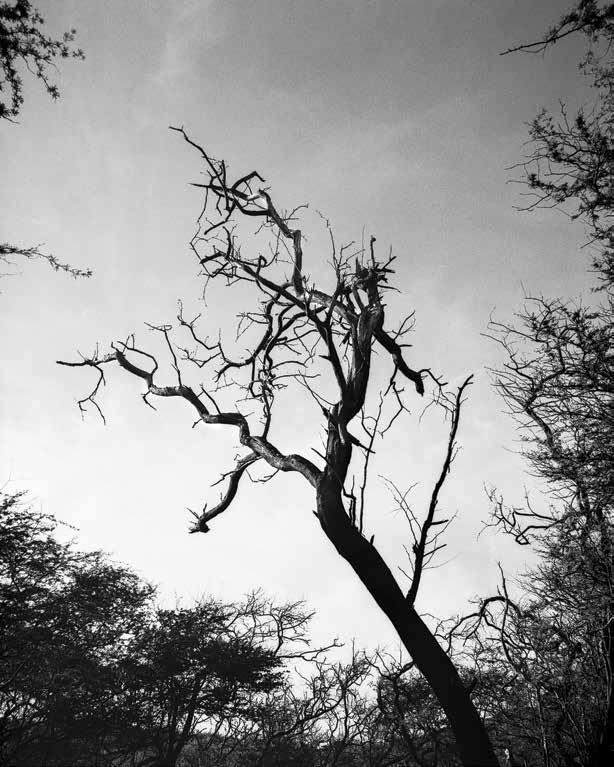
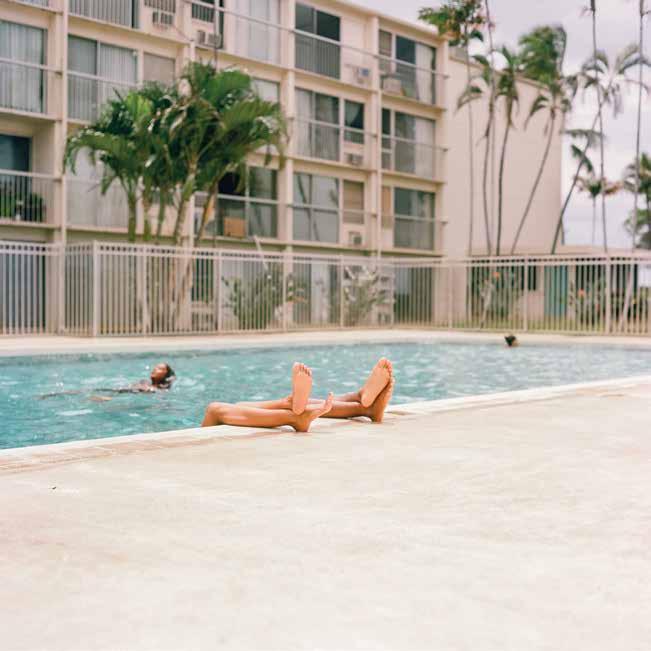
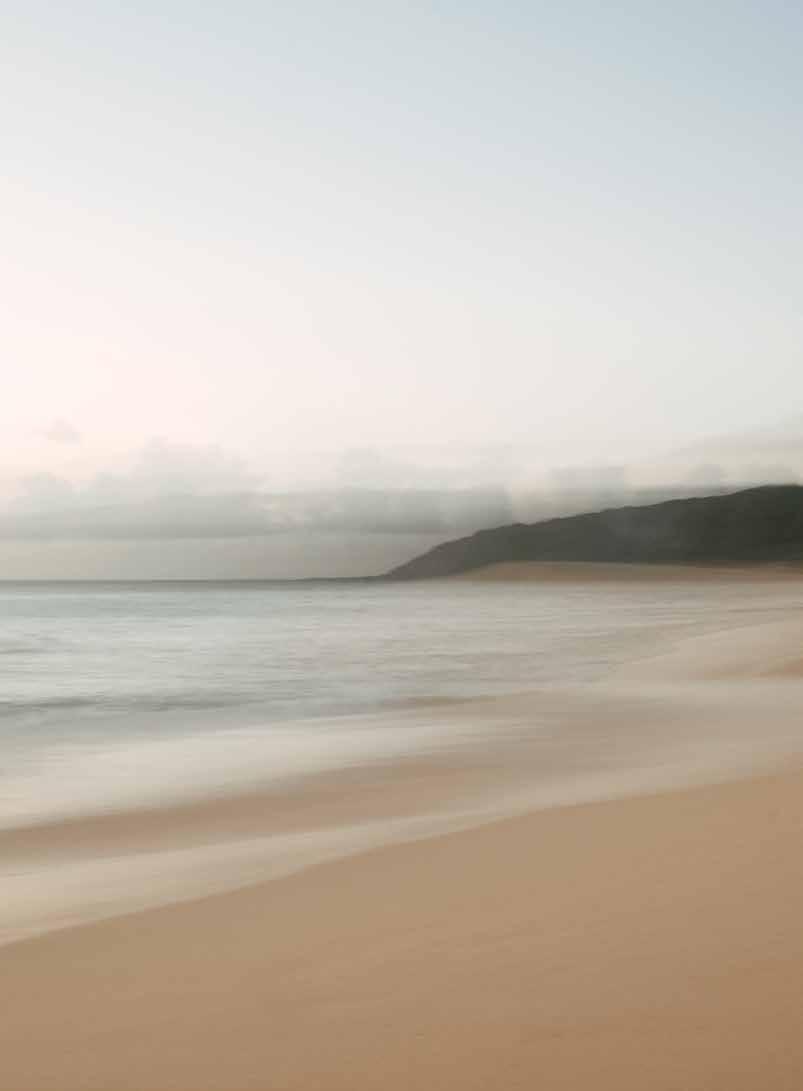
 Fishers of Hānā, Maui. Image by Kevin Brock.
Fishers of Hānā, Maui. Image by Kevin Brock.
EXPLORE
“Being Kanaka, being Hawaiian, is more about contributing to the community and being a part of what we know as Hawai‘i today.”—Isaac Bancaco
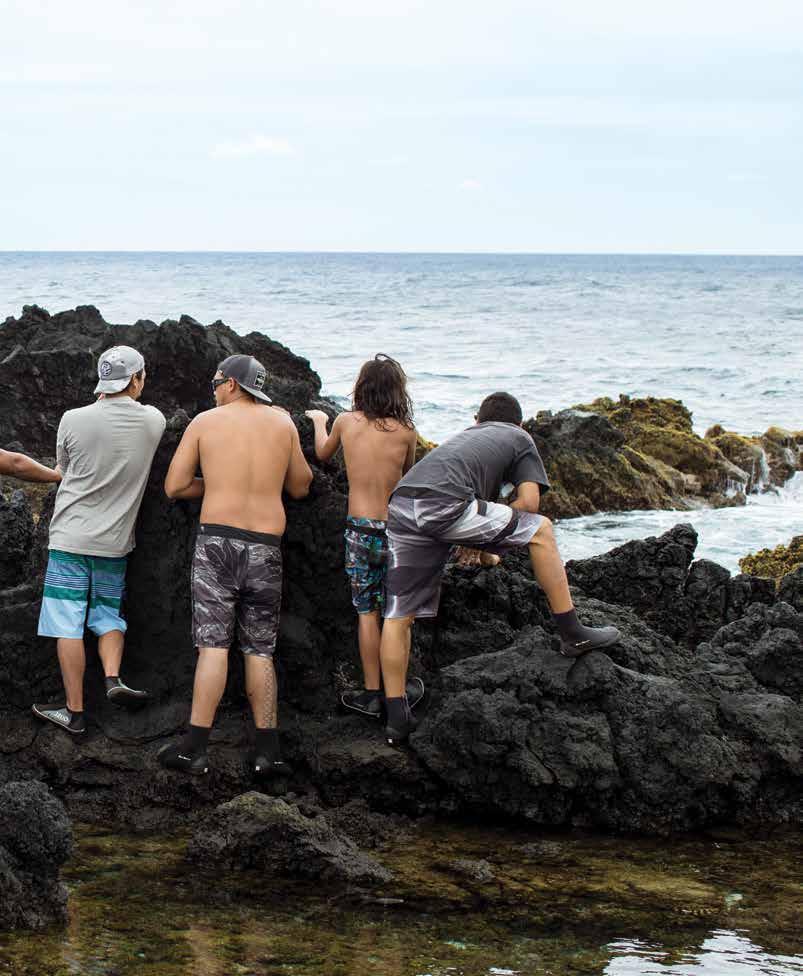
Kū Collective
A cadre of illustrious chefs come together with an East Maui community where the kua‘āina lifestyle persists.
TEXT AND
IMAGES
BY VIOLA GASKELL
On a rainy weekend this past spring, six Hawai‘i chefs gathered in Hāna to reconnect with the hunters, fishermen, and farmers of East Maui. These two groups—acclaimed chefs and everyday hunter-gatherers—embarked on what might have initially appeared to be an unlikely friendship when they first met in 2016. But their meeting was initiated by Ala Kukui, a Native Hawaiian-run retreat center in Hāna that privileges engagement with the immediate local community first and foremost. Hāna Kū, one of Ala Kukui’s main programs, brings these two groups of men together to integrate and deepen their practice and heighten their self awareness through holoholo, cooking together, and talking story into the night.
The impressive cast of chefs at its most recent gathering included Oʻahu’s Mark Noguchi of Pili Group and Dave Caldiero of Mud Hen Water and Kaimuki Superette; Maui’s Isaac Bancaco of Pacific’o on the Beach; Sheldon Simeon of Tin Roof; Kyle Kawakami of Maui Fresh Streatery; and Bella Toland, formerly of Banyan Tree and Hāna’s Travaasa Hotel.
Their day started with lending their kōkua to a new conservation site. Braving the rain, the chefs and local families cleared recently felled invasive trees, collecting armfuls of trunks and branches and throwing them in a wood chipper until the machinery had had enough and sputtered to a stop.
From there, they walked down to the coast to talk story and learn about the newly conserved land, and efforts to return it to community stewardship. In recent years the former ranch land was at risk of private ownership until Hāna residents formed a nonprofit that secured state, county, and private funding to purchase the parcel, designating it conservation land and ensuring the continuance of subsistence practices, namely fishing and gathering, on the coastal strip of the ahupuaʻa for future Hāna generations.
“There are food festivals all over the world, and there’s nothing like Hāna Kū,” Mark Noguchi said, looking around at the families gathered to hear a Hāna kupuna speak about the history and recent threats to the ground he stood on.
It was Noguchi’s sixth year coming to Hāna to meet with Kauʻi Kanakaʻole, her husband Ioane Park and other Hāna kanaka. Kanakaʻole, who runs Ala Kukui, wanted to bring Hāna men together with like-minded Hawaiʻi chefs who elevate food in the islands with respect for ‘āina and Hawaiian traditions.
To the right of Noguchi stood Naihe Akoi, a broad-shouldered, 35-year-old Hāna hunter and fisherman and father of four. It was Akoi’s third time at Hāna Kū, and his wife Poha and their two oldest children, Naihe Boy and Waianuhea, kept up with the laborious volunteer work all morning. For Naihe, there is no separation between his day-to-day life and the ‘āina and traditions the present chefs seek to perpetuate respect for in their work.
“It’s about unbroken generational knowledge,” Kanaka‘ole said, explaining that she wanted to highlight Hāna hunters and fishers and the knowledge they’ve passed down for centuries.
124 | FLUXHAWAII.COM
FLUX EXPLORE | HANA KŪ |
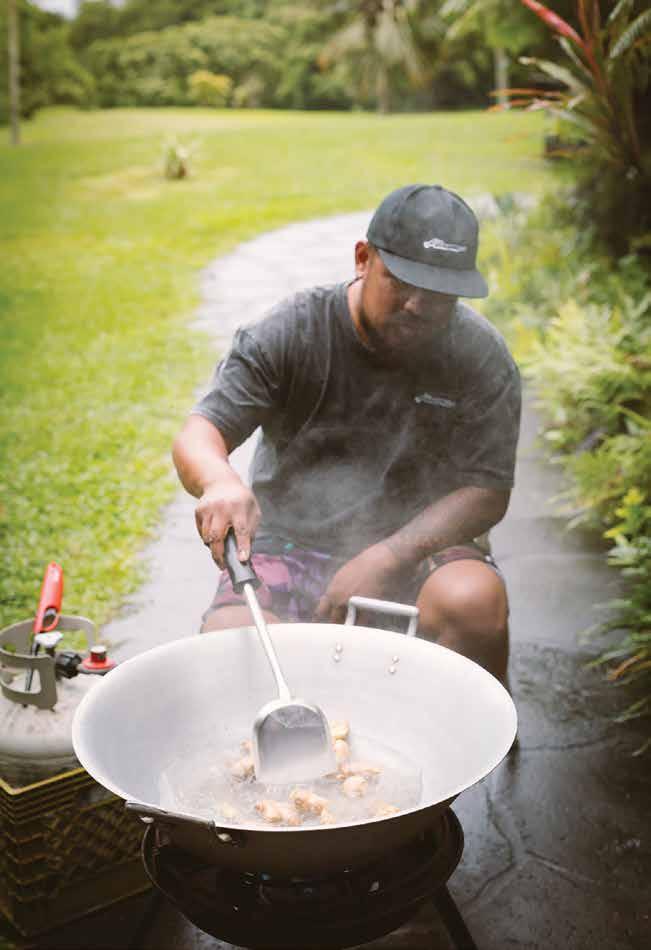
“It’s about unbroken generational knowledge,” Kanakaʻole said, explaining that she wanted to highlight Hāna hunters and fishermen and the knowledge they’ve passed down for centuries. She spoke to her Hilo cousin, the cultural practitioner and graphic designer Kūhaʻo Zane, and together they explored the question: “How can we elevate hunting and fishing as an intelligence that is place-based, familyspecific, and can’t be taught in any school?”
Before the pandemic, Ala Kukui and the Hāna Kū chefs would put on an annual fundraiser that highlighted the participating Hāna hunters and fishermen, and the chefs, who each had a station offering a signature dish. At a July 2019 event, Kanakaʻole and her hula hālau, Hālau o Nakaulakuhikuhi, performed a flourish of sophisticated ʻauana dances. The party, which delighted guests and secured funds for future programs, represents the more widely known public-facing side of Hāna Kū. But the more intimate weekends, when twice a year the chefs came to Hāna to holoholo with a family with a long lineage in the remote, sparsely developed town, have always been the fulcrum of Hāna Kū.
Hāna is the perfect setting for a group of chefs to embrace one another, having left the stress and hypercompetitiveness of their industry somewhere along the 50-mile, twolane highway that weaves between oceanside drop offs and tree-laden rock face. It is a place, protected by its remoteness and the conviction of its community, where Hawaiian families supplement their store-bought groceries with a subsistence lifestyle, as they did generations ago. “Hāna—it just speaks to you, it’s a reset,” said Simeon. “And Hāna Kū is a safe space where I can be completely vulnerable and share and cut loose.”
The chefs stay at Ala Kukui and a Hāna family takes them on excursions and cooks with them, and they really get to know one another, Kanakaʻole
explained. These holoholo include hunting boar, pole fishing by boat, spearfishing along the shore, and gathering prawns in streams. Later they gather at the Ala Kukui kitchen and prepare a feast together, the chefs sharing the tricks of their trade, and the hunters and the Hāna men showing theirs. Naihe, for one, makes a mean sausage from the boar he hunts in the East Maui mountains. Last fall, chef Leanne Wong, of the Lahaina restaurant Papa ʻĀina, made succulent akule dumplings from a bounty of small fish caught at Hāna Bay in the days before she and the other chefs arrived.
“And after they cook, we talk story,” said Kanakaʻole. The chefs at Hāna Kū are not just any chefs; they are Hawaiʻi chefs working to cultivate an appetite for Hawaiʻi-grown foods rich with history and cultural relevance. Their menus, whether at five-star hotels or fan-favorite food trucks, have a sense of place that hints at the rich multiculturalism of Hawaiʻi, and are a pointed departure from the tourismforged imported palate of the islands’ recent past. At the fall session, after Wong’s akule dumplings had been happily devoured, the group sat on the floor around an ʻawa bowl and Park served the native drink as the men spoke about how they could deepen their practice. The topic of how one’s practice makes one Kanaka surfaced.
Bancaco, who grew up spearfishing with his family in Maui waters, has found esteemed homes for his food philosophy. At Andaz Maui, he sourced around 85 percent of ingredients locally (the inverse of the percentage of food that Hawaiʻi imports), and Pacific’o on the Beach, where he is now the head chef, has its own farm in Kula, the Upcountry area where he grew up.
The five-year Hāna Kū alum points out that precontact Hawaiians sustained themselves within a one-mile radius: hunting, fishing, farming, and gathering from within their ahupuaʻa and making full use of their resources. These are
perhaps tenets of Bancaco’s cooking that make him a Kanaka in his daily life. In his cooking, he often supplants the umami burst typically given by anchovy with salted and cured ‘ahi blood line — a nutrient-rich part of the fish that the vast majority of chefs discard.
Bancaco said his childhood was not steeped in traditional aspects of the culture that one might think of as Hawaiian: he never learned to dance hula and his parents did not speak ʻōlelo Hawaiʻi in the home. “For me, being Kanaka, being Hawaiian, in today’s Hawaiʻi is more about contributing to the community and being a part of what we know as Hawaiʻi today.”
After garnering acclaim as a chef at Oʻahu’s He‘eia Kea Pier General Store and Deli and with his catering company Pili Group, Mark Noguchi is now focusing his energy on developing food and ʻāina based curriculum at Punahou School. A second generation Hawaiʻi-born Japanese chef, Noguchi highlights the nuance of Hawaiʻi’s multiculturalism and the pride to be found in connection with one’s birthplace while owning a separate ancestry. “ What I think Hāna Kū does for me is it reinforces my pride in who I am and where I came from,” he said.
Noguchi was part of the original Hāna Kū clan in 2015, having met Kanakaʻole while dancing hula on Hawaiʻi Island in the mid-‘90s. Over the years he has come to know the East Maui families who live off the land there and he said he has seen first hand the impact the Hāna men and chefs who’ve come over the years have had on one another.
“Naihe started his own treepruning business in the last few years, and I think Hāna Kū helped to give him the confidence to do that,” Noguchi said. “Hanging out with chefs from the city, from town, I think it showed that you can expand your life, your work, your business, and still be a local braddah. That seeking more for your family does not make you less kuaʻāina.”
126 | FLUXHAWAII.COM
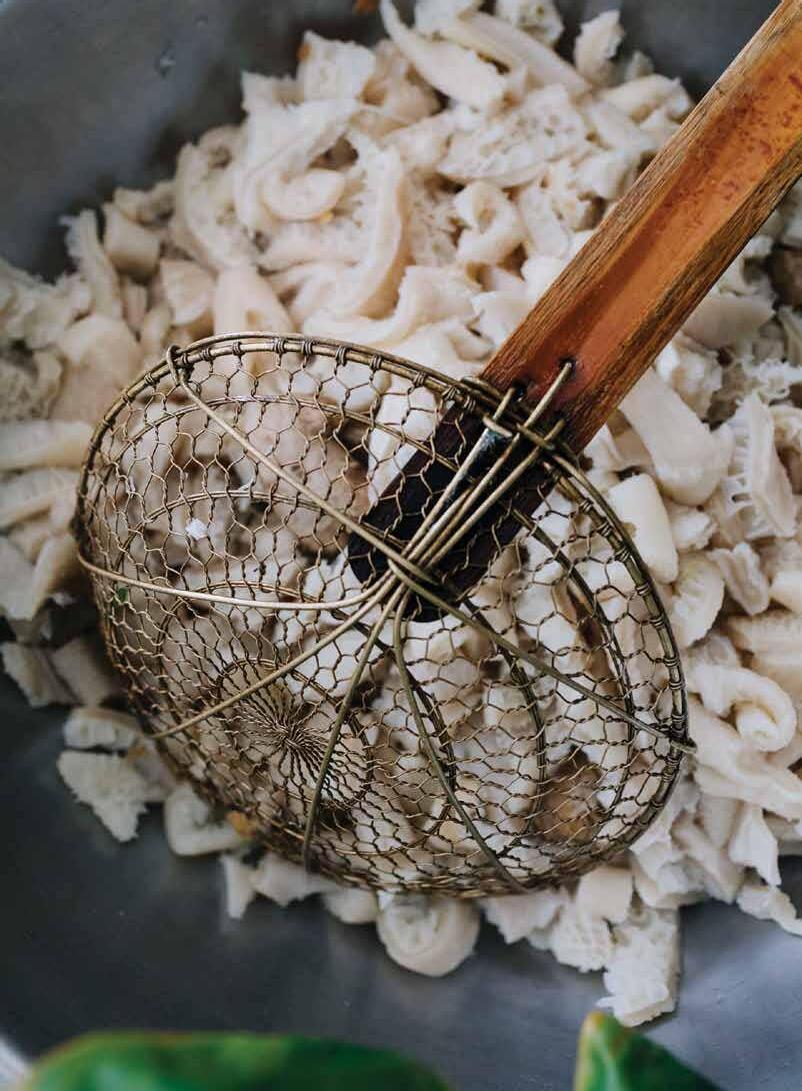

At Kawakami’s first Hāna Kū in 2018, he woke up at 5 a.m. to slaughter and butcher a cow with the Parks, a multigenerational Hāna family of ranchers and fishermen. “That was a first for me and I still remember it and appreciate the process and what I learned that day. I’ve learned something new every time I go out to Hāna, from the other chefs and from the Hāna guys,” Kawakami said.
This past spring at Hāna Kū, Kawakami and his son made takoyaki, a playful Japanese street food, from octopus they caught diving off the Hāna coast. His son twirled the batter, octopus, and green onion with skewers in spherical tins until the mixture was transformed into orbs of succulent umami-rich flavor bombs topped with bonito flakes that curled from the heat, Kewpie mayo, and unagi sauce.
To complement the takoyaki, Kawakami made a pohole salad with a Laotian spice mix and prawns that Park plucked from a Hāna stream earlier in the week. “I had to go to the stream twice,” Park
explained. “The first night it rained and it was difficult to see the eyes glowing with the rain drops pelting the surface of the water.”
Noguchi made white chicken chili, his wife’s grandmother’s recipe, that he topped with nori-dusted oyster crackers. Caldiero used sour oranges from the Ala Kukui grounds to make escabeche with uku that Bancaco brought, and served it with lightly pickled local vegetables and fresh sourdough bread he brought over from Oʻahu’s Breadshop, a craft bakery in Kaimukī. Simeon prepared tripe in the style of Portuguese bean soup. One of the Hāna families made Hawaiian-style pork and beans, and Keliʻi Heen, managing partner of Argex Beverages and cocktail extraordinaire, kept the citrus cocktails flowing.
Gathered around the ʻawa bowl, Naihe said to the chefs that he has come to know over the years, “You guys have inspired me to look deeper. There is always something deeper, in people, in practices. I want to mahalo you guys for valuing the holoholo practitioner.” Then addressing
Kanaka‘ole’s hunch that the zealousness of the chefs she invited and the ingrained knowledge the Hāna men possess would bind them has been an undoubted success.
128 | FLUXHAWAII.COM
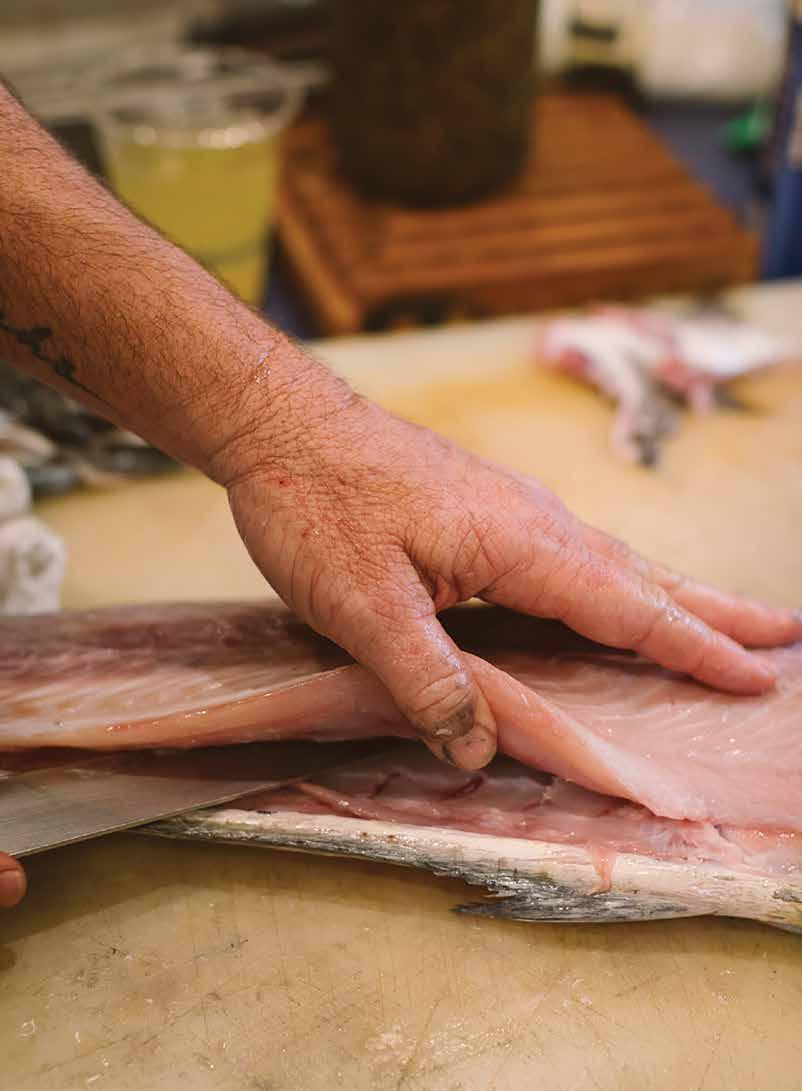
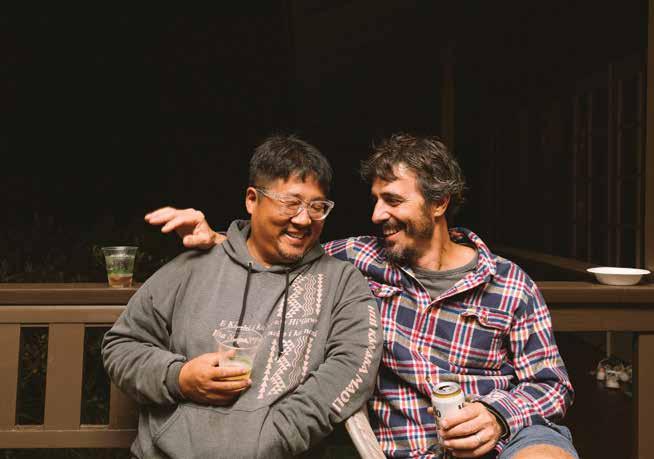
the circle, he thanked the chefs for sharing a “just charge, no be scared” mentality that encouraged Naihe to step into new frontiers professionally. “Looking at these guys, we have all kinds of success stories around here,” he said with deference. The Hāna guys are accomplished in their own right, from Naihe and his tree trimming operation to Kīpahulu-born Greggie Lind and his thriving fish business, which sells to chefs like Bancaco but sells the majority of his catch to his own community at reasonable prices.
Kanakaʻole’s hunch that the zealousness of the chefs she invited and the ingrained knowledge the Hāna men possess would bind them has been an undoubted success. Normally a community that justifiably defends its resources against outsiders, the very Hāna men who have depended on these resources all their lives shared their knowledge with and spoke of the chefs affectionately. “If you’re not doing it, you’re learning how to do it, I respect that,” said Biggie Smith, who grew up
fishing down the road in Waikoloa.
Around the ʻawa bowl, Caldiero, who grew up in New York, recalled a humbling learning experience of his own at his first Hāna Kū in 2018 when the Hāna guys took him and the other chefs to throw net. “I remember Ioane could see the fish and he was about to throw the net, and I’m right there next to him and I can’t see shit,” he said with a laugh, adding that he had “come a long way” in these last four years.
Despite any initial inexperience that chefs like Caldiero might have shown outside the kitchen, the Hāna guys recognized the intelligence they possessed within it. Naihe compared the chefs’ instincts in the kitchen to his own instincts while stalking wild boar or deer in the wilderness. “It isn’t just the training of what to do, it’s how we think,” Naihe said. “To me it’s an art, it’s a state of feeling.”
“And after they cook, we talk story,” said Kanaka‘ole. The chefs at Hāna Kū are not just any chefs; they are Hawai‘i chefs working to cultivate an appetite for Hawai‘i-grown foods rich with history and cultural relevance.
130 | FLUXHAWAII.COM


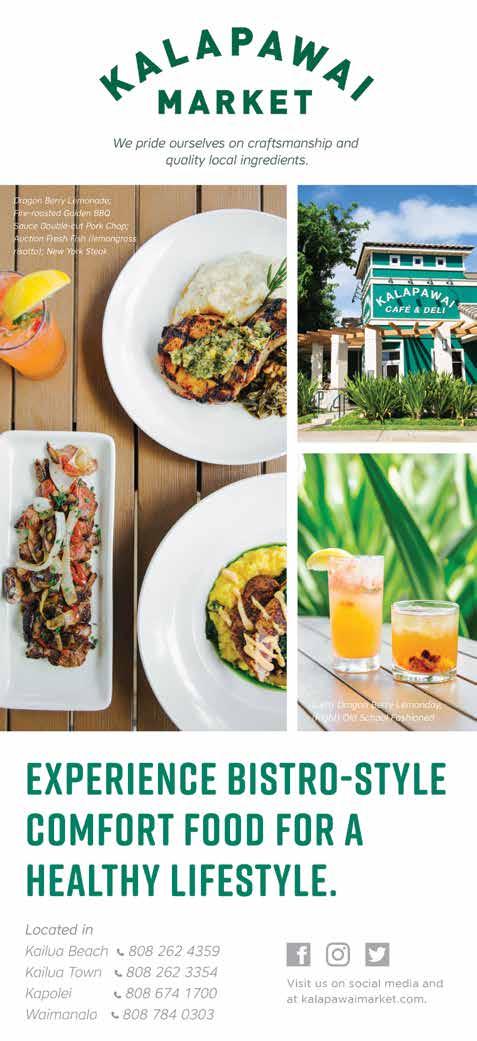
WATCH NOW ONLINE NMGnetwork.com/FLUXTV
FLUX EXPLORE | KUMUKAHI |
I Pa‘a Ka Mo‘olelo, I ‘Ole E Nalowale
He mau waihona palapala kahiko ko Hawai‘i, kahi e mālama ‘ia nei he ho‘oilina nui o ka waiwai a makamae ho‘i no ka mo‘omeheu a me ka ‘ōlelo ‘ōiwi o Hawai‘i.
‘Oiai he wā kēia e noa wale ai ka ‘ike ku‘una i ka lehulehu, pehea ho‘i kākou e ho‘okumu ai i nā loina o ke komo ‘ana i loko o laila, i mea e ho‘omoamoa pono loa ‘ia ai ia ‘ike a me nā waihona nāna ia e mālama nei?
KĀKAU ‘ IA NA FRANK E. KAʻIUOKALANI DAMAS
PA ‘ I KI ‘ I ‘ IA NA KEATAN KAMAKAIWI
HO ‘ OPONOPONO ‘ IA NA N. HAʻALILIO SOLOMON
ʻAʻole nō e hala ka inoa o Mary Kawena Pūkuʻi i ka ʻike o ko kēia au; e ʻole ʻo ia nei, ola mau ai hoʻi ka ʻike ʻōlelo Hawaiʻi, ka ʻike moʻomeheu Hawaiʻi, ka ʻike loina Hawaiʻi, a ia ʻike aku ia ʻike aku. He mau puke e paʻa mau nei i ka lima o nā Hawaiʻi, i kākau ʻia e ua Pūkuʻi Wahine nei. Ma ka waha nō naʻe kāna ʻōlelo wali mai ke kumu mai o ka pō, ke kahua hoʻi i paʻa ai ia ʻike kūlipolipo a ko Hawaiʻi e kaena aʻe nei i kēia mau lā. Eia naʻe ka mea kupanaha, ʻoiai kāna kākau ʻana i ka puke wehewehe ʻōlelo Hawaiʻi—ke kāpena nō paha o ko kākou moku ʻōlelo Hawaiʻi—kākaʻikahi wale nō ka poʻe i lohe i kona leo, me ka leo hoʻi o nā ʻelemākule a nā luāhine hoʻi o ke au i hala, na lākou nō i hoʻākāka i nā hiʻohiʻona like ʻole a pau ma ke kūkā kamaʻilio ʻana me ua Pūkuʻi Wahine nei.
He limahana pūlama nui loa ʻia ʻo ua Pūkuʻi Wahine nei no ka Hale Hōʻikeʻike o Pīhopa no kanalima a ʻoi makahiki, a ma laila e waiho mau ai ia waihona leo nahenahe o ko
‘O Damas ma ka wala‘au pū ‘ana me nā hoa māka‘ika‘i ona, ‘o Taupōuri Tangarō lāua ‘o N. Ha‘alilio Solomon. E noho ana lākou ma luna o nā ‘ā pele, aia ma Kumukahi, Puna, Hawai‘i.
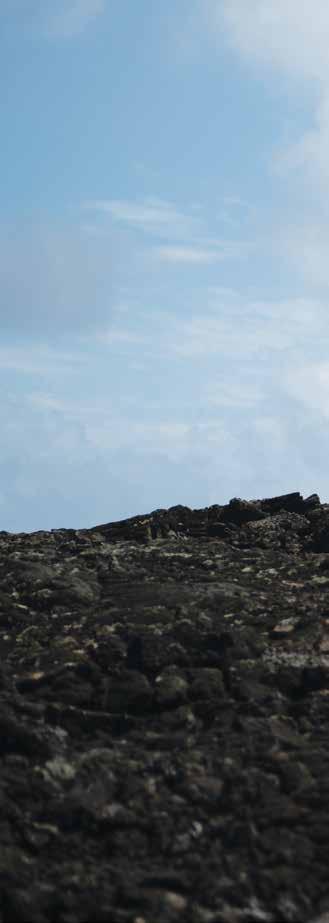
132 | FLUXHAWAII.COM
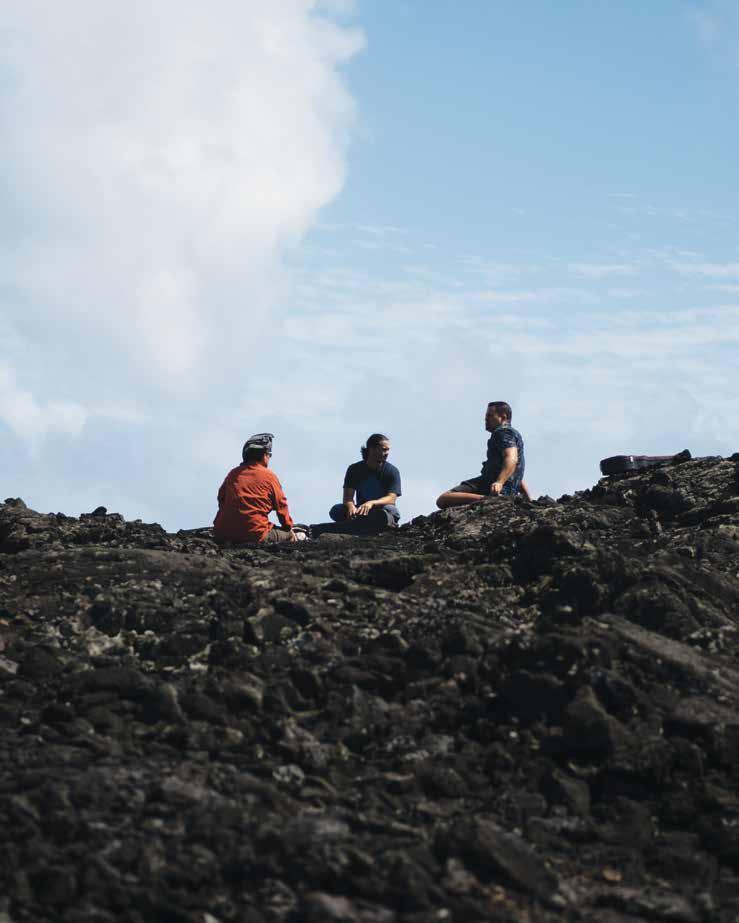
133

ke au ma mua, he 850 a ʻoi hola. Ma laila e waiho mālie mai ana kāna mau hana luhi like ʻole a pau, pau pū nō hoʻi me nā nīnauele ʻana āna i nā kānaka ʻōlelo Hawaiʻi o kona wā. ʻO ka mea ʻāpiki naʻe hoʻi, no ka loli ʻana o ke au o ka manawa a me ke ʻano o ka nohona, he paʻakikī paha ka lohe ʻia ʻana o ua mau leo nahenahe lā e ka pepeiao o ko kēia au. Aia nō hoʻi ka pono ʻo ka hele kino ʻana aku a noho i mua o ka lolo uila o ia wahi, kau ke apolohe, kani ka leo. He ʻelua lolo uila o ia wahi i hoʻokoe ʻia no ka hoʻolohe ʻana i ia mau mea, no laila inā ʻo ke kolu ʻoe, ʻo ka hoka nō ia. He waiwai lua ʻole kēia waihona ma ka ʻike moʻomeheu, ka ʻike ʻāina, ka ʻike ʻōlelo Hawaiʻi, a nui hou aku; na wai lā hoʻi e ʻole! A inā nō paha kākou e huliamahi aku nei i ka ʻimi loa ʻana a paʻa hou mai ka Hawaiʻi ʻana, e alahula mai nō ia wahi i kānaka, ʻaʻohe o kana mai! ʻO ka mea hilu loa hoʻi o ia waihona, ua hānau ʻia ona kānaka nīnauele ʻia ma mua, a ma hope pono iki paha, o ka hoʻokahuli aupuni; he mau kānaka i hānai piha ʻia paha ma ka ʻōlelo Hawaiʻi; i hele kula nō paha ma
ka ʻōlelo Hawaiʻi; i launa nō paha me nā hoa ʻōlelo Hawaiʻi piha—ʻo ka ʻōlelo Hawaiʻi nō ka ʻōlelo o ka ʻāina ma ia wā. I wahi kumu hoʻohālikelike wale nō e makili iki mai ai ka lā i Kumukahi, eia kekahi mau ʻike i paʻa iā Joseph Kealiʻikūikamoku ʻĪlālāʻole, he kama na ka ʻalā paʻa o Kaueleau. ʻO kekahi nō ia o nā kumu hula hanohano o ua Pūkuʻi Wahine nei, a ma o kā lāua pilina i huʻe pono ʻia mai ai ka ʻike kūliʻu o ua ʻo ʻĪlālāʻole. Ua laha loa kona inoa i kāna aʻo ʻana i ua Pūkuʻi Wahine nei i ka hula, a laha maila i ka lehulehu. He kanaka ʻike nui loa nō naʻe ia: he ʻike i ke kuku paʻūpaʻū me nā wai e hoʻoluʻu ai; he ʻike i ka lāʻau kau me ka lāʻau kāhea; he ʻike i ka haku ʻana i nā ana kapa kuiki; he ʻike i ka humuhumu lei pāpale; he ʻike i ka ulana ʻana i ka lau hala, a ia māhele ʻike aku ia māhele ʻike aku i huʻe ʻia ma ka ukamaʻilio ʻana o lāua. ʻO kā ua Pūkuʻi Wahine nei mea nui naʻe, ʻo ia ka nīnanīnau ʻana iā ia i nā inoa ʻāina o Puna i mea e paʻa mau ai, no ka mea hoʻi, ma kona noʻonoʻo ʻana aʻe, “Minamina o nalowale.”
He mau hola ka hele ‘ana ma ka wāwae mai ke alanui aku, kahi ho‘okū ka‘a, a hiki i ka lae ‘o Kumukahi. Ma mua, he wahi kele i ke ka‘a. Ma hope na‘e o ke kahena hope a‘e nei o ka pele, e aho ke kele i ka wa‘a he ‘umi ihu no ka mea he ‘ālualua ke ala.
Visit fluxhawaii.com/ section/olelo-hawaii to read this story in English. This piece is part of Flux Hawaii’s Hawaiianlanguage reporting series featuring articles conceived, commissioned, and produced all in ‘ōlelo Hawai‘i, in partnership with Google News Lab.
134 | FLUXHAWAII.COM
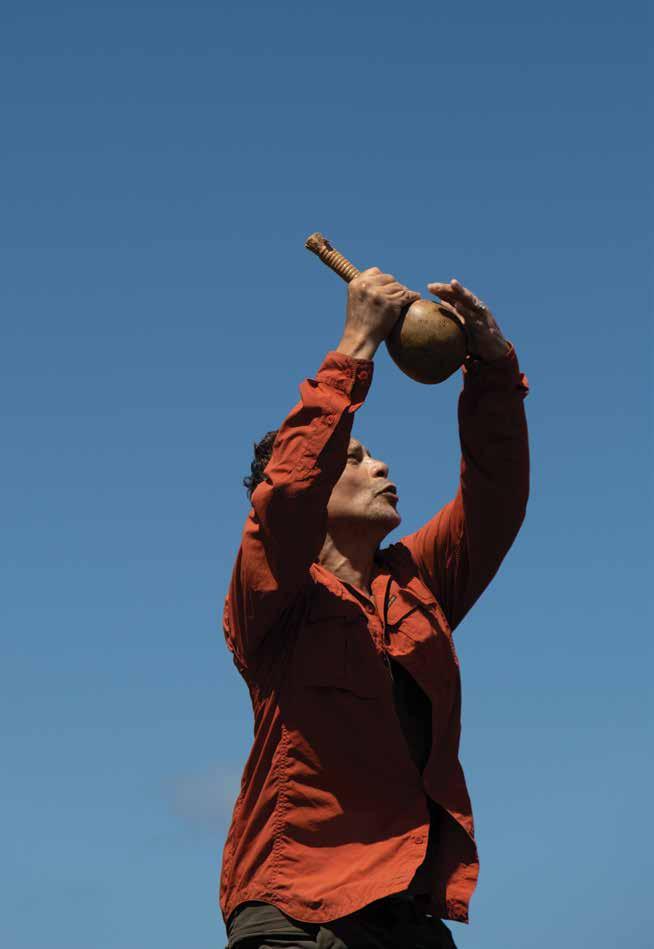
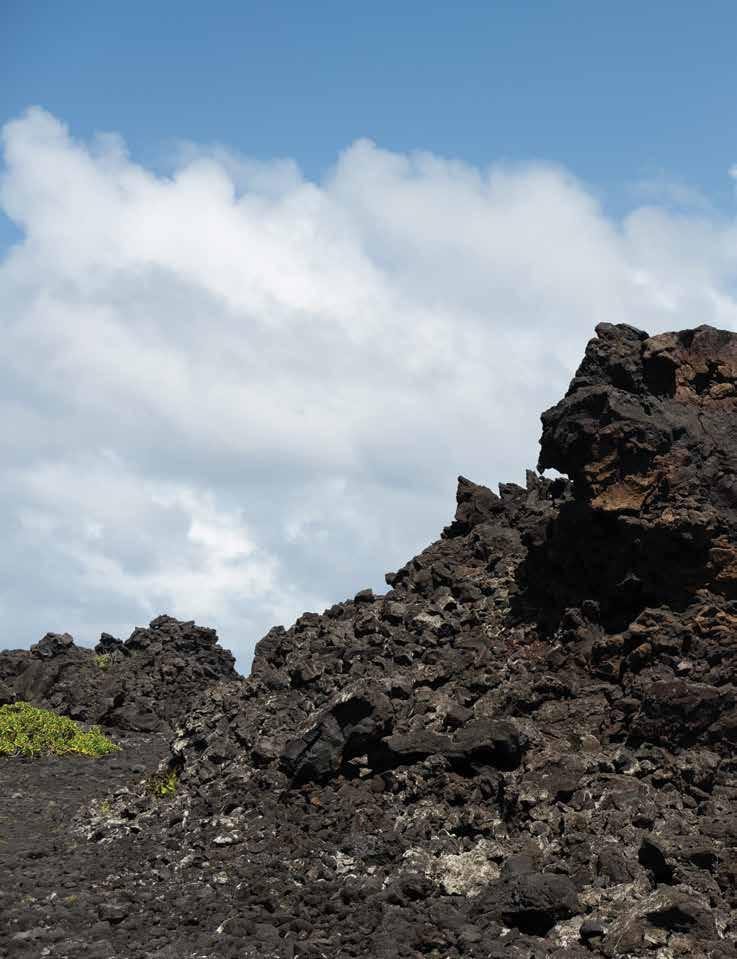

Ma ia huakaʻi ʻana a lāua i nā inoa ʻāina o Puna paia ʻala i ka hala, ʻo ka hoʻomanaʻo aʻela nō ia o ua ʻo ʻĪlālāʻole i nā pana o ka ʻāina, ʻo ia hoʻi, nā moʻolelo nui e pana ʻia aku ai ka inoa. ʻO Honolulu nō hoʻi kekahi o ia mau pana ʻāina, i mau mai ai hoʻi ia inoa pana ma ka hoʻoheno ʻana penei,
Aia i Honolulu kuʻu pōhaku, ʻO Keʻalohilani kuʻu haku ia.
Ua paʻa mau nō ia mau inoa ʻāina a hiki i kēia wā. Hoʻomanaʻo aʻela nō naʻe ʻo ʻĪlālāʻole; ʻo Keʻalohilani ke kāne a ʻo Honolulu kāna wahine. Ma muli hoʻi o ke ʻano lili a huhū mau o Pele, ua hoʻolilo aku nō hoʻi ia Wahine o ka Lua iā lāua ala a kū a pōhaku, a aia nō ke waiho ala a hiki i kēia mau lā. ʻO lāua nō kekahi o nā kupua he lehulehu i luku ʻia e Pele ma Puna.
Hoʻomau akula ua Pūkuʻi Wahine nei a me kāna kumu hula aloha i kā lāua huakaʻi mākaʻikaʻi i nā inoa pana ʻāina o Puna, hōʻea akula i nā niu moe kaulana o Kalapana. Ma ia wahi naʻe, lohe ʻia ko lāua hoʻopaʻapaʻa iki ʻana. ʻO ia hoʻi, ua lawe ʻia nō ʻo Pūkuʻi a me ona hoa huakaʻi e ka mea āna i kapa ai ʻo Māmā Keake, a ʻike lākou i nā niu moe kaulana o Kalapana, “Ua hele a hihipeʻa i ka nāhelehele.” Hōʻole mai nō naʻe ua ʻo ʻĪlālāʻole, “ʻAʻole, ʻo ka niu moe pololei maoli o Kalapana i kapa ʻia ai kēlā wahi he niu moe, aia i waho nei.” ʻO ia hoʻopaʻapaʻa nō ia o lāua nei a hāʻawi pio iki ua ʻo ʻĪlālāʻole, no kona ʻike ʻana paha, ua loli ke ʻano o ka ʻāina ma nā makahiki lōʻihi āna i noho ai ma kona ʻāina hoʻokama, ma Aia i Honolulu Kuʻu Lei Hōkū.
Pēlā lāua i mākaʻikaʻi mau ai i nā ʻāina o Puna ma ka hōʻoia ʻana i nā inoa ʻāina, ka puana ʻana, ka pela ʻana paha, a me nā moʻolelo pana ʻāina e pili pū ana. ʻO ke ake nō hoʻi paha o ka mea hoʻolohe, ʻo ia ka nānā ʻana i ka palapala ʻāina a lāua e nānā ana paha lā ma ia huakaʻi kamaʻilio ʻana a lāua. A ma ʻō aku o ka ʻike palapala ʻāina, ʻo ke kaʻikaʻi ʻana a nā wāwae ma ia mau wahi a ʻike i nā pana kaulana o ka ʻāina: ka heiau ʻo ʻĪmakakōloa no ka hula ma uka o Hīlea Uka, ʻo ka ʻalā paʻa o Kaueleau i Kanane, a hala aku nō hoʻi a Pohoiki kahi o nā wahi uʻi loa o ka ʻāina, a Kawaiakeakua i ʻOpihikao, a ka hoʻolele kē ʻana a kamaʻāina i ka lua hoʻolele kē o Malama, i hea ʻia ai hoʻi ka ʻōlelo, “kēlā kē, kēia kē; kēlā kē, kēia kē, a lele!” e ka poʻe hoʻolele lāʻī e pāʻani hoʻolele kē ana, a Waiʻākōlea aku i ulupā ʻia e ke kai nui a hoʻokē ʻia, āhua ke one i luna, a ia wahi aku ia wahi aku.
Hōʻea akula ko lāua mau hoʻomanaʻo ʻana a ka lae kaulana i ka hikina, a Kumukahi. A nīnau akula ua Pūkuʻi Wahine nei i kāna kumu hula, iā ʻĪlālāʻole, inā paha ua paʻa nā inoa o nā wāhine a Kumukahi, i hoʻohani ʻia mai nō a hiki loa mai i kēia wā ma ka hula ʻana,
E hoʻoipo ana me Haʻehaʻe, Me nā wāhine noho kahakai.

‘O ka ho‘okupu ‘ana o Damas i kāna hula i hula ai no ko laila po‘e kama‘āina. ‘O ua po‘e kama‘āina nei, ua helu ‘ia nō ko lākou mau inoa ma loko o kēia mo‘olelo.
ʻO ia nō hoʻi nā wāhine nō a Kumukahi i ʻōlelo ʻia aʻe nei. ʻO ka helu akula nō ia o ua ʻo ʻĪlālāʻole i nā inoa o nā wāhine noho kahakai a Kumukahi: ʻo Haʻehaʻe, ʻo Makanoni (i puana ʻia hoʻi ʻo Makānoni a ʻo Makaʻānoni paha), ʻo Pāʻūpōʻulu, a ʻo Wainonoʻula. Wahi nō hoʻi a kekahi poʻe, ʻo Hanakaulua ka lima o ka wahine. He mau pōhaku ia mau wāhine e noho ala, a ma ka ʻike ʻana o ua kupa nei o ka ʻalā paʻa o Kaueleau, he helu ʻana hoʻi kā lākou i ke neʻe ʻana o ka piʻina a ka lā. Hele nō ka lā a hiki ka puka ʻana i Wainonoʻula, hoʻi aku. ʻO ia hoʻi ʻana a ka lā a hiki aku nō i Kumukahi me Pāʻūpōʻulu, pau.
ʻO ia moʻolelo i hōʻike ʻia aʻe nei, ʻo ia nō paha kahi hoʻokahi e helu ʻia ai ia mau inoa o nā wāhine a Kumukahi e waiho ana ma ke ʻano he pōhaku, me ka wehewehe pū ʻana mai i ke ʻano i hoʻohana ʻia ai e ka poʻe kahiko ma ka nānā ʻana i ka piʻina a ka lā. He mau ʻōlelo liʻiliʻi nō paha aia ma ʻō a ma ʻaneʻi e hōʻiliʻili ʻia ai. Aia naʻe i ka poʻe paʻa moʻolelo o ke au ma mua, i hoʻopaʻa ʻole ʻia ai ko lākou ʻike a me ko lākou mau manaʻo ma nā puke, nā
138 | FLUXHAWAII.COM
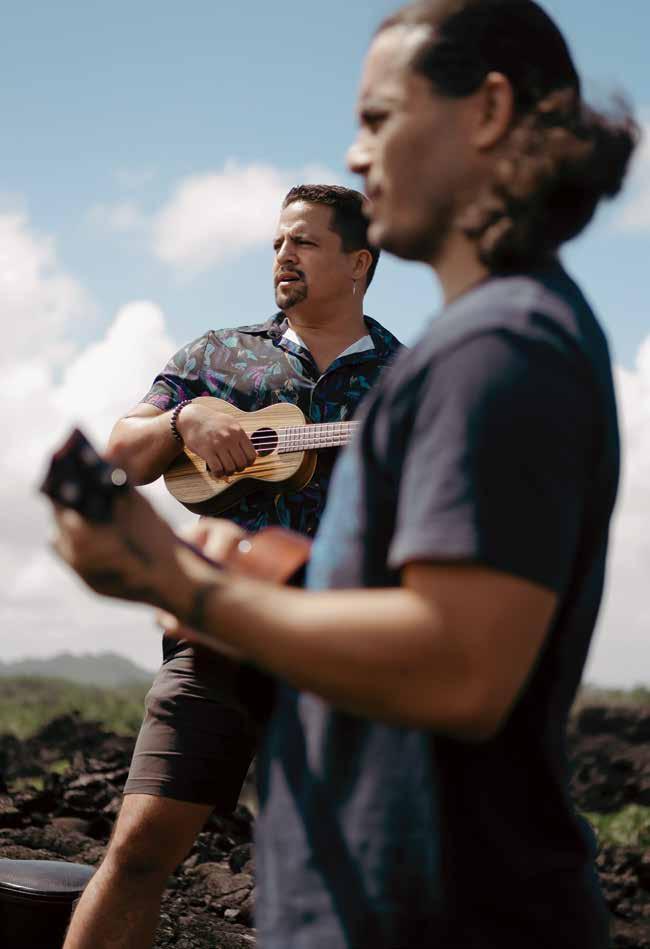
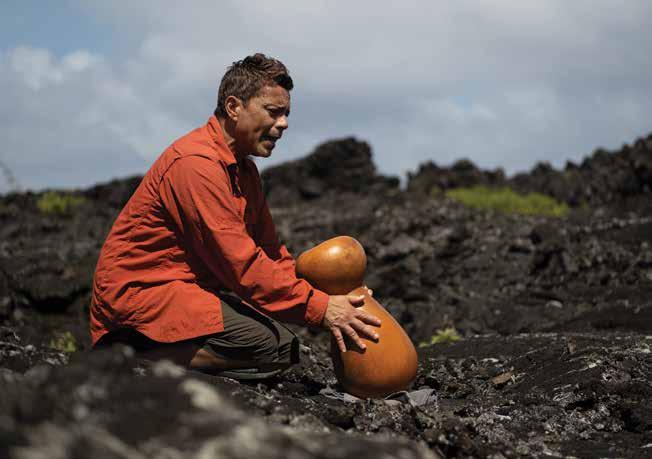
nūpepa, a ia mea aku ia mea aku. Pehea lā ko kākou ʻimi ʻana i ka pono o ko kākou moʻolelo Hawaiʻi a me ka pono o kā kākou ʻōlelo Hawaiʻi i paʻa pono ai ia mau ʻike. Ma ke akamai o “ka wahine hoʻolaʻi me ka lei kukui” i paʻa ai ka leo o ia poʻe kahiko ma ka lola. Aia nō ia mau leo ke waiho lā, ke kali ala nō hoʻi i ka poʻe o kēia wā e kiʻi hou aku, e hoʻolohe hou aku, a e hoʻōla hou aku. Wahi hoʻi a kekahi poʻe, he mau ʻike kapukapu ke waiho ala ma ia waihona, i kūpono ʻole hoʻi ka hoʻolohe wale ʻana o ko ke au nei. ʻAʻole hoʻi i waiho wale ʻia ka ʻike ma kauwahi e kāʻili wale ai ʻo haʻi. Pehea lā naʻe ka pono? Eia kākou i ke au noanoa o ka ʻike no ka ʻimi loa ʻana e hoʻōla hou i ka ʻike a me ka ʻōlelo Hawaiʻi, e hoʻāla hou i nā loina o ka wā kahiko i poina ʻia e ko ke au nei. Inā e hoʻonoa wale ʻia nā ʻano ʻike like ʻole a pau, e hapa mai ana nō anei ka ʻihiʻihi?
Inā naʻe paha e waiho wale ʻia ma kona wahi kapukapu e moe mau ai, e ʻike ʻia ana nō paha ia mea kapukapu, a nalowale paha i kēlā ʻaoʻao ma ʻō?
E nā hoa hoʻoheno o ka ʻike Hawaiʻi,
aia nō ka pono ʻo ke ola o ia ʻike a kākou e hoʻomakauliʻi nei. ʻAʻole kākou e waiho wale aku i ka ʻike a hala loa i ke ao pau ʻole, aia nō i kēia ao ke ola. E like nō paha me ka nui o ke kaena ʻana o kākou i ke ola o ka ʻōlelo Hawaiʻi me ona ʻike a pau, pēlā ke kiʻi ʻana aʻe i ka ʻike i waiho aloha ʻia mai na kākou. ʻEu mai, e nā hoa, hō aʻe hoʻi i ke ola ahuahu o ko kākou Hawaiʻi ʻana, a mau loa aku nō!
‘O Taupōuri Tangarō, he kumu hula, ‘o ka Luna no nā Loina Hawai‘i ho‘i ma ke Kulanui o Hawai‘i ma Hilo a me ke kula kaiāulu o Hawai‘i. Hō‘ike ‘ia ‘o ia ma kēia ki‘i ma kāna ho‘opa‘a ‘ana i kāna mele.
140 | FLUXHAWAII.COM
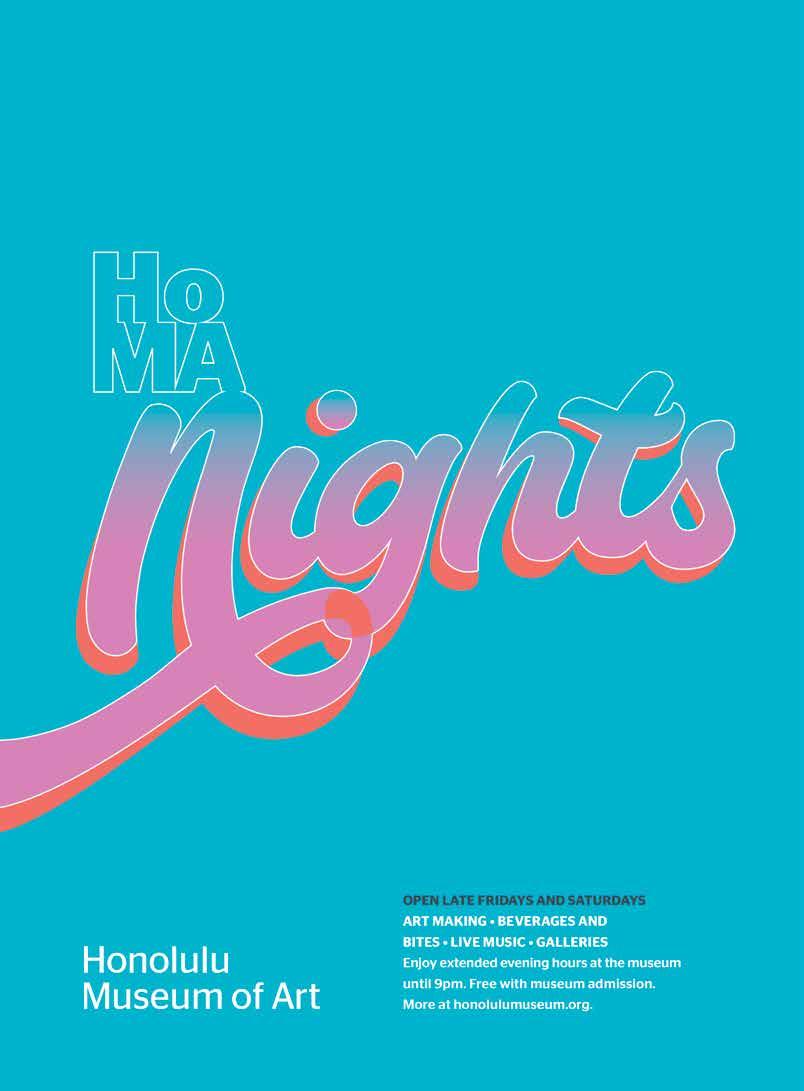
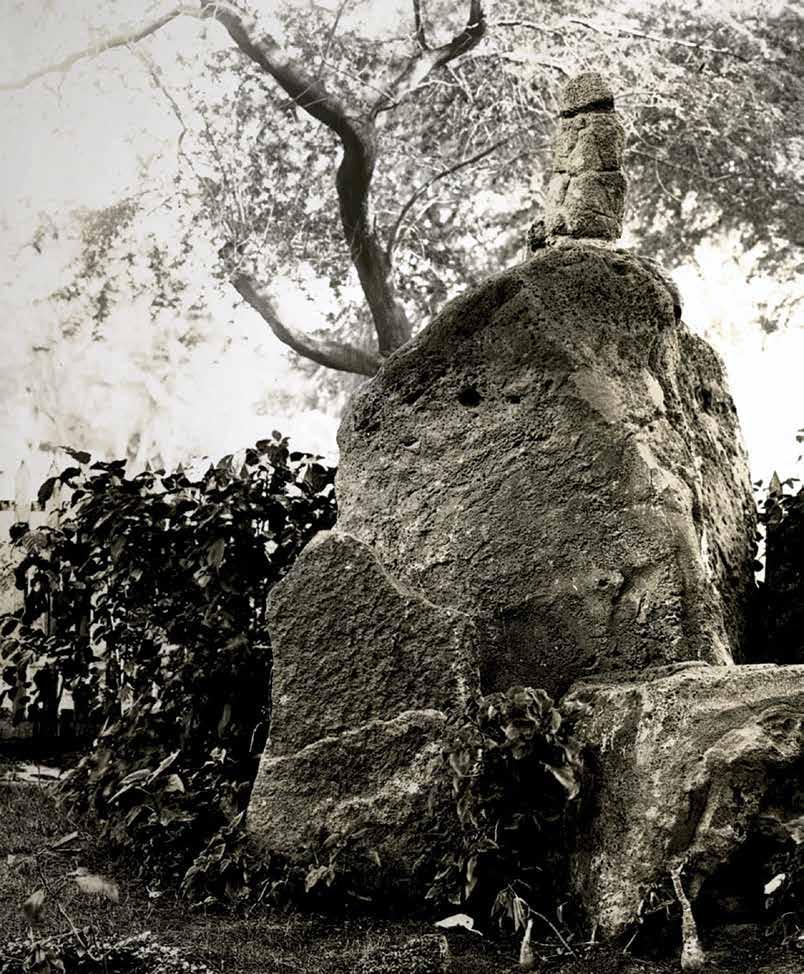 The healer stones of Kapaemahu, 1910. Image courtesy of the filmmakers.
The healer stones of Kapaemahu, 1910. Image courtesy of the filmmakers.
LIVING WELL
“There is something unexplainable and peculiar in the atmosphere at that place, which seldom fails to bring back the glow of health.”—Queen Lili‘uokalani
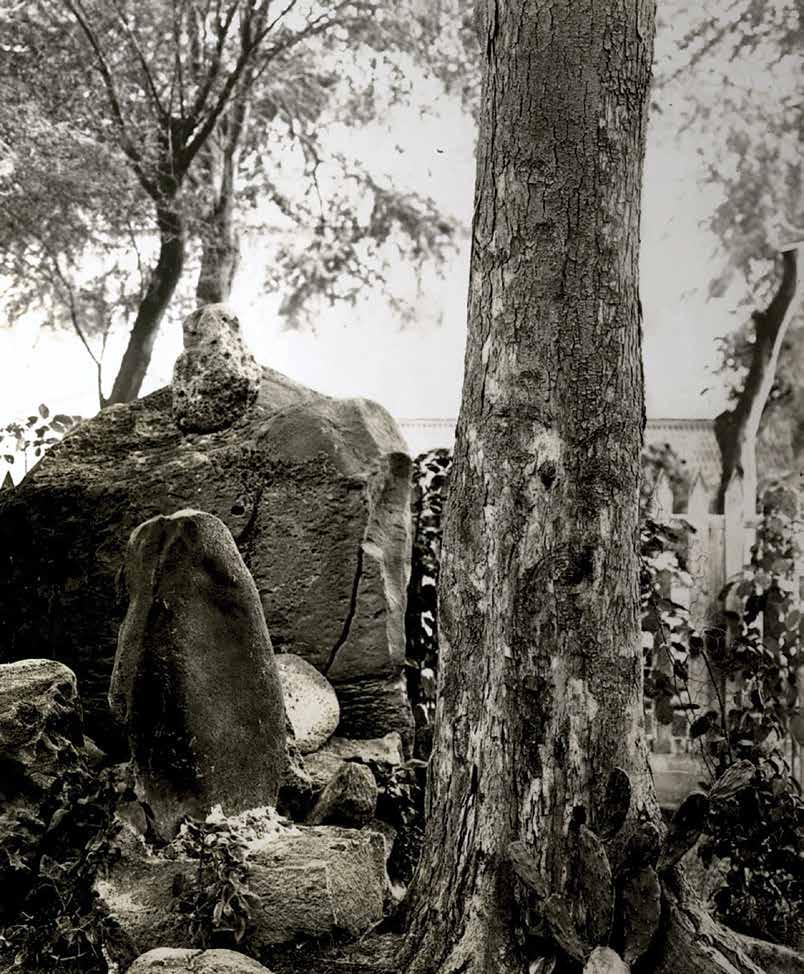
Memorializing Māhū
An ancient stone monument on Waikīkī Beach honors gender fluid heroes in Hawaiian culture.
TEXT BY KYLIE YAMAUCHI
IMAGES BY JOSIAH PATTERSON
Just off the sparkling waters of Waikīkī Beach and a kukui nut’s throw from Duke Kahanamoku’s bronze statue, a monument from precolonial Hawai‘i survives. Four boulders, originally excavated from the hills of Kaimukī, dwell together in varying natural shapes. Unassuming in appearance, the stones are erected on an ahu and circled by a low steel fence, passed unnoticed by thousands of locals and tourists daily.
I, too, am guilty of such cultural blindness. After countless surf sessions out at Canoes surf break, as I waited for my dad to finish showering, I often rested on the grassy patch in front of the monument to avoid the bustling crowds and sticky sand. Oblivious as the pigeons that nestled on their sun-soaked surfaces, I never took the time to read the plaque that told of the stones’ significance. Yet, thinking back, there was always evidence of the stones’ reverence, however few at the time: a crinkly and browning tī leaf lei draped over the fence, its braid still tight from skilled hands; a freshly-bought purple orchid lei laid to rest on the ahu.
As the mo‘olelo goes, long before Queen Lili‘uokalani and King David Kalākaua each ruled the Hawaiian Kingdom, long before the first Western missionaries disturbed these sands, four travelers from Tahiti arrived humbly and with pure intent. Their names were Kapaemahu, Kapuni, Kinohi, Kahaloa, and they were healers, each with a distinct touch. They were, also and foremost, māhū—a fact censored over time by Western influence and its confining notions of gender. A term unfamiliar to most Westerners, māhū is derived from Pacific Islander cultures which describes a person of dual male and female mind, heart, and spirit. Closely related to two-spirit identities of Indigenous communities, māhu points to a cultural acceptance of and respect for gender fluidity, attitudes withheld toward trans people today.
These four māhū healers were “tall and deep in voice, yet gentle and soft-spoken,” as recounted in the animated short film Kapaemahu (2020), and kindly accepted by the Hawaiians to whom they offered their services. Already highly spiritual beings for their ability to access both male and female parts of themselves, the visitors performed magical feats of healing on the community from Ulukou in Waikīkī, looked over by the crater of Lēʻahi. The healers were generous and passed on their knowledge to the Hawaiians, who in turn created a monument for them before they departed. Inch-by-inch the people dragged the stones from the hills of Kaimukī to the sands of Ulukou, where an extended ceremony took place under a changing moon. Over the course of a full moon cycle, the healers
As centuries went by and Hawai‘i transformed, the Kapaemahu stones remained in Waikīkī, gifting the place a spirit of healing. Opposite, kumu Hinaleimoana Wong-Kalu at Kapaemahu.
FLUX LIVING WELL | KAPAEMAHU | 144 | FLUXHAWAII.COM
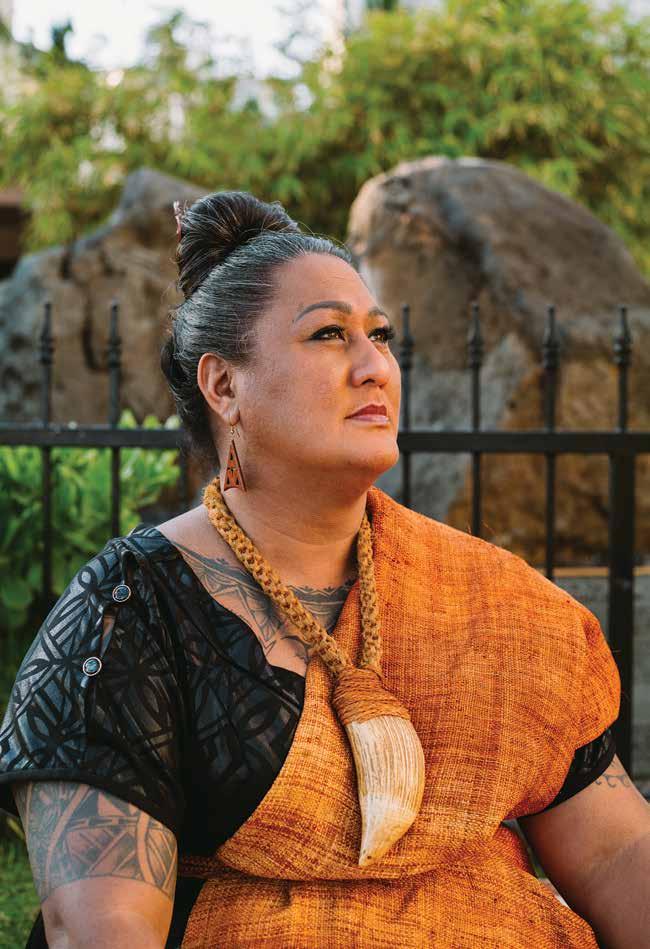
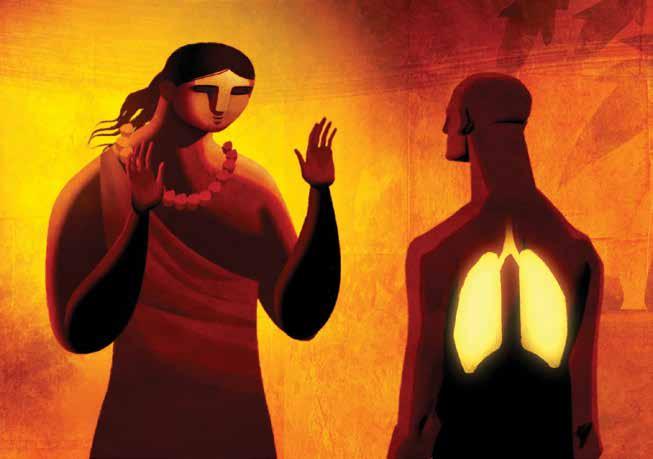
chanted an ‘oli over their respective stone, transferring their mana into the monument, before disappearing.
As centuries went by and Hawai‘i transformed into a city unrecognizable, the Kapaemahu stones remained at the center of Waikīkī, giving the place a spirit of healing. Most notably, Queen Lili‘uokalani knew the mo‘olelo of the stones and experienced their power. After being injured in a carriage accident, she spent time at Hamohamo, an area which adjoins Ulukou. “Hamohamo is justly considered to be the most life-giving and healthy district in the whole extent of the island of O‘ahu,” she wrote. “There is something unexplainable and peculiar in the atmosphere at that place, which seldom fails to bring back the glow of health to the patient, no matter from what disease suffering.”
Although ali‘i such as the Queen and her niece Princess Ka‘iulani often resided in Waikīkī, it remained a place welcoming of all maka‘āinana. All Hawaiians could harness the healing powers of the stones, if they so believed.
Although as time went on, the knowledge and existence of the stones were put at risk of erasure. In 1941, the stones, once revered and protected by the ali‘i family of Princess Ka‘iulani, were covered over by a bowling alley. It wasn’t until two decades later that they were rightfully restored to Ulukou, but the mo‘olelo had become esoteric and censored.
“Growing up, I remember those very stones were the ones that we played on as children,” recounts kumu Hinaleimoana Wong-Kalu, Native Hawaiian teacher and co-producer of Kapaemahu. “We climbed on them and laid on them in the sun after swimming the day at Waikīkī. We had no knowledge of their significance. We had no knowledge of their importance.”
Although Wong-Kalu was fortunate to learn the mo‘olelo when she was 18, a narrative integral to her own journey as māhū, many other Hawaiians, locals, and malihini remain unaware to the stones at the heart of Waikīkī. For this reason, WongKalu and filmmakers and life partners Dean Hamer and Joe Wilson produced
Kumu Hinaleimoana Wong-Kalu, filmmakers Dean Hamer and Joe Wilson, artist Daniel Sousa collaborated to create the animated short Kapaemahu . Still courtesy of the filmmakers.
146 | FLUXHAWAII.COM
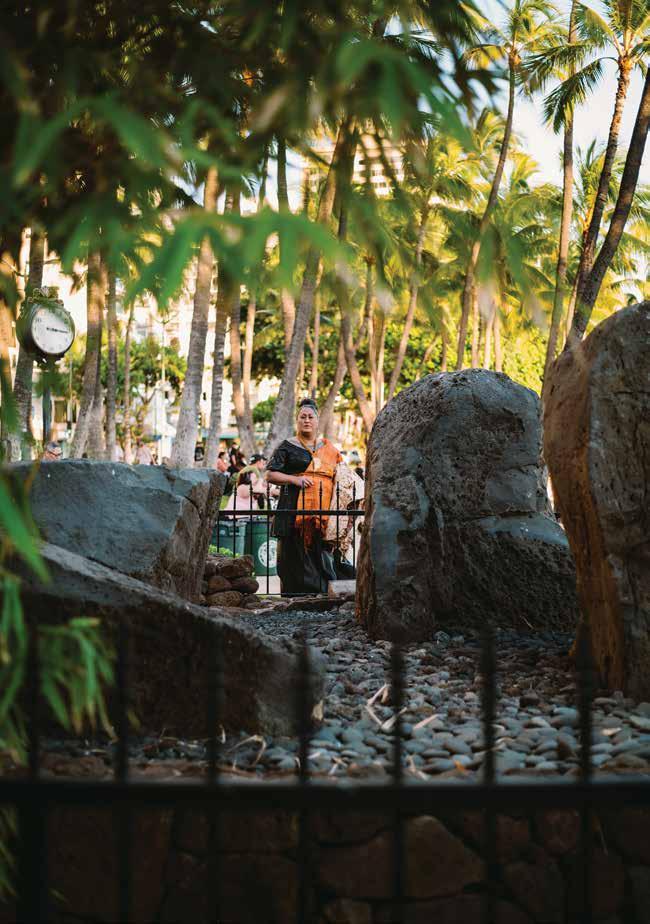
147
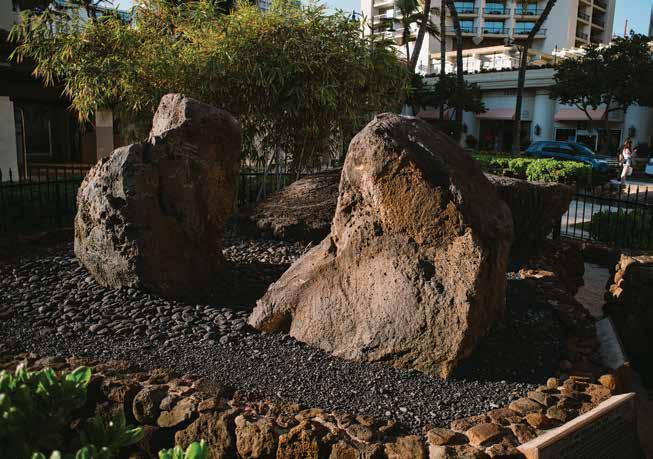
Kapaemahu, an animated retelling of the mo‘olelo told in the Ni‘ihau dialect that was most likely spoken by the māhū healers. Through the artistry of animator Daniel Sousa, the film is bathed in earthy colors and told through soft and unadorned figures, modesties which underscore the magic of the narrative.
“Dean, Hina, and I all emerged in a society that was not only negative but cast aspersions toward people like us that made our walk even more difficult,” Wilson explains. “When we learned about this site, these stones, and the story it reflects, we saw the potential it had to be one of those amazingly powerful symbols, not just for people in Hawai‘i but for people who visit Hawai‘i, who could start to see a place for themselves in the world through this mo‘olelo and site that celebrates this aspect of life.”
Although Waikīkī is much changed since Kapaemahu, Kapuni, Kinohi, and Kahaloa first brought healing to the community, their mana lives on in the stones,
in every retelling of their mo‘olelo, and every māhū who proudly lives their truth. Consider their presence as an invitation to venture a few short blocks along Kalākaua Avenue and visit the stones of Kapaemahu with the same humility and pure intent as those healers once showed us.
The knowledge and existence of the stones faced erasure and suppression for many decades, but has recently been revived.
Learn more at The Healer Stones of Kapaemahu exhibition at Bishop Museum running through October 16, 2022.
148 | FLUXHAWAII.COM

Cerulean
POEM BY M. KALEIPUMEHANA CABRAL
ART BY PŪLAMA LONG
When I was a kid, I used to steal the cerulean crayon from school. The way its color spread over the page reminded me of home, all the deep blues of Hawaiʻi.
For as long as I can remember, my wardrobe and accessories have been dominated by all hues of blue, rebelling against the pink tones so frequently pushed on me. Blues like cerulean brought me comfort, a shade that kept me safe.
I forgot about that crayon for many years, until I finally found out how to say its name. I had always said something along the lines of "Sarah lean" in my head and felt silly for never looking it up. But maybe it was meant to be that way, even the pronunciation being my own.
Like lovers, this tone came in and out of my life — meaning more on certain occasions than others. One lover found me a crayon again. She showered me in cerulean until we parted. Another lover hid it from me, shaming me for my bright wardrobe. With another lover, it was the shade I saw when we kissed.
Cerulean has found me (in) all kinds of love, the romantic kind, the family kind, the ʻāina kind. From wai to kai, I see her everywhere now.
Cerulean wraps me up in the deep ocean, and kisses me in flower petals. She cloaks my genders and paints my peace. Cerulean is my true love, the color of my ahupuaʻa.

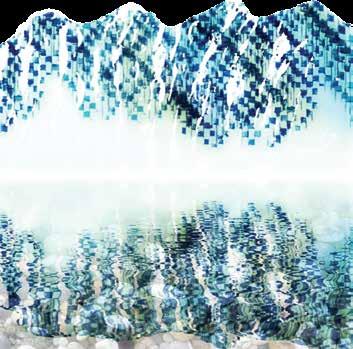
M. Kaleipumehana Cabral (Pumehana) is a nonbinary queer Kanaka whose work focuses on writing, film, education, movement, and social justice. They can be found organizing QTBIPOC community spaces, out in the ʻāina, or at @queerkanaka.
Pūlama Long is a Native Hawaiian cultural practitioner of ulana lauhala. Visit honihala.com to see more of her artwork and upcoming workshop opportunities.
| A HUI HOU | 150 | FLUXHAWAII.COM
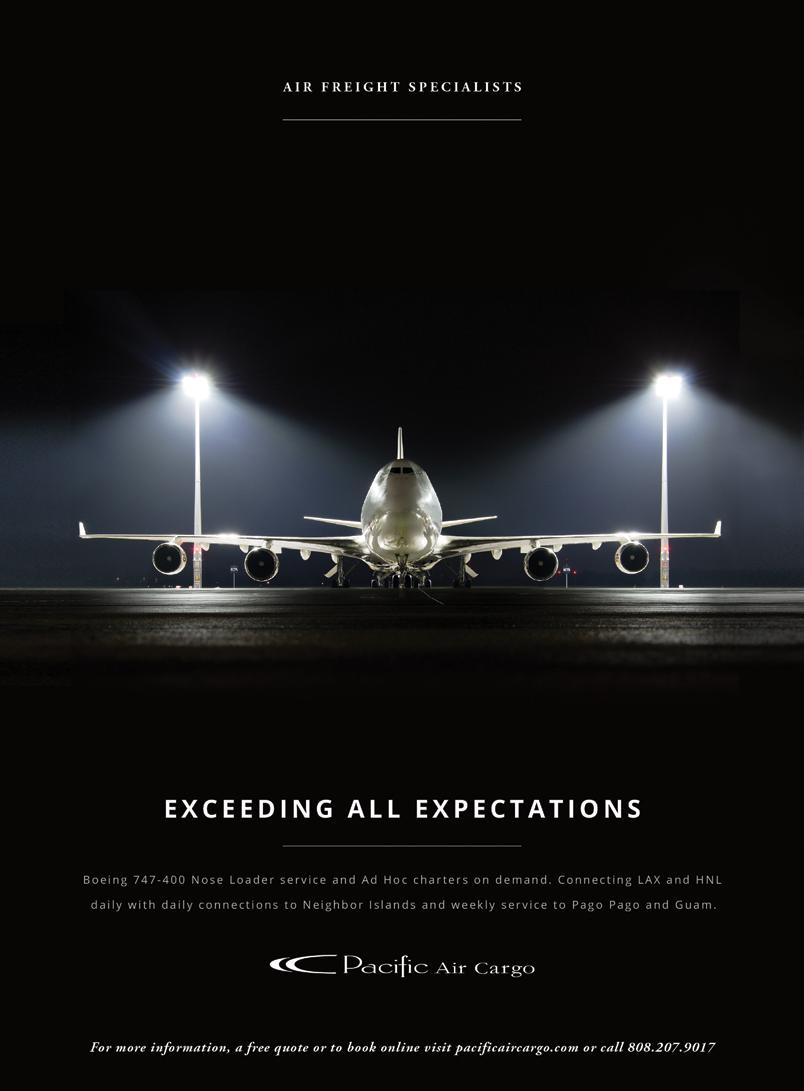





























 Scene from I Was a Simple Man . Still from Christopher Makoto Yogi.
Scene from I Was a Simple Man . Still from Christopher Makoto Yogi.




 “Gordon in Flora.”
“Gordon in Flora.”
 “Dibujo Nocturno.”
“Dibujo Nocturno.”













 Naone was introduced to weaving as a teenager in the Nā Pua No‘eau cultural enrichment program run by the University of Hawai‘i. Opposite, Piko Hīnano pāpale on Keanu Wilson
Naone was introduced to weaving as a teenager in the Nā Pua No‘eau cultural enrichment program run by the University of Hawai‘i. Opposite, Piko Hīnano pāpale on Keanu Wilson










 I Was A Simple Man , written and directed by Christopher Makoto Yogi, is set in the pastoral countryside of the north shore of O‘ahu, Hawai‘i. Told in four chapters, an elderly man facing the end of his life is visited by the ghosts of his past.
I Was A Simple Man , written and directed by Christopher Makoto Yogi, is set in the pastoral countryside of the north shore of O‘ahu, Hawai‘i. Told in four chapters, an elderly man facing the end of his life is visited by the ghosts of his past.



 A view of O‘ahu’s west side. Image by Josiah Patterson.
A view of O‘ahu’s west side. Image by Josiah Patterson.

 TEXT BY JACK TRUESDALE
ART BY SEAN CONNELLY & KEKAHI WAHI
TEXT BY JACK TRUESDALE
ART BY SEAN CONNELLY & KEKAHI WAHI





















 FLUX FEATURE
FLUX FEATURE










 FLUX PORTFOLIO
FLUX PORTFOLIO













 Fishers of Hānā, Maui. Image by Kevin Brock.
Fishers of Hānā, Maui. Image by Kevin Brock.



















 The healer stones of Kapaemahu, 1910. Image courtesy of the filmmakers.
The healer stones of Kapaemahu, 1910. Image courtesy of the filmmakers.








